Spring 2018
Greetings colleagues. A brief update for the week of May 7-11. This will be the last message for this academic year. The weekly messages will be on hiatus until we begin again this fall term. But, if something of critical interest comes up, I’ll send out a global email at that time.
- On Friday, Joan and I purchased some great student art for holiday gifts. The pieces we purchased clearly demonstrated the talent of our students and the great job our art faculty are doing while guiding their efforts. The purchases supported the HU Art Club. Later on Friday, we hosted the faculty members who were recently promoted and or tenured. It was a very nice event at the University Residence. Sodexho did a great job catering the event. A photo from that event:
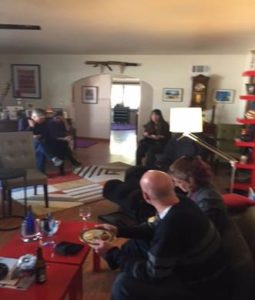
- The 2017-2018 Academic Year in Review: Here’s my take—in alphabetical order:
✔ Academic Affairs: We will submit the necessary paperwork to the HLC to obtain final approval of our MFA program as soon as we receive the letter from the HLC Board—assuming of course, the letter reads as we think it will read. The MFA is a terminal degree in that discipline and our program will quickly, I am sure, become a top program on our campus. We have strong faculty in that area, a state-of-the-art facility, and a great reputation throughout the state, the region, and beyond. I am confident that program will soar. Due to our probationary status, we were not been able to add any new programs over the past year, which is a real shame and has not allowed us to grow as we might have. This must and will change. However, there has been some growth. We recently graduated our first cohort of social work students from the Santa Fe Center and this year we also added some additional sections of social work classes to meet the growing demand. Also, in the Academic Affairs realm, we continued to push hard in our Learning Community Program, supported significant activity in regard to undergraduate research and other high-impact practices funded, in part, by our successful HIPS Campaign we successfully closed some time ago. We welcomed a new leader in Academic Affairs, Provost Gonzales, and she has brought new ideas, new energy, and a high commitment to HU and our students. We also selected a new Associate VPAA, Ian Williams, and he is a also doing a great job.
✔ Accreditation: This year, addressing the numerous accreditation concerns has been a huge lift for the entire campus. I have dealt with both institutional and specialty accreditors for many years and I knew we could collectively address all concerns, but I was a little worried about doing so in the allotted timeframe. That was particularly hard to do since some of the concerns required developing policies and getting them approved by multiple bodies here on campus. That always takes time and in some cases, more time than anticipated. Preparing the Assurance Argument was a huge task and hosting the Visit Team involved many people, many campus offices, and a significant logistical effort. Then, of course, there was the preparation for the IAC meeting, traveling to Chicago to meet with the IAC, and later responding to their report. As everyone knows, the recommendations from the Visit Team and the IAC were positive and we now await the final letter from the HLC Board. As I wrote, this was all a great deal of work. In addition. we devoted significant resources to this effort during a year when our institutional budget was cut. But overall, I truly think it was a positive thing for the campus. We had previously not established a goal in terms of our reserves and now we have one along with a plan to get us there. We were not careful about assessing all of our faculty and now we are. We claimed we had a broadly understood mission statement, but we really didn’t. Now we do. When it came to the assessment of co-curricular activities, we essentially did nothing. Now we do. I could go on. The bottom line for me is that addressing the numerous HLC issues the way we did it was a positive thing for the campus. Now, we must build on that momentum so these issues never happen again. That is my commitment. The way we addressed the HLC issues was a true enterprise effort involving literally hundreds of people. I’ve always said that there is sufficient intellectual power, passion, and commitment in most every institution of higher education to solve virtually any problem—if there is an enterprise commitment to doing so. From my perspective, this is what we collectively did—what we collectively accomplished. Of course, every initiative has a tip of the spear—someone who manages and leads the effort. We all owe Brandon a great debt for taking on a high-risk, extremely complex, incredibly time consuming, and sometimes thankless task. In my view, he is the model of faculty citizenship.
✔ Advancement: This year was a stellar year from our advancement team under the leadership of VP Law. We closed on numerous large gifts (e.g. the turf, Stu Clark, the first major gift to the Legacy Society, and others). Our alumni association is now active and doing great things. The most recent activity, HU @ The Zoo, was perhaps one of the largest alum events we’ve sponsored in some time. Perhaps a bit under the radar for some faculty members and staff, but absolutely critical nonetheless was the finalization of advancement policies and procedures, cleaning up our accounting so we are operating in a modern and fully professional manner, and getting a handle on our large and valuable art collection. There were some significant changes in the H Club leadership and it has been a pleasure to work with those strong HU supporters—people are really working together to the benefit of the institution. Lots of ideas are on the table and not everyone agrees with all of them—who on earth would expect that anyway?—but issues are worked out for the benefit of the institution as a whole. That, my friends, is the way to get to excellent.
✔ Athletics: This last year was a good one for our athletic department. We were faced with an existential threat in our athletic program when we were informed that football and soccer contests might not be permitted here—unless we replaced the turf. That was done thanks to a generous private donor. Our teams provided many exciting moments on the field, court, or track culminating in a great RMAC championship—our wonderful women’s outdoor track and field team.
✔ Executive Team & Other Personnel Matters: As you have noticed, I am sure, most all direct reports to me have been changed since my arrival in 2015. That was not my plan nor am I necessarily concerned about it—I have always and will continue to always make personnel changes on the basis of what I think is in the best interests of the organization. I have replaced the Provost, the Dean of Students, the Vice President of Advancement, and three of the four deans. About two years ago, I named a new executive—the VP for Strategic Enrollment Management, and he continues to work very hard to achieve our enrollment and retention goals. Today, I am very pleased with the team. In my view, they are functioning as a high-level team, free and open in their recommendations to me, and good servant leaders to the institution. I have also been very pleased with other recent hires. New personnel in HR, the Business Office, Procurement, Recruitment, and other offices have, in my view, vastly increased our professionalism, service to students, and overall outcomes. I know there is always room for improvement, but I am very pleased with the trend line. Emerson once said, “Every institution is the lengthened shadow of one person.” That may have been true in the mid to late 1800s, but in 2018, the world is pretty darn complex. Individuals always matter in every organization, but strong teams are more important than the shadow, lengthened or otherwise, of a single person. As is true every year, this year saw the exit of many of our colleagues who have contributed so much to HU over time. At the risk of leaving some people out, I think of how much I’ll personally miss Bill Taylor, Carol Linder, Dick Greene, and Tom Ward. Fortuna Bona my colleagues. May the next phase in your life journey be filled with great adventures, good health, prosperity, great books, good music, memorable films, to die for meals and libations, spiritual growth however you choose to define that (or not) , long (and short) walks in the woods, happiness, streams filled with trout and a back cast that never hangs up in a tree, and peace. Thank you for your many contributions to HU.
✔ Facilities: In addition to the turf replacement we completed a major renovation of Stu Clark. It really turned out great—on time and within budget. We also began the major renovation of Rodgers and I think that building will really turn out great. As I think everyone knows, the first floor will include a modern classroom so we’ll have students going in and out of the building. Also on the first floor will be a conference room and what we are calling an HU Heritage Room—a place for campus visitors and others to have a cold water or a soft drink and see some of the history and contemporary activities going on here at HU. I have been involved in many moves over my career including a memorable situation when I was in a trailer that facilities hooked up and moved—while I was in there. They did not know I was in there, but then again…they didn’t check so that’s how things were handled on that campus. My point is this—the move out of Rodgers to other campus locations has been exceptionally well planned and smooth. That’s not always the case and I am appreciative of it. We also secured a number of very impressive pieces of public art, which will be installed over the summer and perhaps into the fall.
✔ Fiscal Affairs: It was a rough year for funding. Early this academic year, all of our funding—100%—was cut by the governor. It was reinstated, but wow…what a challenge. The institution took another cut from state government and our other source of revenue, enrollment, was also a problem. As you know, we were required to inform every single student we tried to recruit this year that we were accredited, but on probation with our accreditor. In sum, we really struggled in the fiscal domain. On top of all that, I felt essentially forced to devote whatever it took to address all HLC matters and believe me that was a tidy sum. Still, through careful budgeting and a watchful eye on spending, virtually all of our employees received some type of compensation increase this year—one of the few institutions in the state where that happened. Plus, none of our employees were furloughed or let go—again, unlike several other institutions. We were able to benefit our staff members with some additional time off around the holidays. This year’s state fiscal situation was quite a dramatic change from last year and the new fiscal year budget reflects that change. Largely due to improvements in the extraction industry, reserves have been restored to state coffers, colleges and universities received a modest increase over the previous year (but still less than where we were a few years ago), and the legislature approved a modest increase in compensation for state employees. That’s all good, of course, but…extraction, the most significant driver of the state economy…is devilishly cyclical. It goes up and down, often drastically, in a matter of weeks and is highly influenced by variables including geopolitics totally beyond our control. My point here—what goes up will come down and our high reliance on state support puts us at risk. Still, the combination of some new dollars from the state and a modest tuition increase will allow us to do some new things this coming year. We must devote more resources to our reserves. And we will. We must critically examine the opportunities we have to grow programs currently attracting students. We’ll do that. We must think carefully about what new curricular offerings and or modes of delivery will serve our students and add to our enrollment, then fund those things as we can. We’ll be able to do some of that. We need to do some improvements on our web presence and add to our marketing budget. We’ll be able to do some of that this coming year. Bottom line—we’ll make to make some forward progress this coming year. I implore you to help me make the best possible choices with the limited resources we have.
✔ Recruitment and Retention: Our Division of SEM faced many challenges this year. Most notably, as previously noted, was the fact that we were required to try to recruit and retain more students while simultaneously informing them of our probation status. That’s tough to do. And yet, there is reason to be hopeful. We have some very dynamic people working in that domain now and new and modern tools to reasonably compete for students. Our engagement with an external firm is now over and we are basically flying solo—doing the hard work of recruitment and retention on our own. In sum, recruitment has been reengineered the way I know how to do it. Improvements will continue to be made in the structure of our SEM unit over time, but we are basically there. Now, we must implement all this and perform at a much higher level.
✔ Student Affairs: It was a good year in the area of Student Affairs. The Arts@HU program was a great success this year culminating in a country and western concert that drew about 2500 people. We also had nice crowds for other Campus Life programs including the three performances (one free to local K-12 students) of the State Street Ballet. The HU Office of Outdoor Recreation had another good year, particularly with the skiing trips. One student recently shared with me that she was going to do her master’s degree here, in part, because her recreational expenses were so low due to our Campus Life initiative (especially skiing). These various activities have brought some increased economic development to Las Vegas and we received some positive press around that. One of our club sports—men’s rugby—will once again compete for a small school national championship. Everyone loves our Vatos. Not exactly tied to Student Affairs, but we hired a part-time Title IX officer this year and he has already assisted with several investigations formerly led by the Dean of Students and or our HR Department.
✔ And finally, my self-assessment on …me (this one is not in alphabetical order). I was pleased that the board extended my contract this year thus allowing me to continue to serve HU as the best servant leader I can be. I’ll be here for the HLC interim process and the next full blown visit. For the first time in my life, I know what my last working day will be and I have to say that is a strange experience for me. This last year for me personally has been a really good one. I love HU. I love our mission. I love working with so many good colleagues who share my commitment to students and doing what can be done—even if it is just a little—to make the world a better place. I got up each morning this year ready to do what I thought was best at the time knowing full well that the information I had about an issue was never complete. I have tried to embody the servant-leader credo of—serving HU—not thinking that the organization would serve me—and making decisions accordingly. Joan and I like living in Las Vegas—such a rich and interesting and complex mix of architecture, cultural traditions, and people.
Consistent with updates from Lake Wobegon, that’s my report from Las Vegas where HU’s outcomes are always above average (or aspire to be), where it is increasingly difficult to find a place to park around the Plaza (a good thing), and the favored condiment comes in two colors and one temperature…hot.
- Our Advancement Team continues to do great work. This week alone, we received donations for several endowed scholarships and a $25,000 gift to one of our athletic programs. Also, we received a $20,000 gift for our Media Arts program. Well done to all faculty and staff who made these things happen. When faculty and those from Advancement work together—good things happen.
- On Tuesday the Executive Management Team met and as usual, we began the meeting with a brief discussion around something everyone read—this time, an article about approaches to leadership (go to: http://www.ehstoday.com/safety/do-you-lead-your-head-your-heart-or-your-hands). Basically, the article is about how different leaders approach their work—a clear-eyed rational approach (leading with the head), an approach dominated by emotion and making certain everyone is OK (leading with the heart), or simply getting things done—often doing it mainly alone (leading with hands). The author of the article asserted that each approach has advantages and disadvantages. Leading with the head might get things done, but sometime others can feel left behind and not “heard” as much as they would prefer. Leading with the heart might also get things done. That can happen. But sometimes the discussion goes on and on and really very little gets done at all. Kind of like the old saying—when all is said and done—more will be said than done. Leading with hands can accomplish things, but if you over rely on your own talents to get things done (even if you are successful), you might squander some of the talent embodied in other leaders in the organization. After a brief discussion, I passed out a little matrix and asked members of the team to rate how they saw other members of the team in regard to these three traits. I should note that everyone with one exception saw me as leading with the head. One and only one person said “heart” and a few people even asserted, “See, you are really heartless.” Ha. Ha. Very funny. I won’t divulge how other members of the team were perceived, but overall, it was close to 1/3, 1/3, and 1/3, which strikes me as a good mix for the team. We also heard from the Diversity Task Force and learned of their interest in doing a campus survey focusing on various diversity issues. We agreed to support that effort by word and deed. The meeting ended with a discussion of commencement seating (who will or should sit where—the symbolism at these events can be extremely important to some people) and the Foundation’s use of funds policy and procedures. Finally, Roxanne announced a new and very nice award from LANL to support a GIS initiative.
- As I previously noted in a weekly message, the Vatos will once again compete for a national title in Philadelphia. The tournament begins June 1 and Joan and I along with several other HU supporters will attend and root for our student athletes. A quote I heard once about rugby, “Football is a beastly game played by gentlemen; soccer is a gentleman’s game played by beasts; rugby is a beastly game played by beasts.” If the Vatos prevail, we’ll do another photo like the one previously shot (below). I should note that a couple players had to help me up after kneeling so long (sigh):
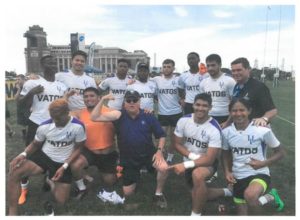
Photos of the teams competing for the national championship:
- My favorite events of the year—commencement—have already started at HU. All the hard work, all the challenges, all the time effort and energy culminates in that walk across the stage. Lives change that day and it is a great honor to be an even small part of that. This week, approximately 939 undergraduate and graduate students will experience that life-changing event when they graduate from HU. Congratulations to them…congratulations to their families and friends…congratulations to the faculty and staff who helped make it happen…congratulations to us all. Paraphrasing from another university president’s graduation comments, “Ability, motivation, and commitment are distributed throughout the population. Opportunity is not.” It is such a privilege to do what we can here at HU to provide those opportunities to our students. We called each student scheduled to graduate to confirm her or his participation and to make certain which ceremony they would attend. As you might imagine, we had to leave many messages, but we tried nonetheless. We certainly want as many students as possible to attend their graduation. Last night, Joan and I attended the Phi Kappa Phi initiation before commencement at Rio Rancho. It was such a nice event and the pride of those initiated and their families was obvious to all. Later, we held the commencement event in Rio Rancho. It was a wonderful graduation—very well attended and extremely well organized. It was touching, really. Photos of the Phi Kappa Phi event:
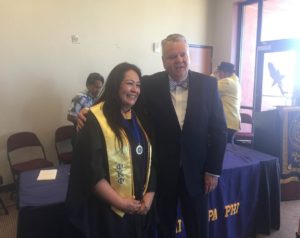
- Brandon continues to meet with Ian and Lee to make for a smooth transition of HLC duties and activities. I am really appreciative of how this has worked out. The way we are doing this transition maximizes the chances that nothing will be lost in the process and we won’t find ourselves scrambling to get something together at the last minute. It has been a smooth and orderly transition. As it should be.
A few favorite quotes from the week—this one’s from Jordan Weissmann writing in The Atlantic:
“Here’s a little known fact: With what the federal government spent on its various and sundry student aid initiatives last year, it could have covered the tuition bill of every student at every public college in the country. Doing so might have required cutting off financial aid at Yale, Amherst, the University of Phoenix, and every other private university. But at this point, that might be a trade worth considering.”
One from the AAUP Redbook, “…educational institutions should afford full freedom for teachers to conduct research and publish their results.”
And one final quotation in a letter from FIRE, the Foundation of Individual Rights in Education, to then President Gordon Gee at The Ohio State University, “…the mere dissemination of ideas-no matter how offensive to good taste-on a state university campus may not be shut off in the name alone of conventions of decency.”
The Noble Piper says, “The end of the semester is upon us. Maybe it seems like a long one, but heh…a semester is like 105 weeks in Dog Years. Think about that my friend. A class that lasts 105 weeks. Count your blessings. Now, how about a treat? ”
Greetings colleagues. A brief update for the week of April 30-May 4:
- The Board of Regents met last Friday. I previously sent out an update from that meeting, but in the event you missed it…here it is:
Greetings colleagues. The Board of Regents met last Friday and passed several action items that better define and promote more transparency in some of the university’s policies. For example, the Board approved:
- a Financial Accounting Policy in the university’s Business Office to ensure our financial statements are accurate, consistent and fairly stated and our management reports reflect Highlands’ financial position and business activities,
- several student account receivable policies to establish guidelines for the collection of student balances,
- numerous cash management polices to provide standards for receiving, handling, recording, depositing, and securing funds and to provide a framework that establishes lines of authority for general oversight management and
- an updated policy for dual-credit students that better aligns with the state’s Administrative Code and provides better clarity for high school students taking courses at Highlands.
The Regents also approved a Business Office Handbook that will provide a streamlined overview of several of the office’s procedures such as grants, stipends and reimbursements. The Space Allocation Policy, originally scheduled as an action item for Friday’s meeting, was tabled until the July meeting.
As with every board meeting, the Regents took a deep dive into a selected topic. This meeting’s topic focused on the Pell Grant and financial aid. Vice-President Edward Martinez noted 92 percent of freshmen filled out the FAFSA, the first step in receiving Pell and other federal financial aid. Eighty-seven percent of transfer students are filling out the FAFSA. While not all students who apply will receive federal aid (9 percent of Highlands freshmen and 11 percent of transfer students who filled out the FAFSA did not), it is imperative given our mission and our focus on recruitment and retention to guide students toward these resources. I appreciate the efforts of our Office of Financial Aid and Strategic Enrollment Management for the work they do to help our students achieve a university education.
The Board also met in executive session to complete my annual review. I will receive the final copy of that review soon. I should note that over my career I have received the highest quality performance reviews here at HU. They have been more thorough, more carefully done, and more helpful than any other reviews I have received over the years. At a previous institution, I was asked to write my own review and place in in my personnel file. That is not helpful and did not and cannot lead to improvements. I appreciate the board’s attention to my performance review. We also said good-bye and thanks to several people who will no longer be attending board meetings on a regular basis. These individuals include Dr. Brandon Kempner, Dr. Tom Ward, Ms. Natasha Lujan, and Mr. Laird Thornton. Their assistance has been greatly appreciated and their wisdom and creativity will be missed.
- This past weekend was a busy one. A Junior Visit Day on Saturday, some of our students completing a very nice volunteer project in town, the alumni softball game, the Climate Awareness Symposium, and several musical events. I got to as many of them as I could, but simply could not attend all of them. A photo of some of our admissions staff at the Junior Visit Day where we greeted 25 high school juniors from Deming, Las Cruces, Rio Rancho, Tucumcari, and Las Vegas. Another photo of the Vatos after sanding and painting numerous flower boxes around town. This project was supported by Main Street de Las Vegas. Note the guy in the back. Not a Vato, but the always upbeat Bill Taylor who serves on the Main Street Board.
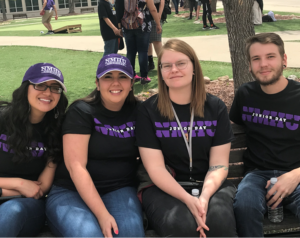
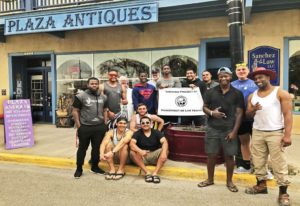
- I was informed this week by the formidable, enigmatic, and occasionally inscrutable Mike Petronis that he and five HU students will be attending a conference this summer in Germany. The meeting is related to his work supported by an NSF grant involving our strong geology and media arts programs. Mike is on the vanguard of providing incredibly powerful high-impact learning experiences to our students. The reality is—students may and probably will forget what happened in some 10:00-11:30 Tuesday and Thursday class during a certain semester of their university experience. They will probably forget what was on this or that test—things they “learned” (or maybe just tried to temporarily remember) in order to do well on the test. A recent study found that college graduates who had done well in College Algebra (a final grade of A or B) could not do many simple equations five years after graduating. But…the students accompanying Mike will never forget their personal and intellectual experiences in Germany. Never. And what impact will that experience have on them, possibly for the rest of their lives? No one really knows, but it could be huge. Thanks Mike for involving our students in these experiences.
- Congratulations to Coach Bob DeVries and our outstanding women’s track and field team. Keep calm everyone…the Cowgirls are the 2018 RMAC champs! Another banner to proudly hang in Wilson.
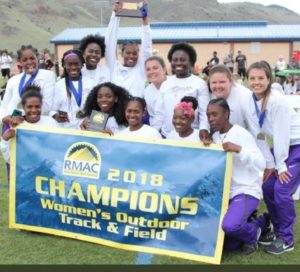

- On Tuesday I attended the Proposed Rule Meeting in Santa Fe regarding some changes proposed by PED. Essentially, PED wants to “approve” (or not) teacher education programs in New Mexico, thus adding another entire layer of complexity on top of specialty accreditation (CAEP) and institutional accreditation (the HLC). Most all the speakers at the meeting thought this was a really bad idea, a major over-reach by PED, and unlikely to really address the core K-12 issues in our state (e.g., 49th ranking on overall child welfare by the Annie Casey Foundation). That is to say, is our poor K-12 performance due to weak teachers coming out of our schools of education or is it perhaps due to other very poor state outcomes like poverty, health disparities, childhood hunger, etc.? However, most people at the meeting seemed to think this will probably happen. We’ll see where it all lands. Go here if you care to read more:https://www.abqjournal.com/1165766/criticism-mounts-on-ped-proposed-rule.html. Also on Tuesday, we held the last HLC Forum of the month. We provided everyone with an update of our relationship with our accreditor and shared impressions of the experience we had at the HLC meeting in Chicago. This was Brandon’s last time leading the HLC monthly meetings. We all thanked him for his high dedication and leadership.
- On Wednesday, I held my last Coffee With The President event of the academic year. I updated the campus on events, victories, and challenges in the areas of academic affairs, advancement, athletics, facilities, and others. Thanks to all who attended this event at a very busy time of year.
- I am very pleased to announce that Dr. Denise Montoya will serve as the new President’s Leadership Development Program Fellow for 2018-2019. A strong group of applicants applied for this program and Denise really stood out as exceptional. I have supported similar programs at numerous universities and participants have gone on to assume positions as chancellors, presidents, provosts, deans, and others. Good and courageous leaders are always in short supply, but given the many challenges we face in higher education, they are perhaps needed more now than ever before. Please join me in congratulating Denise as she takes the next step in her leadership journey.
- One of our good colleagues shared an interesting YouTube video with me. If…just suspend disbelief for a bit…if…technology does truly result in better, faster, more efficient teaching and learning and all of that moved out of the realm of opinion to fact…what would or might or should the role of the teacher, as we define that now, look like? How would things change? If you care to see the brief video, go to:https://www.youtube.com/watch?v=7vsCAM17O-M&t=26s.
- On Friday, Joan and I will welcome our colleagues recently promoted in rank and or awarded (or I should say, earning) tenure. Academic promotions and moving to tenure status are special professional accomplishments and worthy of celebration. This is perhaps more true now than ever before. If you are a full time faculty member on the tenure track or tenured, you are in a distinct minority. Most undergraduates in American universities are not taught by tenure track or tenured professors and that is a major change since I began my own higher education career in a former century (ouch). Contingent faculty can be and often are great teachers, strong mentors to our students, and wonderful faculty citizens, but their ability to influence institutions of higher education is limited in some cases. Regrettably, colleges and universities have not made the same commitment to them we make to those on the tenure track (or tenured) and it would be foolish and I think unfair to ask them to make the same commitments to us made by those on the tenure track or tenured. So…..we’ll celebrate the high accomplishments of our colleagues recently promoted and tenured, thank them for their dedication to HU and our noble mission, and also celebrate the end of a jam packed week.
10.The renovation of Stu Clark is nearly complete and it turned out great—a real showpiece. Many thanks to Sylvia Baca who led the way on this project. Take a look: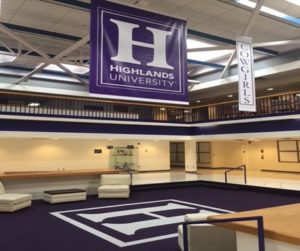

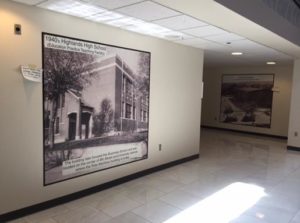

Quotes of the week: William H. McRaven, Chancellor of the University of Texas system, made some news this week when he announced he would be stepping down from his post after a short tenure. McRaven is a former military commander credited with, among other things, the successful raid against Osama Bin Laden. The man has clearly accomplished some tough things in his life. He said, “The toughest job in the nation is the one of an academic or health institution president.” I don’t know about that and I am sure there is no way to prove such a thing. An ACE survey of university presidents was recently completed and the top four things university presidents worried about were (1) money (mostly due to shrinking state support and decreased enrollment), (2) resistance to change, (3) lack of time to think and reflect, and (4) the belief that presidents are infinitely accessible. My personal list of worries does not quite match up to this one. For me, the list looks like this: (1) finances (I agree with the ACE list on that one), (2) enrollment (which is tied to finances—as enrollment goes down, so do resources available to the institution), (3) affordability (if trends continue, many Americans will simply not be able to attend university as we know it now), and (4) a growing perception that a university education is a private…not a societal…benefit (a justification for pushing the costs of an education onto the shoulders of students since allegedly, they are the beneficiaries—a position I absolutely do not support). Related to this quote and the naming of the Presidential Fellow for next year is something else I read from Mr. Dennis M. Barden, a Senior Partner at Witt/Kieffer—one of the most well-known search firms in higher ed. I have worked with Mr. Barden on both sides of the table—as an applicant in a search he was managing for an institution and as one who engaged Witt/Kieffer to help me fill a position—and he is truly a thought leader in the higher ed sector. In writing about selecting and supporting new leaders, Mr. Barden stated, “We must be intentional about preparing people for those top jobs. We must train them, and then give them meaningful experiences to put those lessons into action and to test their abilities before they are actually on the job. We must find ever more efficient and effective ways to choose leaders, and we must, in particular, become vastly more intentional about helping them to succeed once they take office.”
I also liked these quotes from a recent article I read in INSIDE Higher Education:
“Even at the very best [colleges], there’s a small portion of the population that’s committed to being miserable.”
“You can pretend to care, but you can’t pretend to show up.”
The Noble Piper says, “Here’s the secret to grading finals. Put the finals in piles of five. Dive in. Grade five and then take a break. Take me for a walk. Come back and grade five more. Give me a treat. Continue until completed—-grade five-walk. Grade five-treat. Before you know it, you’re done and I am one happy puppy.”
Greetings colleagues. A brief update for the week of April 23-27:
- I spent last Thursday and Friday at the Governor’s Higher Ed Summit. I was joined by Regent Marchi, Regent Marr-Montoya, Regent Vigil, Provost Gonzales, Mr. Baca, and Dean Lail. We all heard brief presentations by representatives from the Lumina Foundation, the Western Interstate Commission for Higher Education, and others. A few things said at the meeting (asserted as truth, no references or anything):
a. Since the Great Recession, 11.6mil jobs have been created in the United States. 11.5mil of them required some post-secondary education.
b. New Mexico is second in the nation in regard to the percentage of the state budget going to higher education.
c. Today, 13% of all college students take all of their classes online.
Some of these points generated lots of discussion, but the main topic of the meeting focused on higher education governance. As you know, here in new Mexico we have a very distributed form of governance. Schools have their own boards and act in pretty autonomous ways. Other states have fewer boards—maybe one for the research institutions, one for the comprehensives, and one for community colleges and still others have one and only one board. All schools are governed by that single entity. It is a little overly simplistic, but one main distinction between the models is that a distributed model allows each school to tailor their programs and services to their main service/catchment areas while fewer boards (or even one) might be able to focus more on major state wide goals like overall retention, graduation rates, etc. One person said that a single board can also focus on the performance of schools and presidents while local boards sometimes focus too much on the local community perception of the campus and or the “likeability” of the president or some other individual campus figure. That was kind of interesting and I am not sure it is true. It really isn’t in my own experience. Still others suggested that the whole focus on governance, number of boards, etc. was really ill advised. Many of our state outcomes—financial health, child poverty, health disparities, food insecurity, high school dropout rates, etc.—are really very poor. In fact, just about the only two areas where we shine are higher education tuition and student debt. We’re very low on both of those metrics, which is good. So—given our overall poor state level metrics—why are we focusing on whether one, three, or multiple boards are better than some other approach to governance? That’s an interesting question, but in all fairness, a few have suggested that it might actually matter. Some assert that our overall low performance metrics might be related to how focused we sometimes are on local or regional issues and concerns and a single board or fewer boards might help with that. I’m not sure about that, but I have heard the argument.
- I spent Monday at a Council of University Presidents meeting in Albuquerque. We heard from Mr. David Abbey, Director of the Legislative Finance Committee, Dr. Barbara Damron, HED Secretary, Mr. Andrew Jacobsen, Deputy Cabinet Secretary for HED, and others. Mr. Abbey reported that the state budget outlook continues to improve, but largely due to significant increases in extraction revenue. It is good we’re up, but as everyone knows, over-reliance on a single sector (extraction or anything else) means that we’ll continue to experience unstable revenue streams. Dr. Damron provided an update on the “trifecta” (e.g., road to 66, common course numbering, etc.) and an update on rulemaking that will be coming up shortly. Mr. Jacobsen talked a bit about the funding formula we employ here in New Mexico. The formula and the variables in the formula continue to be a subject of great interest around the state. There was also quite a bit of discussion about a recent news article asserting how mediocre higher education is in our state. According to the author, the main reason for our poor performance had to do with governance issues. Here’s the article:http://www.santafenewmexican.com/news/local_news/new-mexico-keeps-universities-in-hands-of-mediocre/article_c7038e6e-dbcf-512c-a619-c9b883f65d9f.html. I consider myself very fortunate to work with the regents I’ve known since arriving at HU. All of them—every one—have been selfless servant leaders of HU who dedicate their considerable time, effort, energy, and wisdom to this institution—for nothing in return. That has not always been the case in my experience at other schools. But, it has been a good and positive experience for me here. Clearly, issues related to potential mergers, the selection of regents, governance, and a few other issues will be at the forefront of discussions before and during the legislative session. Speaking of mergers, there was some national attention this week around a potential merger in Connecticut. There was move to merge all of the community colleges there into one entity and the accreditor said…no. Here’s the article: https://www.insidehighered.com/blogs/confessions-community-college-dean/perfectly-good-failure?utm_source=Inside+Higher+Ed&utm_campaign=bb41ca617b-DNU20180111&utm_medium=email&utm_term=0_1fcbc04421-bb41ca617b-198622925&mc_cid=bb41ca617b&mc_eid=1b6e1fa6ce. The bottom line for me….talk about mergers is easy, but actually doing it is tough and involves other entities including accreditors. They have to be convinced it is a good idea.
- Tuesday ended with the annual Student Government Gala. I wished the outgoing members of the student government farewell and welcomed the incoming students. I told the students about a new initiative we’ll try next year—HU@ The Roundhouse. Details are yet to be determined, but we’ll select a group of volunteer HU students and provide them with some training in leadership focusing on leadership at the state level. After the training, we’ll go to Santa Fe during the legislative session, hear from a few elected officials, observe the floor activity on the Senate and House sides, meet with elected officials as they are able to do so, and hopefully get a photo of the group with the new governor. We’ll see how this goes this fall…hopefully, it will become an annual event. The goals here are to provide our students with some high quality and hands-on leadership training while gaining some firsthand insight into how leadership works at the state level. Many thanks to Kim, Margaret, Sodexho, and others who made the Tuesday evening event happen. A photo from that event:
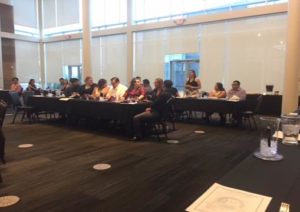
- On Wednesday, I participated in the Santa Fe Center graduation event at the Higher Education Center. This is such a busy time of year, but this event has quickly become one of my favorites. Each student who will graduate from our Santa Fe Center was individually honored. This year’s event was so well organized and so festive. The high point is always the student testimonials and this year’s stories were no exception. Many tributes were made to the faculty, the staff, the administration at the Center, family members and others. It was just such a great event. Many thanks to the Santa Fe Center folks for doing such a wonderful job with this, the faculty, staff, and administrators from the home campus who attended the event, and to Regents Marr-Montoya and Vigil for demonstrating their support by attending the festivities. Believe me, this photo does not capture the enthusiasm of our students or their families:
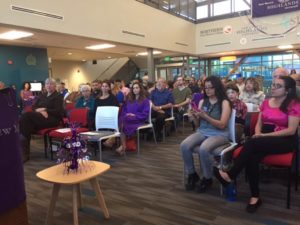
- Our Demand Builder senior search is complete and more than 700 high school seniors responded to our query. We are in the final phase of the sophomore/junior search and thus far, more than 2000 students have responded. Of course, this does not mean that we’ll get all of those 700 seniors…they are in the funnel now and we hope to yield as many of them as possible. This will be the last year we engage Ruffalo Noel Levitz to do this work. Afterward, now that we have the expertise, we’ll do it ourselves. In other SEM news, we will be taking the funds heretofore going to RNL to hire another recruiter—this one focusing on transfers. We are negotiating with some community colleges to actually have the recruiter there on site. About 36 Native American students and prospective HU students will be on our campus June 15-20 and students from the San Felipe Pueblo will be with us June 7 and 8. A Junior Student Visit Day will be held this Saturday. We are reaching out to prospective students in California who have quite literally been shut out of attendance at a school there. There just aren’t enough seats. We are recruiting them to HU touting our good value (combination of quality and affordability), low student to faculty ratio, very good first destination student performance (our graduates get jobs), and an interesting and fun campus life (skiing, hiking, etc.).
- Congratulations to Coach Moses and six Cowboy wrestlers who were recently named Academic All Americans. Three of our student athletes, Allen Michel, Jonathon Bechtloff, and Isaac Garcia, joined a select group of All American student athletes. Each student earned a 4.0 GPA. Only one other NCAA school had more than one All American wrestler with 4.0. Well done. Coach Moses and one of our student athletes and photos of Mr. Michel, Mr. Bechtloff, and Mr. Garcia—HU’s Academic All Americans:
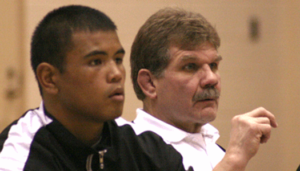
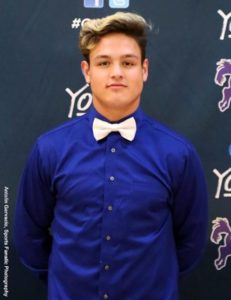

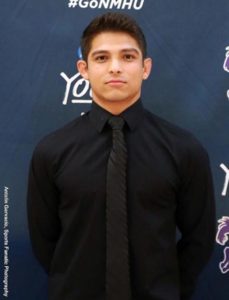
- I heard from Dick Greene this week who is finishing up his year in Washington, D.C. He is off to Egypt on his latest junket and also spent some time recently with Amazon’s Director of IT. He clearly continues to push a scientific agenda in the State Department and do what he can to advocate for HU. He hopes to see the Vatos play for the national championship in Philadelphia this year, but as he mentioned, his time “is not his own” right now. Dick also sent me a really interesting graphic. These days it is all too easy to think that the world is not improving at all…we are in some downward spiral. Given some of the things happening these days, I guess it is easy to understand that sentiment, but check this graphic out—so many fewer people in the world are living in poverty. So many more have access to basic education. So many more are literate. On an on. The world is getting better. I do recognize we face daunting problems, but this is encouraging, no?
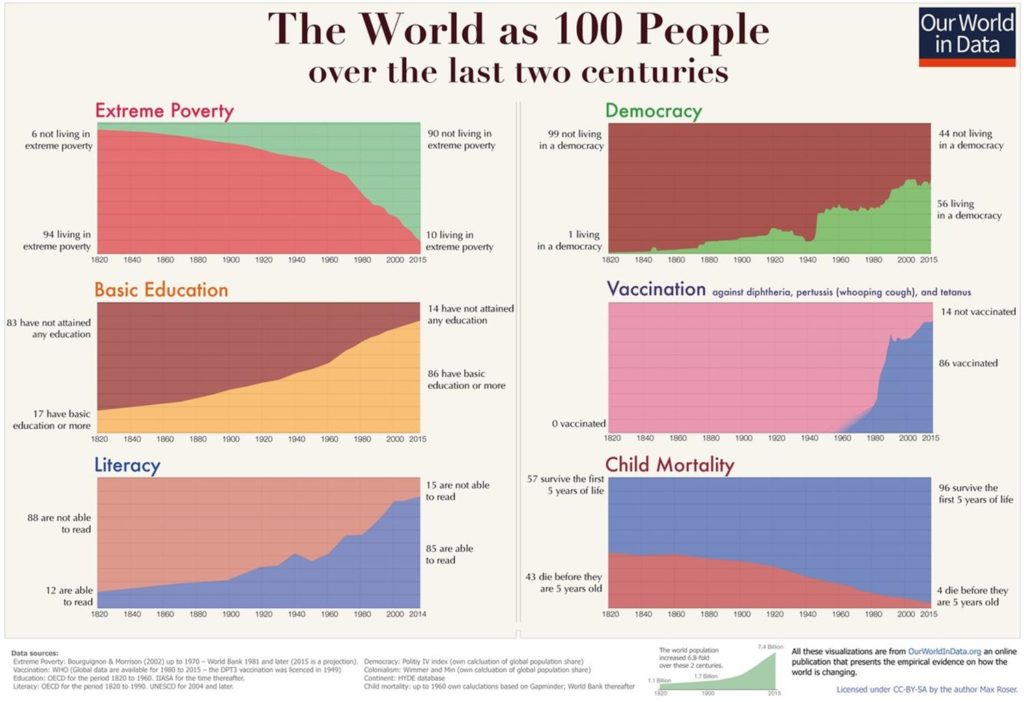
- Please attend the New Mexico Highlands University and the Las Vegas, NM Annual Climate Awareness Summit. The activities begin this Saturday at 9:00 a.m. A complete agenda is attached (above). Thanks to Linda LaGrange and many others for organizing this important event. Saturday will actually be a very busy day with this event, a Junior Visit Day on our campus, the Alumni Day Softball game, and a project to sand and repaint some of the flower containers around town. The Vatos will be helping with that project, which is sponsored by Main Street de Las Vegas. There is a concert on campus this Sunday, so as I wrote, a full weekend of activities.
- There is a board meeting this Friday and as I usually do, I’ll send out an email noting the actions taken at the board.
10.HLC Update: Our last HLC Campus Forum of the academic year will be held May 1 from 3-4 p.m. in the SUB. Those who attended the national meeting will provide a brief update and I’ll talk a bit about next steps; Please try to attend this meeting if you can do so. I know it is a busy time.
11.Quotes of the week: I received several excellent applications for the Leadership Development program for next year and I’ll be making an announcement about this soon. Reading applicant submissions got me thinking about the importance of leadership in our sector. In my mind, there’s kind of a disconnect going on. So many people assert that fewer and fewer people are interested in moving into higher education administration and yet…I also hear that most every administrative vacancy attracts lots of applicants. A regional comprehensive in our area is searching for a new president and more than 130 people applied for the job. One of my former colleagues applied for a dean’s job in what was really not an ideal location or anything and it still attracted more than 110 applicants. An external search for a chair’s position at a place I worked a few years ago attracted 74 applicants. That doesn’t sound like few people want those jobs. I think some of this might be due to a popular notion that administrative jobs are so hard and even impossible to manage these days. That is a popular story line and apparently lots of people like to talk and write about it. I don’t know why—it is not really an accurate portrayal of the job in my experience. But, I guess a narrative that few people are applying for administrative jobs fits the narrative of people who write and speak about how tough those jobs are. But as I wrote, my experience is not that few people desire those positions. Here’s a quote I read this week suggesting that administrative jobs are not attractive and or just too darn demanding. Again, this just doesn’t jibe with what I see in regard to the very high interest I see in virtually every administrative job that comes open.
“Many institutions are experiencing financial challenges, often stemming from a cascading decline in enrollments, and the data reveal that these challenges will persist. The number of college-age students in America will continue to decrease for the next several years and will not, in any foreseeable future, return to the numbers we saw before 2011. Growing concerns on the part of the public — fueled by some elected officials — that college is unaffordable and/or fails to prepare students for jobs may further dampen interest in college. The “travel ban” has discouraged many international students from enrolling at institutions in the United States. In response, to attract students, many colleges and universities have had to increase their tuition discount significantly, thereby reducing their net tuition revenue. In 2016, the average tuition discount exceeded 49 percent, compared with 38 percent in 2003. Institutions that once had prided themselves on collegiality are now divided over matters that previously had not been contentious, such as free speech and academic freedom. Campus events that would previously have been considered standard fare can now quickly become highly politicized and can even present safety concerns. Declining enrollments in the liberal arts have led some administrations and boards to make curricular decisions unilaterally that once had been the primary responsibility of the faculty. Salary and hiring freezes, layoffs and the closing of long-established programs have also led faculty and staff members to distrust presidents and trustees, sometimes those with whom they had once enjoyed positive relationships. And instead of looking forward to conversations with students, many presidents worry that such encounters will become contentious and uncivil occasions for students to demand large societal changes over which presidents have no influence.”
At the graduation celebration this week in Santa Fe, one of the graduates spoke for quite some time about the fact that she will be graduating from HU (the Santa Fe Center) with zero student debt. Her Pell and other grants couple with our affordable tuition and fees enabled her to graduate with no debt whatsoever. Frankly, you don’t hear that story too much these days even though I know it is sometimes true. Maybe often true. Her talk got me to thinking about a book I go back to over and over again—Higher Education in America, by Derek Bok, former president of Harvard University. I actually met him once while hiking to Borobudur, a Buddhist temple in Indonesia. I didn’t know who it was initially, but I got to talking with my hiking partner and I could tell the guy was really smart. Turned out to be President Bok. I learned more on that hike than many classes I took in graduate school. At any rate, this is from his book:
“Competition in most industries tends to lower prices. In higher education, however, what appeals to students, foundation officers, philanthropists, and other valued audiences is often not lower prices but higher quality, or what is commonly thought to be higher quality. And quality of this kind costs money, whether it be for more attractive dormitories and classrooms, bigger and better libraries and laboratories, or a faculty with larger numbers of highly esteemed scientists and scholars. As a result, the competition for students waged by many four year colleges give rise to constant pressure to increase tuition.”
The Noble Piper says, “Come on guys, take care of the earth. It is the only one we have right now. As they say…there is no Planet B. Think globally. Act locally. And take me for a walk, OK? I could also use a treat of some kind. Just saying. ”
Greetings colleagues. A brief update for the week of April 16-20—sent out a bit early since I’ll be out of town on Thursday and Friday:
1. Last weekend was a busy one with the Cinderella performances on Friday and Saturday. I was so pleased that the children from West came over to Ilfeld to see a Friday afternoon performance. This was totally free to the kids of Las Vegas. One of the students I talked to said her dream was to see a real ballerina…or a fairy or Taylor Swift. I guess one of her dreams came true that day. Joan and I attended the Friday evening performance and it was not sold out, but pretty close. It was also really nice to see local children performing with the professional troupe and the many smiles of parents, grandparents, and other family members. You could see the pride on their faces. A photo of the students from West awaiting the start of the performance: 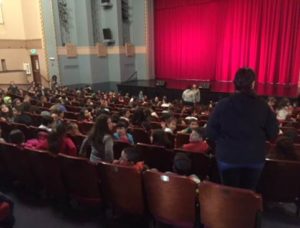
2. I spent Monday and Tuesday this week in Colorado Springs at the annual spring RMAC meeting. A number of important issues were discussed. Very soon, an NCAA report regarding changes in basketball will be released and that could have some implications for all programs including DII. This report is in response to some major and possibly criminal behavior in Division I. There may be some changes in regard to gambling on NCAA contests—it may be permitted in some states—and the NCAA may not be able to stop it. The RMAC will continue our engagement with Stretch Internet allowing people to view games online. Finally, I was elected to the Executive Committee of the RMAC. I consider it an honor to work with so many great presidents on policy and other matters to help student athletes achieve at high levels. Speaking of student athletes, Dean Bill Taylor shared a note from one of our alums. This individual played football for HU (all RMAC) and then went on to play a short time professionally—a dream come true for him. He recently entered the workforce as an accountant at a firm in California and wrote to his teachers and mentors in the Business Department to thank them for their support. A quote from his letter, “I cannot thank you enough…I remember in class back in 2015 when you said one day you guys are going to have an epiphany…and you’re going to get it and it’s not going to be confusing anymore. Well that day is today and everything is starting to fall in place!” This young man was able to continue to play the game he loved. He won high honors here. He played professional football. How many people achieve that kind of goal? Today, he has a great job and a great life. That, my colleagues, is the HU story…changing lives every day.
3. On Wednesday, we held our usual Executive Management Team meeting and started with a discussion of Performance Based Funding (PBF) in higher education. We read this article: https://tcf.org/content/report/why-performance-based-college-funding-doesnt-work/. Most states, including New Mexico, employ some PBF scheme. My personal take…performance based programs have an appeal. I mean….who doesn’t think that universities should perform at high levels? But, PBF done the wrong way can have a deleterious effect. Specifically, such programs can drive schools to NOT serve students who need the most assistance. Want to improve retention rates and graduation rates? Just admit good students and you’ll see your metrics go up. Everyone knows that. After a general discussion about PBF, Max provided everyone with an overview of how PBF works here in New Mexico. Believe me, it is pretty complex and unclear (to me) how many people really understand it. In my personal view, it is also hegemonic. It was a good discussion and I think people left with a little better understanding of how things work in our state. We also talked about the upcoming board meeting, the new member of the board (story to be released on that soon), and a few HLC updates. Finally, Max presented the HU Futures Task Force recommendation for his area and we had a general discussion about those. We’ll have one more HU Futures TF discussion (Academic Affairs) and then we’ll role things out for a broader vetting.
4. On Wednesday afternoon, we celebrated the high achievements of faculty members at a Faculty Excellence event in Kennedy. There was a very nice crowd and each faculty honoree was individually identified and thanked. As I said at the event, everything matters in any learning organization—the quality of the physical plant matters, how much you have in reserve matters, enrollment matters, everything matters. But, the thing that matters most—the main driver of outcomes in a learning organization—is the quality of the faculty. What they know and do matter most. And given the accomplishments of the faculty honored at the Wednesday afternoon event—I am very hopeful about our future. Many thanks to Ian, Roxanne, Sodexo and everyone who made the event a success. Also, thanks to all who attended.
5. Thursday and Friday will be devoted to a New Mexico Higher Education meeting in Albuquerque. I’ll hear some presentations from officials from the Lumina Foundation, Complete College America, the Education Commission of the States, and others. There will be a focus on the governance of higher education and specifically how that is handled or should be handled here in New Mexico. Changes in higher education governance do happen from time to time, but the move from a distributed system (each school having their own board) to a centralized system is almost always really painful. We’ll see if there are any meaningful changes in our state.
6. The Mighty Vatos won in Nashville last week and will once again advance to national championship play in Philadelphia. That will occur in early June. A photo of the Vatos and the team from Wabash…one of the teams our Vatos beat. Great sportsmanship all the way around. To advance to the finals, the Vatos beat schools like Vanderbilt and Duke.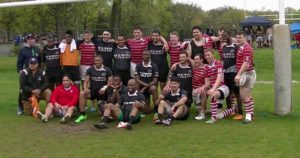
7. HLC Update: Many institutions have problems with their accreditor around the assessment of learning outcomes. There are better and worse ways to do that, I suppose, but basically all you really have to do is stipulate what you want your students to learn (e.g., knowledge outcomes, skill outcomes, and possibly dispositional outcomes), determine a way to measure all that, actually measure those constructs, review the results, and then make changes in an attempt to improve the results. It is supposed to be a continuous process and if it is done right, the whole thing can be pretty easy and embedded in classes. But, some disciplines do much more and things can get pretty complex. In an attempt to improve our assessment of learning outcomes, we’ll support several modest internal grants. Interested faculty in a given discipline will apply for support to improve the discipline’s assessment of learning outcomes. The details will be worked out between the Provost and the faculty and ideally, we’ll accept applications in the fall, 2018 and the projects will be completed in the spring and or the summer, 2019. Be on the lookout for details of this program and please consider working with your disciplinary colleagues to submit an application.
Quote of the week: In almost all the higher ed jobs I’ve had over the years, a “culture of busyness” has permeated the campus. This has been true for many staff, faculty, and administrators. For whatever reasons, people (including me, of course) have sometimes worked very hard to note how hard they are working. When I’ve asked colleagues how things were going, they often commented how crazy-busy they were, how they were barely keeping their head above water, and how their life was so frazzled. I do recall one faculty colleague who often said he was barely keeping his head below water, which is not funny if it was true. I think the ultimate example of this kind of thing was when I worked at another school where the president had a university car as part of her contract. She then purchased a personal car—same make, model, and color as the university vehicle—for the expressed purpose of convincing people she was always on campus, always working, and always very very busy. Wow…that says a lot about that person, no? I do not think I’ve ever heard any of my colleagues say something like, “I am doing fine. Busy, but not too busy. Plenty of time to enjoy my life.” That has never happened to me, but surely in some cases that had to be true. I certainly don’t think those of us in the academy are the only people who buy into the culture of busyness. I see that all the time in other jobs and professions. Why do people do this? Some have suggested that being very busy—or asserting that you are—is an attempt to signal high status. You are so darn important and so many people are counting on you, it is hard to keep up (for more on this idea, go to: https://www.huffingtonpost.com/jon-jachimowicz/being-busy-as-a-status-sy_b_6130220.html). Others have suggested and numerous studies have found that people say they are so busy these days because…well…they really are extremely busy. Faculty work, for example, has been studied many times and I think the consensus finding is that faculty on average work in the low 60s (hours) per week. That is a lot, but it is also true that professionals in other sectors work very long hours. I recently saw a survey that general practitioners work about 66 hours per week, new attorneys work about 60 hours or so with mid-career attorneys trying to make partner working about 70 hours, and small business owners working 70+ hours. I think people operating their own business work more than anyone else. So, lots of people are very busy. There may also be some cultural issues at work. For example, many Americans do not take vacations even though they are granted the time to do so. Others—I’ve heard it from other people living in other countries— are often critical of Americans for this kind of thing and can’t seem to understand why we are so driven to work (go to: https://www.nytimes.com/roomfordebate/2010/08/04/why-dont-americans-have-longer-vacations/the-vacation-gap-between-the-us-and-europe-is-wider-than-we-think). I’ve worked in countries where it at least appeared to me that people worked fewer hours than Americans…or seemed to. Did I notice any decline in performance? Not really. Plus, I’ve known some people who worked really long hours and it seemed they could not get anything done. They were always at work, but little got actually accomplished. The old, “when all is said and done, more will be said than done” idea. Another issue—one of the great challenges we’ve always had in the academy is making (or trying to make) the argument that time “thinking” is really important…maybe necessary… to us. I agree with that, but try to make that argument to someone always engaged in the “doing” (most other jobs) with little or no time for thinking about the doing. Thinking about the doing is a real luxury for most people and some people see academics thinking or reflecting and assume that they are…well, just zoning out a bit and not working at all. I’ve actually had people guffaw (not a word you hear or see very often so I use when I can) after hearing my argument that to some degree, I am “paid to think.” All of this hit home a bit while I was one another campus this week and a president was talking to me about his work life. He basically asserted that as a new administrator he was essentially “on” all the time…putting out fires, solving problems (or trying to), and basically working 24/7. He admitted that he could simply not keep up with that pace and had cut back—with, according to him, no real decrease in performance. Questions I have:
· Why is there such a culture of busyness in our sector?
· Is it simply because we really are all so busy or do we somehow contribute to this?
· Do we think it is important that others believe we are super busy? Maybe even busier than we really are?
· If we really and truly are so darn busy, why do so many people think we have easy jobs? I mean, I hear that all the time and I bet you do as well.
· If we want to cut back on some things, what would those things be…committees, meetings, what?
The quote I read that started my thinking on this:
“I should point out that I’m writing about academe because I am an academic. I’m aware that many jobs encroach on what was once “private time,” that fewer and fewer people have a boundary between office and home, and that many of us feel the pressures of our thin-boundaried lives. I expect people in other careers could write a similar diagnosis of their busy lives. If they could find the time. And that is one of my points: Time is all we have. One day, we’ll reach the last page of the calendar, the clock will stop, and our time will cease. While it is a privilege to pursue interesting work, we also need to make time to live. My other point is that we need time to think. I mean this quite literally: thought requires time. Ideas need some idle, nonproductive space in which to thrive. This kind of sustained thinking is an important part of being human, but it’s also vital for good academic work. Peter Higgs, who won the Nobel Prize in physics for his work on the Higgs boson, recently said that the imperative to publish all the time would disqualify him from contemporary academe. “Today I wouldn’t get an academic job. It’s as simple as that. I don’t think I would be regarded as productive enough,” he observed. “It’s difficult to imagine how I would ever have enough peace and quiet in the present sort of climate to do what I did in 1964.”
The Noble Piper says, “No to gatos…yes to vatos! Go Vatos!”
The Noble Piper also says, “Feliz Cumpleanos to Beth!” 
Greetings colleagues. A brief update for the week of April 9-13:
- The HU contingent to the HLC national meeting returned this week. I got back on Tuesday. Others arrived in New Mexico throughout the week. I want to thank those who attended the conference—Roxanne, Lee, Max, Brandon, Ian, and Edward. Inboxes pile up while these folks are away and I appreciate their dedication to attend the meeting. Special thanks to Regent Frank Marchi who also attended and showed all of us how to “do a conference” by arriving at sessions earlier than others and staying later. Though Regent Marchi stated that he enjoyed the conference, he also told me he was looking forward to getting back to New Mexico and enjoying some green chile. Several team members sent back some reflections about the meeting and those appear on the NMHU Facebook site. I won’t’ repeat them here. We have had more than 100 visits to that site. In general, here’s my personal overview of things:
- The meeting is very large—4,000-5,000 participants—and the logistical issues associated with such a large endeavor are incredible. The HLC has outgrown their venue.
- The HLC is identifying more and more issues and concerns with institutions with a resultant increase in sanctions.
- The “target” (i.e. the details associated with the criteria and the kind of evidence schools have to provide) is moving all the time and institutions not engaged in the HLC at a deep level will find it tough to keep up.
- The issues the HLC are interested in appear to be increasing. For example, the president of the HLC signaled that there may be much more interest in issues of civic engagement with possible policy language to follow.
- Different voices need to be heard at the HLC meetings. Most people at the meetings looked like….me. We need more diversity there and diversity in all forms. Please consider applying to be a peer reviewer or let me know if you are willing to attend the meeting next year.
- There has been so much conversation around the state about possible mergers. To a significant degree, states do “control” public institutions of higher education, but believe me, if people want the new merged entity to be accredited, the HLC gets involved and at a 45 degree angle too. It is a process and a long one. There is no way of knowing what will come of the merger talk in New Mexico and or if Highlands will play some role in any of it, but if we do….I assure you we’ll have many and long meetings with our accreditor before it is done. It is not a quick process nor an easy one. And in at least some cases, in the end the accreditor does not approve the merger.
Given all this, I feel it is critical that HU continue to send teams to the national meeting. If you are interested in attending next year…and there are sessions for faculty members, staff members, board members, students, as well as administrators…please let me know. Some members of our team at the meeting: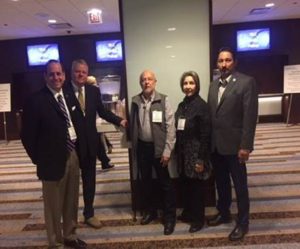
- One of the many things I am so pleased about is the professionalization of our Foundation Board and the improved outcomes of the Foundation. After many months of hard work, we have sound bylaws, a clear picture of our fiscal situation, and stretch, but attainable goals. This is thanks to VP Law and her team and a highly dedicated group of board members. They earn nothing for their efforts and they gladly assume a great responsibility to make HU better. They are engaged. We owe them our thanks. A photo of one of our board members, Rick Miera, marching with the legendary Delores Huerta—so proud to see one of our board members so actively engaged in the community:
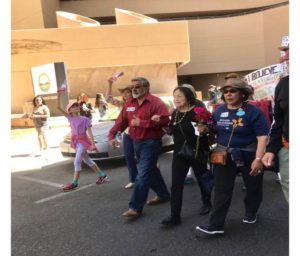
- On Monday and Tuesday, eight HU students participated in the Santa Fe World Affairs Forum. They were joined by students from UNM and the World College. It is my hope that HU continues to be well represented at these events. Many thanks to Dr. Beth Massaro for her leadership on this.

- Roxanne and Ian returned to New Mexico earlier than others in order to attend a statewide meeting sponsored by New Mexico First. The meeting was basically an update on the so-called “trifecta” (i.e., common course numbering, etc.), additional updates on the funding formula, the dual credit program, workforce development, and other matters. Here’s a PowerPoint if you care to peruse. There’s a lot of good data in the presentation. Go to: http://www.hed.state.nm.us/uploads/files/Policy%20and%20Programs/Articulation%20and%20Transfer%20Reform/Statewide%20Meetings/3-21-2018%20President%20and%20CAO%20meeting.pdf.
- On Thursday I attended the Los Alamos Community Leaders meeting at Santa Fe Community College. Our partners from LANL provided an update on happenings at the lab and the new Director, Terry Wallace, talked a bit about some new initiatives. The Lab is such an incredible asset to Northern New Mexico. I frequently hear that they only hire top scientists. They do hire a few of them, but they mostly hire employees with other skills ranging from technicians to accountants to HR people to laborers and many other job classifications. I hear there are no jobs in Northern New Mexico. Not true. The Lab will hire hundreds of new employees over the next several years. I hear that people have to move away from Northern New Mexico to get good job. Again…not true. We already have a good and strong partnership with LANL and I am committed to deepening it as we can. A photo of Mr. Wallace at the meeting:
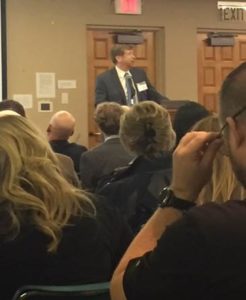
- Hope to see folks at one of the ballet performances this week. There’s one on Friday evening and a matinee on Saturday. This is the last Arts@HU performance of the academic year. The performance will be from State Street Ballet.

- A few kudos from this week…I am sure many other great things happened and I was just not aware of them.
- Kudos to Dr. Donna Woodford Gormley, the English Department, and everyone associated with Geek Week. Well done.
- Kudos to the team that put together the penultimate copy of the MOU to try to bring more funding to our work at Rio Mora. That’s Ian Williamson, Joe Zebrowski, and others.
- Kudos to Coach Bob DeVries and our women’s track and field team for their top NCAA Division II national ranking. Our team is currently ranked #9 in the nation.
- Kudos to proud HU alum Marcus Garcia for receiving the award of outstanding research in pharmaceutical studies. This was the first time a second year student in the School of Pharmacy received the research award. Think Highlands students and alums can’t compete at a high level? Think again my friend. Marcus with his award:
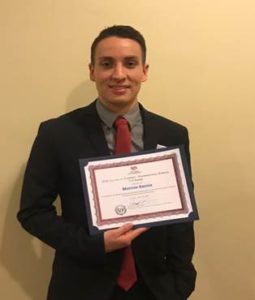
- HLC Update: Not much to say since we got our IAC response in. I’ve already covered some details about our attendance at the national HLC meeting. We should hear from the HLC Board of Trustees in about 8 weeks or so.
- Recruitment and Retention Update: Large numbers of California students are quite literally frozen out of attendance at state universities there. There are simply not enough seats. Given that, our Office of Strategic Enrollment and Management has mounted an 11th hour initiative to try to recruit more California students to HU. That office is contacting California students and emphasizing our strong academics, great faculty, affordability, campus life, and other assets. We’ll keep track of how this works out and decide what works and doesn’t work and we’ll use that information next time around. I cannot emphasize enough the importance of all members of the HU community supporting all SEM efforts. If that office asks for assistance, please make it a high priority. The long term vitality of our institution requires it. At the recent HLC meeting, I sat next to a faculty member from a regional comprehensive similar to HU and what a tale of woe. The institution is losing 14 faculty lines next year—out of a faculty totaling 110 people, due to….you guessed it, diminishing state support and declining enrollment. Another good (or I suppose…bad) example of this is occurring just up the road at Adams State. That institution is cutting 27 positions including nine involuntary separations. The reasons….same story—diminished resources due to state funding cuts and dwindling enrollment. Here’s the whole story if you care to peruse: https://watchingadams.org/news/asu-cuts-27-positions/. Bottom line…for me at least….SEM must be at the center of things. Without students, bad things happen all across campus.
10.Quote of Week: One of my former mentees called me recently asking for some advice on what is almost always a delicate topic…offers from other schools and the possibility of the home institution “matching” the offer. This guy is a super star faculty and administrator. He’s worked in both domains and is being courted by other schools. He’s not applying for other positions—other schools are calling him. To say he is marketable is an understatement. One of the least favorite things I’ve done in my career is negotiating with faculty members who have competitive offers from other schools. These discussion have not always been unpleasant, but they mostly are. First, there is the anger when I informed some people that I’ll not make any counter offer at all. They are quite free to go, if they want to do so. In a few cases, those left behind (including their immediate colleagues) were glad to see them go. In some cases, they were incredible scholars, but really not good faculty citizens. In other situations, I simply have not had sufficient resources to match an offer…so, in most cases, the person left. Once I had a top science faculty show me a bonafide offer that was $80K more—and incredibly, this was an assistant professor— than he was earning where we both worked at the time. 80K more plus outfitting a new lab plus a few graduate students working in the lab plus moving the guy there plus tenure (as an assistant professor)…the list went on and on. The other institution wanted this guy and had the deep pockets to lure him to their campus. I couldn’t compete with that. Sometimes I actually had the money to match the offer, but doing so would put the person so out of whack with her or his colleagues that it was just not reasonable to continue the discussion. In one case, the faculty in the discipline told me that if I matched the offer of one of their colleagues who was on the job hunt…they would all quit. Wow. That was a strong message. BTW—the guy took the offer from the other school and we had a huge hole in the discipline that was left unfilled for years. I’ve also had the experience that the colleagues in the discipline informed me that they didn’t like matching the offer of one of their members and moving her ahead of them in regard to salary, but they were OK with it and to proceed if I wanted to do so. As I wrote, most of these discussions have been really tough. Here’s something I read about this from INSIDE Higher Ed:
“Let’s say that the contract allows you to offer a candidate for a particular role $60,000, but the going market rate for someone with that skill set is $70,000. What do you do? A. Offer what the contract allows, watch the candidate walk away, leave the job unfilled, and hope for the best. B. Offer what the market demands, prepare for the inevitable class-action grievance, and hope for the best. C. Offer what the market demands, give everyone else the same raise to bring them up, and lay off a couple dozen people to pay for it. D. Hire someone who isn’t really qualified, and hope for the best. E. Outsource the role, so the contract doesn’t apply. The careful reader will notice that every option is bad. That’s because every option is bad. If we had enough money that we could do it and avoid layoffs, “c” would be the popular and easy choice. But we don’t. And even if we did, there’s the issue of market volatility. Markets go both up and down. But in the language of economics, wages are “sticky.” They don’t move down quickly. There are excellent human reasons for that, but it puts limits on how hard you want to chase peaks. Many colleges, including my own, have chosen option “e” to deal with IT. Salaries in that area simply outstrip any step-grid, and people with those skills have options. If you need the services — and these days, you do — you may have to go outside the grid. That can create some resentment on campus, but so can a network that crashes regularly. The easiest solution politically is “a,” but sometimes that means leaving important work undone. That can mean more work falling on the people who are already there, or it can mean improvements that don’t happen. James Baldwin’s observation that poverty is expensive applies to institutions, as well as to people. It’s the human version of deferred maintenance.”
By the way, my final advice to my former colleague…(1) don’t approach the provost for a matching offer unless you are really prepared to take it. A bad outcome is for the provost to match the offer and then you wind up leaving for other reasons. (2) Understand that not everyone on your home campus will be pleased if the provost makes the matching offer and you accept it. Think about that carefully before you proceed. And finally, (3) if salary is the main driver for you…more important than say, mission, or location, or personal issues with a mortgage and kids and schools and so on…and you are truly a desirable faculty member who could move to an institution with higher salaries (I’ve certainly known people who were off on that)…you should seriously consider taking it and moving. If you won’t be happy unless you receive more compensation—life is short and you’d probably be better off pursuing that option.
I’m not sure what he will do. We’ll see. If he moves, it will be a loss for his home campus.
The Noble Piper says, “Maybe the HLC should craft a criterion stipulating that every campus should have a dog park. Now that would be moving things forward. Maybe criterion K-9.”
Greetings colleagues. A brief update for the week of April 2-6. Going out a bit early as I’ll be leaving on Friday for the HLC. Special note to the faculty—please participate in the Research Day activities. This is one of the top events to celebrate collaborative research and high-impact practices.
1. We held the weekly EMT meeting on Tuesday and began our time together with a discussion of changes in the portfolio of programs being discussed on so many campuses around the country. Of course, the poster child for that kind of possible change these days is Stevens Point where the university (and broader) community are debating the proper role of the traditional liberal arts and sciences compared to more instrumental or vocational programs. We read this from Inside Higher Education: http://www.insidehighered.com/views/2018/04/02/why-university-wisconsin-stevens-point-plans-eliminate-certain-traditional-liberal. The author of this piece asks the question…can you be a “real” university if you do not support majors in some of the traditional liberal arts areas? The argument here is that not many and certainly not most students major in say, history (just an example), yet most institutions maintain history programs and majors. The exposure that most university students have to that discipline is in core or general education classes. The author argues that more attention given to those classes will do much more to promote historical understanding and knowledge than if all institutions maintain small and in some cases, less than stellar major programs. This is hardly a new argument. But, it is an important one. One point made at our meeting was that…maybe this approach is OK…maybe not…but any school not supporting majors like history would probably not attract top talent as faculty members. Few Ph.D. prepared historians would likely be interested in only teaching introductory history classes. Faculty are interested in teaching different things, of course, and some folks are drawn to intro type classes, but that argument seemed about right to me. We devoted the remainder of the meeting to a discussion of issues related to Pell grants, the upcoming HLC meeting, and preparation for the upcoming board meeting. We also heard a brief report from the Student Affairs HU Futures group. We heard some of the group’s recommendations and ideas. We’ll hear from the other groups soon and we’ll also have one or more open campus meetings about all this. Speaking of the Futures TFs, the athletics group has now convened and I anticipate (and look forward) to their recommendations before the end of the term.
2. On Tuesday, HU received a very nice donation from Enterprise. After receiving the check, I chatted a few minutes with the Enterprise executives about their business and their experiences with HU graduates. They had so many nice things to say about the HU students they recently hired—their high work ethic, their grit, their ability to learn quickly, and other attributes. It was really great to hear. Many thanks to our advancement team and our business program for maintaining such a good and positive relationship with this partner. 
3. On Wednesday, HU held the 19th annual employee recognition ceremony in the SUB. Those retiring from HU were honored. I should note our retirees provided a cumulative 500+ years of service to this institution. We also recognized our colleagues with 5, 10, 15, 20, 25, 30, 40, and (remarkably) 45 years of service to HU. A special award was given to Dr. Carol Linder who will soon be leaving us to take a provost position in Oklahoma. I also surprised Ms. Yvonne Quintana with a special staff award for her outstanding service. We had a great turnout—nearly at capacity seating, but everyone was accommodated—and the vibe was very positive. Sodexho did a great job with breakfast. Many thanks to Carolina, Margaret, and others for putting this together. A photo from that event (left) and another image (center) of our 45 year colleague, the indomitable Dr. Maurine Romine, and one of her students from many years ago, Bob DeVries. Not sure how Bob did in her class. Finally, a group shot of some of the honorees (center). 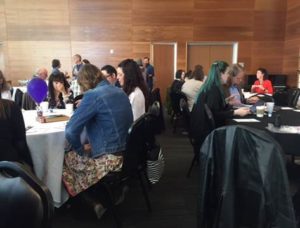


Wednesday was a busy day ending with the Student Leadership Banquet in the SUB. Dozens of students were honored for their high academic accomplishments and their leadership here on campus. Well done to all who made this event a success.
4. Our Women’s Track and Field squad continues to do very well under the direction of Coach DeVries. Student-athlete Annie Topal is leading the nation in the triple jump and leading it by nearly two feet over the next best competitor. Ms. Sharon Toako in presently ranked second in the javelin and Ms. Tashay Hunter is ranked fourth in the long jump. Congratulations to these outstanding HU student athletes.
5. The Stu Clark renovation is coming along nicely and the new space will be a very welcoming and attractive spot for visitors to our campus. I am particularly pleased that we are redoing this space with private dollars. Many thanks to our donors (particularly our lead donor, Chairman Sanchez), Sylvia Baca, Craig Snow, Terri Law, and the whole team working on this project—on time and on budget. “Stunning” was the word a recent visitor to the space used and used several times. A few images from the renovation as it appears today: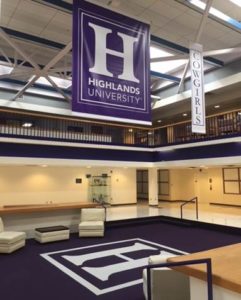
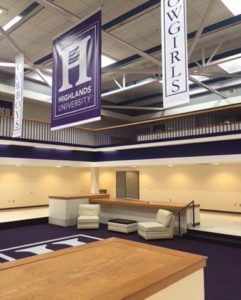

6. The Mighty Vatos will leave soon for the 7’s tournament in Nashville, TN. They will compete in numerous matches and must win the tournament to advance to the championship in Philadelphia. As I think everyone knows, the Vatos were the National Small College Rugby Organization (NSCRO) champions two years running. They hope to regain top status this year. Go Vatos!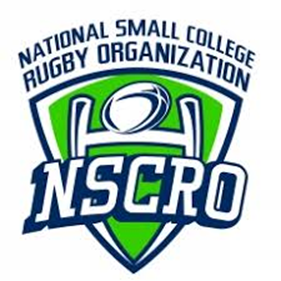
7. On Thursday, we’ll hold a special board meeting to set the budget for the upcoming year. That’s just about the only agenda item we’ll deal with at the meeting. After the budget is set, I’ll provide the campus with an overview of our new sources of revenue and the plan for using the limited new dollars at our disposal. This is but one example of the transparency I am attempting to bring to the entire budget process…want to see what we’re accruing and how we are using it? Look at the summary I’ll send out after the budget is approved by the board. It will all be there. As I’ve previously noted, we absolutely will be devoting some of the limited new dollars to bolster our reserves. I know that’s not the most exciting thing to do, but I feel it is in the best interests of HU in the short, intermediate and long run and of course, the board requires me to do this to the degree possible. Plus, we already know that our accreditor will examine the status of our reserves when they visit us in 2020. For all of those reasons, we will be adding to reserves.
8. HLC Update: The HU contingent will leave for the Chicago this week. I’m the first to leave on Friday in order to attend the early session for university presidents and chancellors. Others will leave and arrive throughout the day on Saturday. The fact that one of our board members will be attending is a high testament to the commitment of the board and everyone at Highlands to stay powerfully connected to the HLC now and into the future. As I mentioned last week, we submitted our response to the IAC report and now…after hundreds of hours of effort, tens of thousands of dollars, and untold meetings and planning sessions…there is quite literally nothing left to do for a few months except to continue to address the various standards and keeping up to date on required activities like the assessment of contingent faculty. I’ve thought a great deal about our collective effort to come off of probation and will share my thoughts after we receive the final recommendation from the HLC Board. I will let everyone know as soon as I hear from them. That will be sometime this summer.
9. Recruitment and Retention Update: Given the situation I discovered when I arrived in the areas of recruitment and retention plus the initial board mandate to engineer some new approaches to recruitment and retention on our campus, I engaged an outside firm, Ruffalo Noel-Levitz (RNL), to assist us in adopting some modern approaches and best practices. The enrollment situation—our processes and ways of doing that work—were simply not very modern and there were few if any real efforts to turn things around. Although we had maintained the number of full-time faculty at HU, enrollment was going down at a pretty precipitous angle and the only likely result of all that unless something ultimately changed was a reduction in force. Of course, that has and is occurring on many campuses around the nation, but I wanted to avoid it here if at all possible. So, something had to be done. Several things were in fact done, but a big one pertained to the engagement with RNL. The goal in regard to most of these outsourcing type arrangements is to eventually get to a place where you can do things yourself and in my opinion, we are now there. I believe we now possess the knowledge and expertise…also the motivation and the clear understanding that this is critically important to us all…to do this work ourselves. Therefore, our engagement with RNL will cease in a few months.
One of the more interesting things I read this week. This from a report titled Do Human Capital Decisions Respond to the return to Education? Evidence from DACA by Elira Kuka, Na’ama Shenhave, and Kevin Shih. The paper appeared in the National Bureau of Economic Research published in February, 2018.
“…we find that DACA had a significant impact on the investment decisions of undocumented youth. High school graduation rates increased by 15 percent while teenage births declined by 45 percent. Further, we find that college attendance increased by 25 percent among women, suggesting that DACA raised aspirations for education above and beyond qualifying for legal status. We find that the same individuals who acquire more schooling also work more (at the same time), counter to the typical intuition that these behaviors are mutually exclusive, indicating that the program generated a large boost in productivity.”
Another paper that was particularly interesting to me was in INSIDE Higher Education and written by Michael Martin, the relatively “new” president of Florida Gulf Coast University. President Martin’s essay was about very experienced people (read…kind of old…I guess he is referring to himself…not me) who still lead and manage universities and the joy he finds and the advantages he sees in that. Here’s the essay: https://www.insidehighered.com/advice/2018/04/04/presidencies-ones-70s-can-have-many-advantages-opinion and here’s a quote:
“…being in the twilight of one’s career provides a liberating ability to do what seems right for the university and those it serves with no fear of adverse impact on future career opportunities. Clearly in my case, and I presume in others’, this is the last stop — no matter what. And, as the Inside Higher Ed article also points out, having a relatively short shelf life imposes urgency that may not otherwise be present. For example, roughly two months after I arrived at Florida Gulf Coast University, the campus took a direct hit from Hurricane Irma. I decided it was necessary to extend the fall semester by a week. This drew protests from students, parents and faculty members. Yet I concluded it was more important — and easier — for me to be right than popular.”
Quote of the week…this one used in my remarks at the employee recognition breakfast:
“ The afternoon knows what the morning never suspected.”
Robert Frost.
The Noble Piper says, “A dog doesn’t have a vote on this kind of thing, I guess, but to even think not supporting the liberal arts is a doggone shame.”
Greetings colleagues. A brief update for the week of March 26-30. Please note that the campus is closed on April 30.
- As I think everyone knows, the IAC has agreed with the recommendations of the site visit team and the HLC Board will soon receive those recommendations: HU comes off probation status. We have an opportunity to append an artifact to the IAC recommendation and we have prepared that document. This is the last document we have to submit. The last step will be the letter we receive from the HLC board. As I’ve done in the past, I will pass that on as soon as I receive it.
- On Tuesday, we held our usual Executive Management Team meeting even though a number of folks were away from campus. Roxanne and Edward were in California at the Council of College and Military Education meeting and Terri was at a CASE conference (CASE is the premiere organization in fund raising). We started the meeting with a discussion of performance based funding in higher education. We read two articles with different perspectives on performance based funding: https://www.insidehighered.com/views/2016/10/06/evaluation-whether-performance-funding-higher-education-works-essay. Performance Based Funding (PBF) in American higher education is ubiquitous these days. More than half of all states use some form of PBF. It became very popular after the Great Recession and it does have some appeal…at least on the surface. You set certain goals for institutions—often related to retention and graduation rates, STEM awards, external funding, and others—and then reward schools performing well in those domains. As you can see if you peruse the articles (above), the results of PBF are mixed. In some cases, it seems to work pretty well—Tennessee and Georgia are often cited as examples—but in others it seems to have minimal impact and in some cases even seems to have a negative impact. Specifically, some have suggested that if completion rates become major drivers in higher education funding, schools serving populations facing daunting challenges due to their student demographics (like HU) might simply stop admitting students hard to retain and graduate. Schools might change their missions altogether. I mean, is it really smart to admit really tough students when you’re going to lose funding if and or when those students do not complete? Some institutions might do that, I guess, and that would be tragic, in my view. Every single president or chancellor knows how to boost graduation rates—admit top students. When I left Truman State (with an average ACT for incoming students around 29), the retention rate was around 90% and the graduation rate was about 72%. Those metrics would have been even higher if some students had not left the institution for supposedly greener pastures at elite schools back east. Of course, only admitting top students does nothing to improve overall higher education performance in America.. American colleges and universities have always done quite well with top students. Other students…facing challenges in many cases due to no fault of their own…have not historically fared all that well and that must not stand. That’s not fair, not just, and only widens the gap between the haves and have-nots—a big problem in America. That’s truly hegemony in action. It was a good discussion and an important one. I have asked Max to provide the campus with a primer on how performance based funding works here in New Mexico so if you are interested, make sure to try to attend that meeting. I’ll announce the date soon. We moved on to a discussion of our response to the IAC recommendations, what opportunities, if any, there might be to recruit some additional students from California (see:https://www.insidehighered.com/admissions/article/2018/03/26/reports-circulate-even-more-difficult-year-be-admitted-leading), and a few other items pertaining to the Faculty Senate, athletics, etc.
- Gamma Alpha Omega recently hosted the Southwest Regional Conference and hosted members from California, Arizona, New Mexico, and Texas as well as several Highlands alumnae. For their community service event they prepared Easter baskets for children in our community. Each basket was handmade by a sister and included a special message from a member of the sorority. Well done to the sisters of Gamma Alpha Omega!

- Thanks to the efforts of Dr. Beth Massaro, we’ll be hosting a representative from the Foundation for Individual Rights in Education (FIRE) on our campus next year. FIRE is the most prominent organization promoting free speech on American campuses. We hope to make certain that students, faculty, and staff have access to the FIRE representative and I’ll also be asking for a review of our free speech policies. I want HU to eventually receive a “green rating” (the most favorable rating) from FIRE and that is why I am voluntarily subjecting our polices (or lack thereof) to their standards. A major study investigating how college students feel about free speech issues was recently released. Here it is: https://www.nytimes.com/2018/03/12/us/college-students-free-speech.html?rref=collection%2Fsectioncollection%2Feducation&action=click&contentCollection=education®ion=stream&module=stream_unit&version=latest&contentPlacement=5&pgtype=sectionfront.
- In sent out the call this week for people to consider applying for the 2018-2019 HU President’s Leadership Development Program. I began doing this years ago at Truman State and also at Radford. Participants have gone on to become presidents, provosts, vice presidents in numerous areas (e.g., enrollment, finance, etc.), deans, and faculty and staff leaders. Not all participants transitioned to administration. Not everyone wanted to do that. But most did. There are never enough good leaders in higher education and the current environment makes good leadership even more critical. Despite the incredible demands on people in these jobs, most of the folks participating in the program desired to pursue some administrative path and were quite successful. They found that path to be interesting, stimulating, meaningful, and something they really wanted to do. In most cases, they were also really good at it…much better than me. The call appears as an attachment above. If you have an interest in this kind of thing, please apply.
- David Lobdell and Ian Williamson have been working on our public art initiative and the residents of Rodgers have narrowed things down to two pieces. Both would be outdoor installations. Here they are:

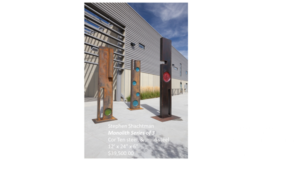
Note that the art and the installation are free to HU. All we have to do is follow the state process for acquiring these pieces. What a deal—why we were not taking advantage of this program I do not know. But we are now. The final piece everyone selects will be installed outside of the renovated Rodgers—location to be determined. Many thanks to David and Ian for their leadership on this. Numerous other pieces will also be acquired and installed in other locations around campus. Speaking of Rodgers, things are progressing nicely. Most people have been moved out of the building. A few more (including me) will move in a few months. I’ve previously described the plans for the building. Basically, the first floor will consist of a modern classroom (it will be nice to see more students coming into the building), a large meeting/board room (which will be available for Board of Regents meetings, Foundation Board meetings, faculty and staff senate meetings, and other large gatherings), and an HU Heritage space where visitors to campus can learn something about our history and traditions. The second floor will be devoted to offices.
- This past academic year, numerous HU faculty participated in one of the High Impact Practices (HIPs) initiatives we supported. One project focused on service learning and another focused on writing across the curriculum. As you may recall, some time ago, we had a very successful HIPs fundraising campaign on our campus and accrued in excess of $750,000 to endow additional HIPs projects into perpetuity. This is how institutions truly grow stronger—growing the endowment to support some new initiative each and every year—potentially forever. Otherwise, you mount some modest campaign, collect what you can, and then spend it down. That’s basically a checking account. Something good might happen, but does the institution grow stronger over time? Not really. Many thanks to Dr. Diana Marrs and all the faculty who participated in one of our HIPs projects. Diana is now planning another brainstorming session to see what people want to do next year. High Impact Practices are clearly very important. Many scholars have documented several research-review-based determinants of what transforms students, and also what seems not to matter. Their message is striking and clear. Structural and organizational differences among institutions have almost no discernable effect on how students change during their time at the university; rather, it is students’ experiences embodied in factors like “the nature and frequency of student contact with peers and faculty members, interdisciplinary or integrated core curricula that emphasize making explicit connections across courses and among ideas and disciplines, [and] pedagogies that encourage active student engagement in learning and encourage application of what is being learned in real and meaningful settings”(Pascarella and Terenzini 2005; p. 642) that consistently emerged as those driving students towards actualization of their potentials. In other words, high impact practices matter. A lot. Maybe more than anything else.
- I’ve received the HU Futures Reports from three of the four groups. The team looking at athletics was delayed a bit, but they’ll meet next week so we still might be done by the end of the term. We discussed next steps at the EMT meeting this week and decided to do several things…we need to discuss the various ideas/recommendations at the EMT level (we have not done that yet) and Tom Ward also wanted to start the discussion at the faculty level. That sounds like a good plan. We also thought it would be a good idea to hold one or more open meetings to discuss all this and plan for next steps. Again, my thinking here is that we’ll need to begin the process of devising a new strategic plan next year. Vision 2020 ends…well…in 2020. The new vision should ideally be done by the time our accreditors arrive in 2020. But, given the external issues we face, we can ill afford to wait until that plan is set to try to move some things forward. For example, the MFA degree has been on hang-fire for some time. At the very least, we must be ready to submit that program to the HLC as soon as we come off of probation. What other structural changes might be made to improve efficiency and potentially capture resources to reallocate to more strategic ends? Like enrollment growth. Like program expansion. Like new programs. Etc. That’s the goal in all this. The last year and a half or so has been a period of intense inward examination here at HU. That was required in order to address the various accreditation issues and it resulted, in my opinion, in many good outcomes. But, institutions are not really strengthened by only looking inward. To make things better, some thing or things must change. That requires forward momentum. New thinking. Now, of course, not all new ideas are good. So…let’s have the discussion. Pick a few idea that seem to have merit. Try them and adjust as necessary.
- HLC Update: As noted above (item #1), we will host a focused visit from the HLC in 2020…probably during the summer, but it is their call as to the date. They will examine three things—the HU Strategic Enrollment Plan, our financial reserves, and our efforts to continue to use data to make institutional improvements (i.e., closing the loop). Edward and others are working on bringing together the elements of our Strategic Enrollment Plan right now so that should be in great shape by the time our visitors arrive in 2020. We will be adding to our reserves this year and next. I have informed the board of that decision and indeed, they have required me to add to the reserves if it is possible to do so and not hinder the instructional mission. So, that will be done. We are also working on a dashboard type scheme to demonstrate how we are using data to improve things at the institution. We are doing a fairly decent job with that now, but it would be helpful to collect things together in one document. That should help a great deal. The HU team (me, Brandon, Ian, Max, Regent Marchi, Roxanne, and others) will soon be leaving for the national HLC meeting in Chicago. Sean Weaver will set up a blog type arrangement and we’ll send the campus a few messages/updates from the meeting—the sessions we attended, what we learned, that kind of thing.
- Recruitment and Retention Update: Some of our most recent retention performance:
o First-time freshmen fall-to-spring retention up from 72% to 76%
o First-time transfer fall-to-spring retention up from 77% to 85%
o First-time freshman 4-year completion increasing in last several years up from 8% to 10.4% to 10.9%
o First-time freshman 6-year completion increasing in last two years from 17.9% to 22.2%
o First-time transfer 2-year completion increasing in last several years from 28.2% to 35.8% to 40%
o Fewer first-time freshmen were on academic probation after the first semester
o The average credits earned by first-time freshmen has increased
Here’s one of the best things I’ve read this week. It speaks to the “churn” in higher education administration. Leaders come and go into those positions more and more rapidly these days. Ten year presidents are very rare now. Less than three years is all too common. From time to time, change is good, I think. But too much change too frequently in any organization is almost always a problem. One problem with all that is schools caught in the churn do little but start over every three years or so. Generally, that is not a path to excellence and frequent changes in top leadership are highly correlated with numerous negative outcomes including, for example, accreditation problems, enrollment issues, a pattern of stop and start innovations and changes, and change exhaustion. People just get tired of the “new ideas” from new leaders. This from Steven Mintz writing in INSIDE Higher Ed:
“Innovation is an iterative process. It is not surprising that the institutions that have been most successful in significantly raising rates of student success and embracing innovation – Georgia State, Southern New Hampshire, and Arizona State – have had long-term leadership in place – leadership that articulated a clear, consistent vision and worked tirelessly to see it implemented. Too often, however, even highly successful initiatives…are allowed to wither after their developers and implementers move on.”
Here’s another interesting one. Many of you are aware, I am sure, of the potential changes at Stevens Point in Wisconsin (and other Wisconsin schools). This from an article by Valerie Strauss that appeared in the March 21 Washington Post. I should note that I and several other university presidents submitted letters to the editor of the local paper in Stevens Point. They were not published.
“The plan to cut the liberal arts and humanities majors…is in line with a failed attempt by Republican Gov. Scott Walker in 2015 to secretly change the mission of the respected university system — known as the Wisconsin Idea and embedded in the state code — by removing words that commanded the university to ‘search for truth’ and ‘improve the human condition’ and replacing them with ‘meet the state’s workforce needs.’ The push away from liberal arts and toward workplace skills is championed by conservatives who see many four-year colleges and universities as politically correct institutions that graduate too many students without practical job skills — but with liberal political views. The administration at the University of Wisconsin at Stevens Point recently issued a statement detailing the plan, which still must be approved by a campus governance committee as well as the University of Wisconsin system’s chancellor and Board of Regents. It said that the school faces a $4.5 million deficit over two years because declining enrollment has led to lower tuition revenue, and proposes adding or expanding 16 programs in areas ‘with high-demand career paths as a way to maintain and increase enrollment.’ Last fall, the school saw an enrollment decrease of 5.4 percent from the year before. That was on top of a 6.8 percent drop the previous year. To fund this future investment, resources would be shifted from programs with lower enrollment, primarily in the traditional humanities and social sciences.”
One more quote—I received a call from a former colleague now completing an ACE Fellowship. She was one of my Leadership Fellows at Radford. She was a great faculty member and already is a great administrative leader and I am sure that the ACE experience will enhance her leadership skills even more. If anyone is interested in a job at the president or chancellor level, I strongly encourage them to consider the ACE Fellows program. It is truly the path to the presidency. At any rate, she asked me for any advice on dealing with an individual who temporarily reported to her in her capacity as an ACE Fellow. She described this person as a long term and very smart individual, but a real “serial complainer” and someone she had not been able to effectively work with during her ACE experience. I gave her the best advice I had, which was…to ask the serial complainer if she wanted her opinion. If no…discussion over, If yes, tell her what she thought about the situation and leave it at that. Keep the conversation brief and make no attempt to change minds. I’ve occasionally used this approach and I don’t think I’ve changed any minds whatsoever, but in some cases, the serial complainers I’ve known (few in number, but some quite memorable) have reduced the complaining they made to me. I considered that a kind of victory. I recalled I read about this approach somewhere and after a little searching I found it. It came from an article inForbes. Here’s a quote from that piece:
“Ask: ‘Do you want my opinion?’ Human nature makes most people inquisitive enough to say, ‘Yes’ to this question. And then, the person has given permission. They’re in control of the conversation. They have asked to hear your thoughts on the subject. At that point, let the person know that you have a different point of view, but don’t try to convince them. Make it short and sweet: ‘I hear what you’re saying but I see it differently.’ Remember, you can disagree without being disagreeable. So remain polite and professional. But hold firm. Don’t get into a debate on the matter.”
The Noble Piper says, “ More than halfway through the spring term. Looking forward to the summer and believe me, I will not be doing summer school. Maybe fetch a few tennis balls, but nothing more.”

Greetings colleagues. A brief update for the week of March 19-23. This one is going out a bit early since I’ll be out of town on Thursday and Friday.
- I received notification from the IAC this week—that’s the committee we went before in Chicago. The IAC has written the HLC Board of Trustees and recommended the removal of the probation sanction.
- The Board of Regents voted last week on a set of tuition and fee adjustments for the 2018-2019 academic year. These adjustments were not an easy decision, and the board members spent quite some time deliberating the needs of the university and the impact on our students and the institution as a whole. These are always tough discussions, No one wants to require students to pay more for anything really and yet, the resources required to run the place—and hopefully more than run it…to move forward and prosper—must come from somewhere. The adjustments are:
- In-state undergraduate tuition and fees will increase by about $4.84 per credit hour.
- In-state graduate tuition and fees will increase by about $13.14 per credit hour.
- Out-of-state/non-resident undergraduate tuition and fees will increase by about $45.69 per credit hour and out-of-state/non-resident graduate tuition and fees will increase by about $48.37 per credit hour.
- The regents also adopted an increase in meal plan and housing rates, about $52 per semester, to adjust for increasing costs of these services.
- We will implement an online only tuition of $300 to $375 and $500 to $575 per program
Vice-President of Finance Max Baca and his team are reviewing what revenue will be generated through this adjustment and what we can accomplish through the increase. The most important goal we must achieve, however, is building up our reserves and becoming less dependent on state funding. I know this isn’t exciting, but it is an existential mandate from the Higher Learning Commission. If we do not show significant improvement in our reserves, we will continue to struggle with HLC issues. We have done too much together during the past two years to put ourselves in that position.
- Also at last week’s board meeting, we examined some data suggesting that a significant number of HU students are leaving money (free money) on the table by not applying for Pell Grants. I promised the board that I’d prepare a plan to address this issue by the end of the term. Moving forward, I will:
- verify the number of HU students applying/not applying for Pell; were we looking at accurate data at the board meeting?,
- attempt to ascertain why students eligible for Pell are not applying,
- engineer some initiatives to increase the number of students applying, and
- assign the implementation and monitoring of all this to one or more people and ask them to provide me with routine updates as to the efficacy of our efforts.
The issue of students not applying for Pell grants has been studied nationally. For example, a recent study found that many students/families who did not apply thought they earned too much to be eligible for the program. In many cases, those people were mistaken since Pell eligibility is really pretty complex and income is only one variable in the equation. Others did not apply because they failed to complete a FAFSA. A few students and families did not even know what FAFSA was or how to access the application. Incredibly, about 34% of eligible students/families did not apply because they did not want “to take on debt”…which is really odd since you don’t have to pay back Pell grants. A definite miscue there. About 14% said they did not know how to apply for Pell and almost 10% said it was too much work. Wow “too much work” to access free money? So…we need to get to the bottom of this and try to improve our performance. If you are interested in serving on a group looking at all this, please let me know.
- There is a significant national movement referred to as Z-Degree. This movement, mostly at community colleges, aims to reduce textbook costs to zero by using open source materials. Recently, HU launched a modest program to reduce textbook costs to students and we have had some successes. Since the summer of 2017, nine HU faculty have reduced textbooks costs to their students by relying on open source materials. I thank them very much. Students, I am sure, thank them too. I know that not all classes are the same and not every class can be readily taught using open source materials, but I would very much like to see more participation in this program. Textbooks for a semester’s worth of classes can easily exceed $1000 and believe me, most of that money does not go to textbook authors. And when students sell them after they are done using them, they usually receive pennies on the dollar. My colleagues—please consider participating in the modest program we have here at HU to reduce textbook costs to our students. If you don’t know about the program, please see your dean or the provost. I’ve attached several articles about the Z-Degree movement (above). Another scheme I’ve tried in the past—a summer grant program supporting faculty members who write or collect previously published papers into an edited volume later used in their classes. I paid the faculty to produce these materials, which were provided to students at cost and the cost basically amounted to copying the book. That saved students lots of money and since the faculty teaching the class actually prepared the book, most of them really liked how the book meshed with their lectures and other class activities. Just a thought. Again, I know this approach does not work for every class.
- On Tuesday, an HU contingent visited the Luna campus to take part of in the community forum associated with their Show Cause visit. The HLC Site Team Leader, who I think did a nice job, used his limited time to solicit comments around the SWOT acronym—what are the strengths of Luna (S), the weaknesses (W), the opportunities (O), and the threats (T). There was a large gathering at the meeting and I thought the comments were open, direct, honest, and fair. A photo of the community input meeting:
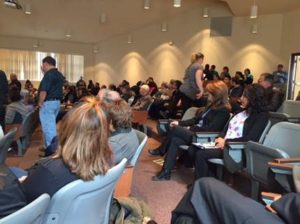
- HLC Update: As noted above, we’ve received the IAC report and we have a few days to prepare our response. Our response will be brief, I assure you. What would we say except…thanks for your recommendation, we agree…proceed? I learned a long time ago to not say or write too much when things are going your way. And things are going our way so let’s keep that trend moving forward.
- Retention Update: I asked three of our students this week to tell me what they thought mattered in regard to retention. What was most important to them? What mattered? Now, it was only three people so I am not drawing any broad conclusions here. But, their answers were a little surprising. Although they mentioned several specific retention efforts (e.g., ARMAS, other tutoring programs, even the Arts@HU series…interestingly, affordability did not come up at all), they all talked about the association they had with one or more faculty members and many of their comments had to do with talking with and being coached/mentored by faculty members outside of regular class hours. One said, “name deleted really cares about me and what I’ll do after HU.” Another said, “the faculty in discipline deleted are really great. They have my back.” I guess this is not all that surprising to me after all. That connection to faculty was so important in my life and I think that’s true for many people. So…if the critical retention program has to do with the relationships, the interactions, the mentoring that goes on between faculty and students…how might that be enhanced? Is it possible to somehow measure that to see where the needle is? Some people do this more powerfully and better than others right now. Some less so. Will any incentive get someone to do this who really doesn’t want to do it? Is it fair or reasonable to ask those who are already doing a great job in this area to do more? Won’t that just lead to burnout? How should good work in this domain be recognized…and rewarded? I welcome any thoughts people have about all this.
Quote of the week—this one by a former colleague from Truman State, Robert Graber, in his book The Usefulness of Useless Knowledge:
“The liberal arts may be defined—impishly, but accurately nonetheless—as essentially those areas of knowledge in which practical-minded parents hope their children will not major. ‘But what are you going to do,’ they cry, with a major in ——?”
Another quote from this week. It is once again the Season of Leaving when some colleagues—good, bad, and in-between—retire or leave for another job. A quote from Everyone’s Leaving Me Behind!” Dealing With Others’ Transitions. This article appeared in INSIDE HigherEd and was written by Florianne Jimenez.
“When your friends are leaving, sometimes it can be tempting to avoid seeing them… so that their departures don’t hurt as much. Don’t do that! While goodbyes are always sad, you’ll regret not having a nice, solid farewell once your friend is gone. Like rituals for keeping in contact, it’s cathartic to have a little structure around a friend’s departure, either through a party, a last coffee…, a hike in the woods, or even by helping them pack up and move. Even though the feelings of abandonment can be scary, make an effort to properly show up for your friend and colleague who’s leaving. They might be worried about leaving too, and your presence will definitely be appreciated.”
One of the best things I’ve heard about good byes goes like this, “How lucky I’ve been to know someone who makes saying good-bye so hard.” I think that’s a great message.
It reminded me of a piece I wrote a few years ago. Here it is: https://www.insidehighered.com/advice/2015/07/17/how-handle-employee-farewells-least-awkwardly-essay.
The Noble Piper says, “I knew the IAC report would be positive. A good dog just knows.”

Greetings colleagues. Spring break at HU, but the work of the campus continued nonetheless. My brief update for the week of March 12-16
- I am pleased to announce that our commencement speaker for this spring’s ceremony will be Major General Melvyn Montano. Major General Montano is a proud graduate of HU and participated in what I believe was the first HU cohort delivered to students at Kirtland Air Force Base. He served as adjutant general for the New Mexico National Guard and commanded the Army and Air National Guard, as well as the commander of the State Defense Force. In addition to his federal duties, General Montano served as military chief of staff to the Governor and as the Governor’s principal advisor on military affairs. He also served as the president of the State Armory Board. General Montano provided 16 years of enlisted service before he received a direct commission as a first lieutenant with the 150th Tactical Fighter Group. While assigned to this unit he served in several positions as a supply operations officer and equipment control officer until he assumed command of 150th Resource Management Squadron and reassigned as deputy commander for resources in August 1987. In May 1988, he became the vice commander for the 150th TFG. Major General Montano is a Vietnam veteran having served in the 431st Munitions Maintenance Squadron in 1968. Several HU folks have heard him speak and by all reports, he is highly inspirational. A photo of Major General Montano:
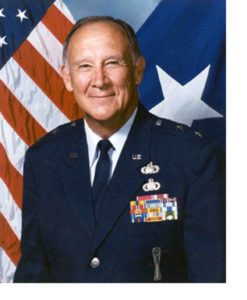
- Congratulations to Carol Linder and everyone who helped with the Science Fair last Saturday. Internet problems (pipe from ABQ accidentally cut along I-25) required some on-the-fly adjustments, but in the end, the students had a great time. We had about 208 participants mostly from districts surrounding or close to Las Vegas. It is so important to support the science and math interests of young students—they are the STEM pipeline and indeed, the future of the nation. If huge problems are ever addressed or solved…global warming, food security, sustainable energy, and many more, those students will be a big part of the solutions. A few of the judges helping guide the young scientists:
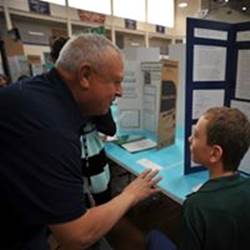
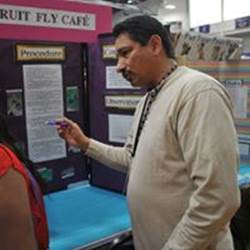
- We are making steady progress on acquiring some additional art for display in public places. The state supports a modest program allowing state entities to acquire art as new buildings are constructed and or major renovations made. For some reason, HU has not engaged in this program for a while—not sure why. Our good friend and colleague Kerry Loewen began the process of getting this done, but unfortunately left HU before the process was finished. A shout out to Kerry and thanks for making this effort my colleague! Hope you are doing well in CA, my friend. A few weeks ago David Lobdell graciously agreed to pick things up and he and his team have made substantial progress. Many thanks to David and others working on this. It is my hope that we’ll soon have some new public art on our campus. AVPAA Ian Williams is also providing leadership on this project.
- There is probably no greater poster child for changes in higher education these days than Wisconsin. First, it was the merger of many two year schools with four year universities; an idea that was broadly discussed at the last legislative session here in New Mexico. That was followed by significant changes in tenure throughout the UW system. I’d say overall, tenure was weakened there mostly in order (ostensibly) to make changes more rapidly—to allow institutions to be more nimble. The headwinds they face? Enrollment declines coupled with diminishing state support. Sound familiar? And most recently, several campuses (with more to come, I think) are closing a significant number of programs in favor of others—mostly closing liberal arts type programs and mostly adding professional programs. Of course, that trend is quite evident nationwide. The situation in Wisconsin has come to my attention since I personally know several presidents and chancellors in that state and I have some interactions with them. For more details, you can read:https://www.insidehighered.com/news/2018/03/13/faculty-members-wisconsin-stevens-point-react-plan-cut-13-majors?utm_source=Inside+Higher+Ed&utm_campaign=540ee28dda-DNU20180111&utm_medium=email&utm_term=0_1fcbc04421-540ee28dda-198622925&mc_cid=540ee28dda&mc_eid=1b6e1fa6ce. I do think it is important to follow these national developments to learn from them—both things that might help us and things to avoid. Assuming the trends in public higher education continue, I think that we’ll see more and more of this kind of thing. A more recent update can be found here: http://www.insidehighered.com/blogs/confessions-community-college-dean/struggling-stevens-point. Several professional organizations and several university presidents/chancellors have chimed in on this issue at Stevens Point. I have as well and if my letter to the local newspaper there is printed, I’ll let everyone know.
- Please try to attend the last major Arts@HU event of the semester—the State Street Ballet’s performance of Cinderella. There’s a performance on April 13 at 7:30 p.m. and a matinee on Saturday the 14th at 2:00 p.m. Come out and support professional dance in Las Vegas.

- Several weeks ago, I and several other faculty and staff members accompanied students on a safety walk around campus. It was a cold and kind of miserable evening, but everyone persevered. Several issues were noted—lights out, issues with crosswalks,etc.—but the most pressing issue was the dangerous pedestrian crossing on National Avenue. I am pleased to report that we have found the resources to install a speed bump (or as they are called in New Mexico…a speed hump) in that area. Hopefully, this will slow down the traffic there. We will address the other problem areas and concerns as our budget allows. Thank you Student President Lujan for assisting us to make our campus safer for everyone. Thanks to Sylvia Baca and her team for being so responsive to student concerns.
- Joan and I have become big rugby fans since moving to HU and we continue to follow an HU great—Kevon Williams who is playing professionally. Kevon is such a great HU story…a wonderful student athlete and a person of high character and integrity. Check out this video of Kevon in action against Uruguay:https://www.worldrugby.org/video/319107.
- Our Financial Aid Office has been busy providing prospective students and their families with information about paying for college, how to get that done, what options are available, etc. Susan and her team recently did a financial aid workshop in Cimarron. There was a good turnout—about 30 people. This week, the team delivered workshops at Robertson and West. Study after study has found that a great number of students and families are simply not receiving good information about how to pay for college. According to a recent study, many families in America continue to believe that college is not an option unless you have all the money you need in the bank. Obviously, very few people have those resources. Many thanks to Susan and her team for going the extra mile to help students and their families. Well done.
- Coach John Levra, his wife, and two former HU football players (who also had careers in the NFL) dropped by my office on Wednesday. John is such a gentleman and such a strong supporter of HU.
10.There was a board meeting on Thursday and the major issue was setting tuition and fees for the upcoming year. There was a long conversation among the board members as they struggled with this difficult issue. I’ll send out a complete summary as soon as I can, but in the end, the regents unanimously approved a modest tuition hike for in-state undergraduate students and some other increases in auxiliary areas, graduate programs, etc. Regents at HU, as you know, are paid nothing and yet have incredible responsibilities and must make big decisions all the time. They hire and fire the president, they set tuition and fees, and they approve the overall budget. They also set the overarching goals of the institution. None of these things are easy. Every decision they make is examined in great detail and others are not at all hesitant to provide their opinions about each decision. In my view, our regents are true servant leaders who consistently put HU first while thinking very carefully about all other constituents—our students, the staff, the faculty, the administration, future students, alums, and the citizens of the New Mexico. We owe them a high debt.
11.HLC Update: We met last week to preliminarily plan our response to the IAC. Of course, we have not even received it yet, but we are thinking about our response already. We anticipate that we’ll devote about ten pages to the response. This will go to the HLC Board and basically, that will be the last artifact we’ll submit.
12.Enrollment And Retention Update: Among the most significant headwinds HU faces in regard to enrollment growth is the declining high school population. Our state is facing a substantial decrease in the number of high school students graduating between 2018 and 2032. New Mexico saw its peak of high school graduates in 2012 with 21,523 students graduating. According to a recent study, New Mexico high school graduates will decrease from that 2012 high of 21,523 to a low of about 18,373 students in 2032 (see figure below). Most projections suggest that the situation in Northern New Mexico is even more acute. We are decreasing at an even faster rate. The logical conclusion…we are unlikely to see much if any enrollment growth by only relying on New Mexico high school students, particularly students from Northern New Mexico. Those traditional aged students are just too few in number to add much to our enrollment. What’s left? Basically, transfer students, adult students, and out-of-state students. Everyone is vying for these students, but we must also aggressively pursue them.
Speaking of recruitment, our Demand Builder initiative is nearly complete for this year. Of the 9980 high school senior students contacted, 5.58% of them responded. That is about typical for the RNL Demand Builder process. We contacted 25,780 junior and sophomore students and 6.59% of them responded. Again, a decent response rate. The bottom line for me: our response rates are similar to those of other schools in our sector. The next thing to examine, think carefully about, and then take action on is the yield rate.
One of the best things I read this week. This from Joshua Kim writing in March 12, 2018 volume of INSIDE Higher Education. Kim was writing about a new book titled Its Better Thank It Looks by Greg Easterbrook:
“Mostly, I think, we as postsecondary educators have done a terrible job in conveying to our students the following: A. That they are living now in the best possible time to be alive, of all times in history. B. That while there personal future is not guaranteed, and that there will be setbacks, as a group today’s students will have opportunities greater than any cohort in history. C. That the arrow of history runs towards progress, and that they have an essential role to play in extending the benefits of progress to the world. Easterbrook makes the point that academics and intellectuals who make these assertions, and one’s like them, are basically looked down upon by our academic community. I agree. The data, however, is beyond argument. On almost any measure that one could construct – from poverty to income to nutrition to health to the environment – our world has improved. This improvement has been spectacularly dramatic over the past 30 years, with over a billion people escaping from absolute poverty in China and India. Hundreds of millions will join the global middle class in the next two decades, as urbanization and economic growth will enable improvements in access to education, sanitation, health care, transportation, and leisure that were previously out of reach…the arc of progress has not been limited to only the emerging economies. Believe it or not, life in the U.S. has gotten better in the lifetime of the parents of today’s college students – and will get much better in their lifetimes. We too easily forget the advantages of cities that have revived (Boston, Chicago, NYC, LA, to name a few), crime that has dropped, and smog that has disappeared. Compared to 1969 (the year I was born), cars are safer and more fuel efficient, air travel is safer and cheaper, and information has gone from scarce and expensive to abundant and cheap. We could go on and on and on. There are no end to examples of how the world has improved in the past 48 years, and very few data points to say that things have gotten worse. Go ahead, take your best shot – I’m ready for complaints of rising inequality, wage stagnation, college debt, and health care costs. A world getting better does not mean that we live in the most perfect of all possible worlds. Rather, we live in a world that we have the opportunity to make better, and on balance we have been making our world a better place to live.”
The Noble Piper says, “Why don’t you fetch it. I am thinking about a nap.”
Greetings colleagues. A brief update for the week of March 5-9:
- Last Saturday, I welcomed a group from Amigos de las Americas to our campus. They were here to do an orientation for the students who will travel abroad this summer. The did a tour of the campus, completed a Spanish language workshop, and other activities. Many thanks to all who helped make this happen—Margaret Gonzales, Eric Romero, Kim Blea, and many more. Well done to all.
- I left Sunday for the IAC meeting in Chicago. I was joined by Brandon, Roxanne, and Max. After lunch at the hotel, we had our last prep session and then an early evening before the committee meeting on Monday. There was a last minute change of folks on the IAC panel due to a personal matter, but that really made no difference at all. The meeting began at 1:00 p.m. I made some opening comments focusing on my overall strategy to address the various issues. I focused on (1) personnel changes, (2) structure/process changes, and (3) resources. I commented that I made numerous personnel changes to get this done, worked with leaders to engineer processes to get things done, and even during a tough budget year, devoted the necessary resources to get things done. Our Site Team Leader, Gar Kellom, then made a few comments. Then, the committee asked questions for a few hours. As anticipated, the questions pertained to the areas of concern noted in the Site Team’s report. The meeting concluded with me making a few closing statements. Gar did the same. Gar finished up by stating that he and the team recommended that the sanction of probation be removed with a follow up visit in 2020. I strongly agreed with that recommendation. There was some discussion among the IAC members about how the institution had “lost its way” over the last several years—actually dating back to around 2000. I didn’t fully agree with that language or that perspective and I have to say I winced a bit when I heard it, but I understood what people were asking. Here’s my take—
When some negative thing happens, especially in some organization, it is too easy to play the blame game and say that this or that person was responsible. In my experience, that is rarely true. In complex organizations, negative or poor outcomes are influenced one way or the other throughout the enterprise and good institutional citizens…irrespective of their job title or role…should seriously reflect on what they did or did not do to contribute to the problems. I truly believe that, but….in the end…I think it does go to leadership. Leadership writ large. Staff leadership, faculty leadership, administrative leadership, and board leadership. Often, it amounts to putting too much energy and time into things that do not make a big difference in the end. Tracking down some receipt to get someone reimbursed for a trip needs to be done, but even when it gets done, the institution is not really stronger. Spending time over word choices like “rescind” or “modify” needs to be done sometimes, but again, in the end, the organization is not stronger afterward and the world is not a better place. The thing is just resolved, which is good, but….the needle has not really moved toward improvement. Keeping track and spending time on things that are important really matters. There’s often a debate about what is important, but in our sector, I think few would argue that things like student success, making certain all instructors are well qualified and doing a good job, minding the fiscal health of the organization, etc. are pretty darn critical. When good institutional citizens focus on important things and step forward, get their shoulders down, and courageously face problems and take care of business…positive things are very likely to happen. Other variables come into play, of course. If we are talking about state universities, serious downturns in the state budget can and do happen all the time. An exodus of students from the region can happen. Too few good jobs around and people just leave. But usually, no single person can do much about those things. I said as much to the IAC and frankly, they seemed to agree. I also reasserted that effective July 1, 2015 and up until the day I leave HU, the ultimate responsibility for all this is mine. They also agreed with that, as expected.
We should receive the IAC’s report in a few weeks. Good, bad, or in-between—I’ll share that news with the campus community. We can respond to the report and we’ll provide some new detail, but it will be brief. That report will be sent to the HLC Board and they will make a final decision.
I do want to thank everyone across the campus community who helped get us to this point. It was a real team effort. I also want to thank the colleagues who accompanied me to Chicago for the IAC meeting. That’s Brandon, Roxanne, and Max. Everyone owes them a great debt and our sincere thanks.
I remained in Chicago the next day for a meeting with Dr. Janice Jackson, the CEO of the Chicago Public Schools. We talked about the modest pipeline program we have with some of those schools and our hope to expand it, if possible. But, we mostly talked about public education in America generally, particularly focusing on the millions of students who face poverty and other daunting challenges inhibiting their academic achievement. They come to schools (including college) facing daunting challenges in so many domains and we are asked to make all OK. That’s tough to do…but it is a privilege to be a part of that noble effort. Janice is super smart and the schools there are lucky she is leading them.
- With Carol’s OK, I must report to the community that Carol Linder will soon be leaving HU. She will become the provost at East Central University in Oklahoma. Carol has served HU in so many capacities—in faculty leadership roles, in leadership roles in the union, in administrative roles, and many others (e.g., seeing her on the football field working with the Chain Gang). However, my most powerful memories of her will always be related to her incredible commitment to our students. Such energy. Such passion. Such dedication to student success. I know the entire community wishes Carol nothing but the best as she enters the next phase of her life and career.
- Congratulations to our student Regent, J.R. Vigil, who was recently elected to the City Council in his home town of Espanola. Today—JR city councilman. Tomorrow—JR—governor.
- On Thursday, I drove to Rio Rancho to talk to a class about my approach to leadership. I really enjoyed it. I appreciate the invitations to talk to classes and will gladly make those arrangements, schedule permitting.
- Please consider attending the last major Arts@HU event this year—Cinderella performed by the State Street Ballet. Also, please encourage your students to attend. The performance will be on April 13 at 7:30 p.m. with a special children’s matinee on the 14th at 2:00 p.m. I’m not sure when we last had a ballet in Las Vegas. This is a great opportunity to see a very nice professional production. The Black Violin concert last week was tremendous…nearly a sell-out and super high energy. A photo of the State Street ballet performers:

- Last Friday and Saturday, Dr. Jennifer Lindline participated in the annual Southwest Natural Resources Career Track Retreat at the Ghost Ranch in Abiquiu, NM. The retreat assists students in their career preparation. They build networks, make good friendships, and get a great start to great careers. A photo of one of our resident “rock stars”, the indomitable Jennifer Lindline, telling it like it is:
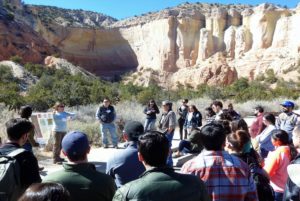
- I imagine everyone heard that the governor signed the budget the other day. There were a few items vetoed and a number of our sister institutions had their construction projects wiped out. but the budget changes for HU were minimal in comparison. Some key points regarding our budget situation as of right now:
- last year, our budget was cut approximately $1.8mil,
- the “new money, approved in this year’s budget is about $978 (about half of what we lost last year) and much of that will go to the compensation increases. I should also note that we’ll have to come up with approximately $60K to pay for employee related costs tied to these compensation increases,
- our unavoidable cost increases this year (i.e., insurance, etc.) will be about $500K, and
- the total new requests from our internal budget process totaled about $13mil. That was whittled down to about $1mil of new spending…assuming we can do anything new at all.
The bottom line for me this year…the budget is much better than last year’s situation (and the previous year’s), but we remain well behind our funding level from several years ago. Plus the heavy reliance on extraction in the state portends difficult times ahead. Gas and oil are so cyclical. Still, I’ll take some forward movement this year.
- Friday will be a busy one—a Coffee With The President session at 10:00 a.m. followed by an Executive Management Team meeting at 1:00 p.m. followed by a donor dinner at the university residence at 6:00 p.m. After a busy week (Sunday- Wednesday) in Chicago, a lecture in Rio Rancho on Thursday, and Friday’s activities, I look forward to the weekend and a little down time. I hope you have a good one as well.
10.HLC Update: The IAC meeting is over. We’ll receive their report in a few weeks. I’ll let everyone know.
11.Retention Update: Our retention metrics are moving in the right direction.
- First-time freshmen fall-to-spring retention up from 72% to 76%
- First-time transfer fall-to-spring retention up from 77% to 85%
- First-time freshman 4-year completion increasing in last several years from 8% to 10.4% to 10.9%
- First-time freshman 6-year completion increasing from 17.9% to 22.2% for the last two years
- First-time transfer 2-year completion increasing from 28.2% to 35.8% to 40%
- Fewer first-time freshmen were on academic probation after the first semester
- The average credits earned by first-time freshmen has increased
For more information, please see the Persistence and Completion web page on the Highlands website, where the Retention Forum recordings and PowerPoints are posted along with additional information about Retention Advisory Council, Matriculation Taskforce, and the HLC Persistence and Completion Academy project.
A good quote I read this week—this one about innuendo in various media sources (newspapers, social media, etc.), “…and everyone knows you can’t disprove a rumor.” True. True.
A major study on faculty job satisfaction was released this week. A quote from that study:
“Contrary to previous studies (Howell, Load, Callahan, Servis, & Bonham, 2009; Pfeffer & Langton,1993), salary levels did not demonstrate high impact on faculty satisfaction for most participants interviewed. Many stated they would appreciate a higher salary (especially those at master’s institutions) and two (at doctoral-level institutions) spoke strongly about salary
compression that had affected him or her adversely. However, other participants generally gave salary less weight among the overall factors that contribute to their satisfaction. Several participants who had been employed as faculty members for many years expressed appreciation that their salaries had grown over time. Overall, participants commented that the benefits of a faculty lifestyle far outweighed their concerns about salary. A comment typical of responses on salary: Everybody wishes their salary was more—me included —but I have to say that I am satisfied with my salary. I think, you know, I’ve always viewed my job as a faculty member, that I am paid to pursue my own interests…I have always felt very privileged to be a faculty member.”
If you care to access the complete study, go to:https://www.tiaainstitute.org/sites/default/files/presentations/2018-03/Faculty%20Job%20Satisfaction_Webber_rd142_March%202018.pdf.
The Noble Piper says, “Awaiting the report from the IAC, but as you can see…not really all that worried about it.”
Greetings colleagues. A brief update for the week of February 26-March 2:
- On Monday I had a conference call with other presidents in the RMAC. The focus was on what we should do, if anything, to attempt to brand the RMAC in some different and or more powerful manner. I really enjoy working with the other RMAC presidents. They are a very thoughtful and smart group of people. When we meet, we mostly talk about athletics (as you might guess), but I pick up many ideas from them about all kinds of things—academic programs, retention efforts, and many ideas that are central to our mission. There may be an opportunity for faculty and staff with an interest and or expertise in branding to join a small work group to look into this. Please let me know if you are interested.
- The EMT met on Tuesday, as usual, and began the meeting with a discussion of learning outcomes. I’d say they are ubiquitous in modern higher education today, but I would not say that even now everyone (administrators, faculty members, staff members) believes that the focus on learning outcomes, at least the way that is played out these days, is a good thing. We read two articles—one very recent and one a few years old: https://www.nytimes.com/2018/02/23/opinion/sunday/colleges-measure-learning-outcomes.html?smprod=nytcore-ipad&smid=nytcore-ipad-share and https://www.insidehighered.com/views/2016/04/07/essay-value-student-learning-outcomes-measuring-and-ensuring-academic-quality. The first article appeared in the Times and was brought to my attention over the weekend by a great friend of HU, Martha McCaffrey. The second piece is by Peter Ewell, a noted expert in higher education assessment. Dr. Ewell was on the board when I worked at Truman State. He is really a great scholar and it was wonderful to have him on our board. The assessment culture was very much alive and well at Truman. That institution was known as an early-adopter of higher ed assessment and lots of people from around the country (and even the world) visited the campus to see how things worked there. It really wasn’t rocket science. We had a faculty assessment committee, a campus assessment “day” where we focused on campus outcomes and outcomes in each discipline, and in addition to disciplinary assessment, every three years we focused on one campus-wide kind of outcome. During the time I was there, I recall working on writing, mathematics, and civic engagement. We also published an annual assessment almanac and routinely devoted some time to examining it, thinking about changes in our assessment approach, etc. The thing that struck me there was the overall commitment to assessment. Faculty were very engaged in assessment activities and new hires were socialized into that culture. At any rate, our own discussion was a good one and several points of view were expressed about assessment of learning outcomes in higher education generally and here at HU. It was a thoughtful discussion. Later, we had one final discussion about our IAC presentation. Brandon distributed some executive summaries of our institutional performance. All members of the team will have these at their disposal so there is no chance of anyone using different numbers. This summary appears above if you’d care to peruse. We finished our time together with a brief discussion of the upcoming board meeting. The focus of that meeting will be on a variety of fiscal matters. The board has also requested a more in-depth presentation of some topic—this time we’ll have a discussion of tenure (history, contemporary ideas about tenure, how tenure works at HU, etc.).
- On Wednesday, I greeted about 900 GEAR Up (middle and high school) students from numerous New Mexico schools. Well done to Benito Pacheco and other team members for bringing this to HU. Benito is such a great soldier for HU. A real professional. GEAR Up is a federal program, initiated by former President Clinton, to encourage middle and high school students to participate in some form of post-secondary education. This group was perhaps the largest number of middle and high school students we’ve ever hosted on our campus. Of course, we went all out to interest these students in HU. I was also honored to introduce Mr. Dominick Baca to the students. Mr. Baca is an HU alum, a former basketball player for HU, and is currently the Gear Up Coordinator at Pecos. He also serves as a basketball coach there. The main guest speaker was Mr. Manny Scott. Mr. Scott was a student in Erin Gruwell’s English class—a group now known as the Freedom Writers. A photo of the event and a photo of Mr. Scott:

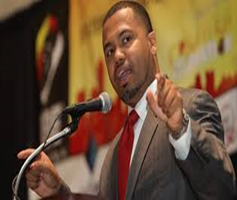
- I came across an interesting tool to assess the culture of academic departments. Several researchers at the University of Illinois received a grant from the National Science Foundation to develop this simple instrument. The instrument, called the AUDIT, supposedly allows departments to more objectively asses the internal culture and hopefully, point toward some paths to improvement. Here’s the entire article (https://www.insidehighered.com/advice/2018/02/28/tool-diagnosing-professional-culture-academic-units-opinion?utm_source=Inside+Higher+Ed&utm_campaign=a4811a130e-DNU20180111&utm_medium=email&utm_term=0_1fcbc04421-a4811a130e-198622925&mc_cid=a4811a130e&mc_eid=1b6e1fa6ce) and here’s the instrument:
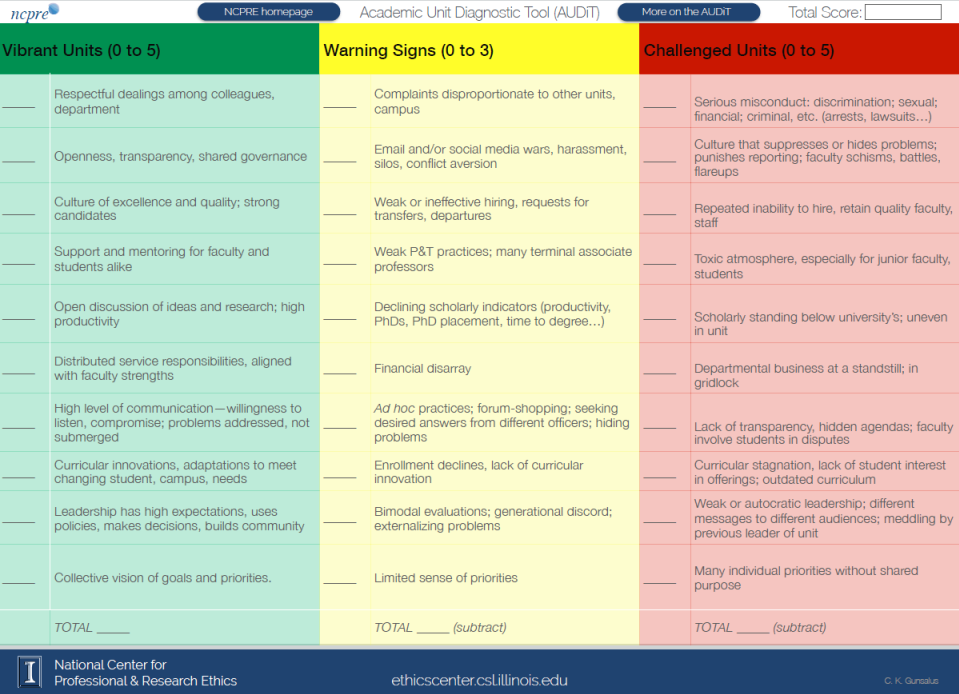
- We had an all-day board meeting on Thursday. The board approved a policy to strengthen the university’s commitment to our fiscal responsibilities. The Policy on Financial Stability, approved unanimously by the board, directs Highlands’ administration to build a reserve that would protect Highlands from an unexpected loss of revenue. Our goal is to build an $8.5 million reserve to weather any substantial loss of state funding or drop in tuition revenue. The new policy also requires an increased level of transparency to include quarterly reports to the board on the university’s finances by the vice president of finance and administration as well as a report in the first quarter of each year of the university’s audit findings and any associated action plans. I know building a reserve is not one of the most exciting fiscal goals, but for the long-term health of the university and our ongoing commitment to the accreditation process, it is of paramount importance. To that end, the Board of Regents heard several tuition proposals to move Highlands’ initiatives forward. Several students voiced their thoughts on a possible tuition increase. It was not surprising that each student was against another increase, and I sympathize with their reasoning. No one wants to pay more for rent. No one wants to pay more for utilities. No one wants to pay more for groceries. And no one wants to pay more tuition. If it were up to me, college would be free in the United States like it is in many other countries. But the reality is Highlands faces increased costs in budget items like utilities, insurance, software escalators, promotions, etc. while seeing declining state appropriations. There are three ways we can address state cuts: enrollment, donor giving, and tuition. The board will schedule a meeting within the next few weeks to deliberate on the tuition proposals. Related to finances, the board also approved a policy and vendor for a university purchasing card system, which will streamline a large percentage of our procurement at Highlands and alleviates the need for employees to buy business items and wait to be reimbursed. Purchasing Director Adam Bustos has put in a great deal of time and effort to bring this system to Highlands, and I appreciate his effort. The Purchasing Department will start testing a pilot program with a few units before rolling it out to the campus. For the board’s deep-dive discussion, the regents heard a presentation on tenure from Provost Roxanne Gonzales. The provost and I agree a strong tenure system is vital to a university’s wellbeing. I am and have always been a strong proponent of tenure. It provides a commitment to our faculty, a commitment to our students, and furthers the pursuit of truth. Any suggestion that tenure is currently “under attack” at HU is patently false. Maybe that was true in the past. Not now. As a rural institution, tenure plays a vital part in the ability to recruit talented faculty members. The majority of undergraduate students in the country are taught by non-tenure track faculty, and I do not want to see that happen at Highlands. I am happy to report the board feels the same way. Lastly, the board voted on its officer assignments. Chairman Leveo Sanchez will continue in his role, Regent LouElla Marr-Montoya will serve as vice-chair, and Regent Frank Marchi will serve as treasurer. I also reported that an HU team will be traveling to Chicago Sunday to appear before the HLC’s Institutional Actions Committee. I remain optimistic that our presentation will be successful as it is the story of the Highlands family and the incredible work you all put into making New Mexico Highlands University a great institution.
- Heard from our Jefferson Science Fellow, Dick Greene, this week. He is currently working in Tegucigalpa and then on to Cairo. He reports he misses the “easy” life in New Mexico. I asserted it was not easy at all…only beautiful.
- HLC update: Our team (me, Brandon, Roxanne, and Max) leave for Chicago on Sunday. Our time with the IAC is on Monday. Once again, after that meeting we’ll have an opportunity to provide the HLC Board with one more update of our accomplishments and then we simply wait for the board to meet. As is always the case, I probably will not have any useful information or feedback after the IAC meeting (they are pretty close-mouthed about things), but I will provide the campus with my impressions. But…it will only be that…impressions. I am certain I will not be able to say anything definitive at all.
One of the most interesting things I read this week…this from Christian Smith, a professor of sociology at Notre Dame. His article,Higher Education Is Drowning in BS, appeared in the February 9, 2018 edition of The Chronicle Review.
“BS is the university’s loss of capacity to grapple with life’s Big Questions, because of our crisis of faith in truth, reality, reason, evidence, argument, civility, and our common humanity. BS is the farce of what are actually ‘fragmentversities’ claiming to be universities of hyperspecialization and academic disciplines unable to talk with each other about obvious shared concerns. BS is the expectation that a good education can be provided by institutions modeled organizationally on factories, state bureaucracies, and shopping malls—that is, by enormous universities processing hordes of students as if they were livestock, numbers waiting in line and shopping consumers…BS is the ideologically infused jargon deployed by various fields to stake out in-group self-importance and insulate them from accountability to those not fluent in such solipsistic language games. BS is a tenure system that provides guaranteed lifetime employment to faculty who are lousy teachers and inactive scholars, not because they espouse unpopular viewpoints that need the protection of academic freedom but only because years ago they were granted tenure…BS is the failure of leaders in higher education to champion the liberal arts ideal—that college should challenge, develop, and transform students’ mind so they can lead good, flourishing, and socially productive lives…”
I also really liked this one by Matt Reed. It appeared in INSIDE Higher Education, February 18, 2018. The title is Whose Skin? Which Game?
“The hot policy topic around higher education right now is “risk-sharing,” or what sometimes gets called ‘skin in the game.’ It’s the idea that colleges should bear some of the risk for payback of student loans, so they’ll have an incentive to turn their back on risky students. Sorry, I misspelled ‘do a better job.’ I’ve mentioned before that for open-admission institutions, the concept is inherently silly. We don’t control who shows up, and we don’t control access to student loans. We also don’t control recessions. Given those ground rules, ‘accountability’ is merely punitive.”
The Noble Piper says, “Good luck to the IAC Team!”
Greetings colleagues. A brief update for the week of February 12-16:
- Many good HU colleagues continue to play very active roles in professional organizations and achieve recognition for their professional accomplishments. This brings high distinction to them, to HU, and helps the campus connect to national and international developments in higher education. When faculty are involved in those high level activities, our students also benefit in many ways. Dr. Jesus Rivas was recently asked to serve as an Associate Editor of the Journal of Herpetology. This is a top journal in Jesus’ field and is a great professional accomplishment. I have also received a request from the State of New Mexico Department of Game and Fish to appoint Dr. Rivas to serve as a peer reviewer for a listing investigation focusing on White Sand Pupfish, a species of fish found nowhere else in the world. Dr. Seonsook Park, Chair of the Curriculum and Instruction Department at the SOE and Dr. Rodolfo Chavez, Director of the 2+2 National Professional Development Grant have been invited by the National Council of State Title III Directors to join a panel on methods and strategies to help bilingual families, schools, communities and students succeed in schools. The panel is a preconference presentation to the National Association of Bilingual Education (NABE) conference which is holding its 45th national conference in Albuquerque in March. They will join Drs. Wayne Thomas and Virginia Collier, well-known national researchers in the area of designing effective methods and models to assist dual language learners. Dr. Chavez served as President of NABE in the early 90’s and to this day he continues to contribute to and be involved in the association where he has been a member for over 40 years. Both Dr. Park and Dr. Chavez have been most recently collaborating in a $2.2 Million Grant for Teacher Education that NMHU received a year and a half ago. The grant is based on a “grow your own” model where 30 existing bilingual ESL paraprofessionals (from Santa Fe and Espanola) were recruited and are being mentored and supported until they complete their B. A. in education from NMHU. Finally, Dr. Gloria Gadsden has been recognized by the New Mexico Office of African American Affairs for her mentorship work. Good strong mentorship is highly predictive of college completion and other positive outcomes and clearly Gloria provides that to many students. All that takes more work and effort and I really appreciate it. Congratulations to Jesus, Seonsook, Rodolfo, and Gloria! Well done to all. A photo of the White Sands Pupfish (a little hard to see):

- On Monday I met with one of our good colleagues and we talked about several things, but focused on two topics—the apparent downward trend of collegial interaction in the academy generally and possibly here at HU and the best way of structuring any enhancements or growth in online programs. In regard to collegial interactions, I think we agreed that they seemed to be diminishing across the higher ed sector. Both of our socializations into the academy supported a belief that ideally, professors should be around a lot and visible and accessible to their students and their peers. That many good ideas, some of which moved to action, were hatched during informal social activities during, before, or after work, but…all that seemed to be diminishing. We talked about why that might be true…if it is…and both hit upon the impact of technology in our personal and professional lives. Office hours can now be done from home. All you need is an inexpensive computer and a good signal. Participation in committees and the like can be done remotely, even if you are on campus. Instead of walking over to the SUB or wherever the meeting might be, people can “zoom in” from anywhere. There are advantages to that, of course, but….does it promote the kind of community we seek to engineer? Is the “frequently around, frequently accessible, see students at cultural events and restaurants, invite students over to your home” model of academic community really fading (or maybe already gone) resulting in older academics (like me) yearning for the “good old days” when the most productive meetings took place around the water cooler? I really can’t recall the last time I saw a water cooler. I think we also agreed that we became very close to several of our professors, in part because they were so frequently around, and that the relationships we formed with them were powerful influences in our professional and personal lives. We admired them. We really wanted to “be like them” and not just in regard to their disciplinary expertise. It was a good conversation and one I will reflect on. I encourage others to think about this as well. What kind of community do we aspire to engineer here? What are the elements necessary to make that happen? We also spoke about the best way of structuring online programs. Specifically, should they just be one element of the discipline? That is, if you support a campus based program in a discipline and an online option in that same discipline, should that single discipline be expected or required to deal with all of the issues related to program delivery, should the faculty working in each type of program be managed the same way (e.g., should faculty who only teach online be tenure-track?), and how should budgeting for all that work? I’ve seen both models…everything handled within the discipline compared to a stand-alone unit (college, school, etc.) dealing with online programming. I know for a fact it can work both ways. I’ve seen it. Once again, I welcome your reflections about all this and also welcome any conversation you’d care to have with me about either of these topics.
- On Tuesday, I and several other HU leaders met with Dr. Rick Bailey, President of Northern New Mexico, and his leadership team. We met in Santa Fe to discuss how we might more powerfully collaborate on a variety of projects including academic projects, back-office programs (HR, Procurement, etc.), student life initiatives, and others. The two institutions are similar in many ways. We serve a similar student demographic, promote a student—centric focus, and frankly, share some common challenges. It was a really great conversation and we made some specific plans to move forward. Rick is a great leader. More on this later, but if we could actually accomplish any of the things we discussed it would be a positive and beautiful thing. Good for us…good for them…good for the state of New Mexico, good all the way around. Also on Tuesday, we had a mock IAC session. A nice group of staff members, faculty members, and administrators played the role of the IAC committee and asked me and other members of the team questions. Brandon did a good job of drafting some likely questions ranging from a few softball examples to pretty tough questions. He refused to show us the questions beforehand so just as will happen at the IAC meeting, there was no way to prepare. As will be the case with the IAC, I took the lead in responding to the questions. I think I did pretty well, but clearly there is room for improvement and I will work on the responses that were the weakest. Many thanks to the colleagues who took the time to attend the session.
- My latest Op Ed recently appeared in The Optic. The link is attached if you care to peruse.http://www.lasvegasoptic.com/content/three-more-bad-ideas-reform-higher-education
- We held our EMT meeting on Wednesday and began the meeting with a discussion of teaching loads. What is an appropriate teaching load in general and specifically here at HU? What is lost if a faculty member teaches a 3/3 load? Does that signal that the commitment to students and teaching is somehow diminished? What is lost if a faculty member teaches a 4/4 load? Does that put unreasonable pressure on faculty members to work on their scholarship in the evenings and or weekends? Is it really smart to require everyone to teach the same number of classes? Aren’t some faculty members better at some things than others or perhaps more interested in some things than others? Should the teaching load be the same over one’s career? That is, you’re a new assistant professor. You teach 4/4. You’re an associate professor at the peak of your career. You teach a 4/4. You are a full professor looking at the end of your career. Still 4/4. Does that really make sense? Perhaps most critically, what principles should guide the teaching load at a given institution? Let’s maybe start there and work backward toward a good resolution. We read these two papers: https://www.chronicle.com/article/So-You-Want-to-Work-at-a/240975 and https://www.nytimes.com/2015/05/10/opinion/sunday/whats-the-point-of-a-professor.html. The remainder of the meeting focused on preparation for the IAC meeting, commencement, an update from Max in regard to the legislative session, and a few other items.
- Also on Wednesday, Ian, Roxanne, and I met with a representative from the University of Texas (UT) system. The UT system has bid on the management of LANL. That’s public knowledge so I am not revealing anything confidential. The management decision should be made this spring. We talked about the interactions we have now with the Lab and how those might be enhanced. It was a good discussion and I am very optimistic that, should UT win the competition, we’ll form a strong and productive partnership. I should also note that our visitor commented on the appearance of the campus…how nice it looked…how welcoming. I sincerely thank our wonderful grounds crew for the work they do every day to make our campus look so nice. Like virtually every unit here at HU, that unit is so stretched and not funded anywhere close to what it should be. And yet, they do such a great job. My thanks to them.
- On Friday and Saturday, HU will host the NCAA Division II West Super Regional Wresting Championship. Dozens of collegiate wrestlers will compete in Wilson beginning at 11 a.m. on Friday. If you have the opportunity, drop by and see top notch college wrestling right here in Las Vegas.
- Things still look positive in Santa Fe. We hope the governor will approve the budget as is and if she does, we’ll have some additional I&G dollars, some resources to restore what we’ve lost in athletics over the years, some money for infrastructure support, and resources for compensation increases. Let us hope.
- On Thursday, I met with several HU Foundation committees. I so appreciate the work of those folks. They do a huge service to HU and are among our greatest advocates. Today (Friday), I once again drive to Santa Fe—this time to meet with the Alumni Board and attend a social with those individuals afterward. Saturday will also be busy—an H Club event, the wrestling tournament, and the final basketball game of the year.
10.One of my mentors once told me that the words and actions of leaders in higher education are so carefully scrutinized because American higher education is so important to all of us. Really—important to the nation as whole. That all sounds about right to me and since I think it is true, it is not surprising that I receive lots of private and public advice about to handle things and reflections about how I have handled things ranging from emails, to phone calls, to conversations out in the community, to letters to the editor, Op Eds, and more. I really appreciate each and every one of them and I mean that. Maybe I agree with them. Maybe not. Some assertions might be true (I really did say or do that…perhaps unfortunately). Some are not, at least from my perspective. But, it does mean that people care enough to express themselves and chime in. I do reflect on that input and sometimes make changes as a result of it. But, what to do to address all this when I disagree or even believe that something is not accurate? Mostly, I do nothing at all because devoting time and energy to that kind of thing could literally take most of my time. I’ve often heard the saying…I love rumors. They tell me so many things I didn’t know about myself. Over the last several weeks, for example, I’ve heard that Joan and I are leaving Las Vegas (a good title for a film, no?). I’ve also heard that we will be or already have purchased a home here. Neither is true at all. I’ve heard an assertion that HU executives are purchasing large screen televisions for their offices and that I am OK with that. I don’t usually get involved in TV purchase controversies, but I think I know what this one is about. When I arrived on campus on July 1, 2015, there was a flat screen television in my office. I had no idea how long it had been there and I don ‘t think I ever turned it on a single time. I did not even know where the remote control was…so it just sat there. One of my colleagues asked if it could be moved to his office so it could be used to display large spreadsheets at group meetings. I said OK. It was moved. A related assertion I recently heard was that yet another person purchased a large TV (I wondered…was there a sale somewhere?) and I checked that out. It wasn’t true. There was no big TV in that person’s office and nothing new had been purchased at all. Enough about TVs, but if anyone can help me program my DVR I’ll gladly accept that assistance. What else? The swirl regarding Luna CC has been rather incredible. Our official position—-LCC is extremely important to Northern New Mexico. We all must work with the folks there to help, as we can. For those of us at HU, “helping” does not mean making any plans or moves to play a larger role there. We wish our LCC colleagues luck as they face their challenges. That’s it. I heard I had accepted a job out of state…at a specific institution…at a specific salary (that, I should add, was really great!)… and would make an announcement about all that next week. There was so much specificity in that one that I wondered if maybe some Sam Minner doppelganger was in the world and perhaps buying homes, moving, taking new jobs, checking off on TV purchases, and engaging in other mischief, but of course I don’t believe in doppelgangers and I have taken no other job. My contract was just extended. Joan and I are very happy here. My point in all this—if any member of the community hears something, reads something, etc. and asks me about the claims they’ve heard or read, I’ll honestly answer them to the best of my ability. You can call me, email me, or better yet, just bring it up at one of my open monthly meetings. Given the job I have, I do feel that I need to be as open as possible in virtually all matters. Some things are clearly too personal and off limits from my perspective, but that’s a very short list. As president of the university and the face of the university, I need to be as open as possible. I believe I have been open—I have tried—and will continue to behave that way. Years ago, I heard a talk by Sir Terry Pratchett, author of many fantasy novels. For whatever reason, throughout his life he battled against rumors that he was dead (he is actually deceased now, so I guess the rumor finally came to pass). Maybe this is a common problem among authors (Mark Twain?). I can say that it was a problem for Sir Pratchett. At any rate, I remember him saying something that stuck with me. This isn’t an exact quote, but the gist was, “A rumor can make its way around the world before the truth puts on boots.”
Maybe the doppelganger idea is true. Someone recently sent me these photos. If you can’t tell—a younger version of me is on the left. My doppelganger is on the right. I guess doppelgangers are real.
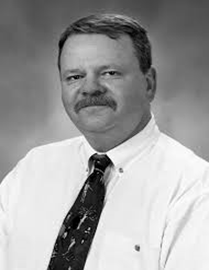

11.HLC Update: Not much to report. We are putting the final touches on the IAC presentation. All travel arrangements for that meeting have been made. After we meet with the IAC, we’ll provide a brief update and then we basically wait for the HLC board to meet this summer. As soon as we hear from the HLC Board, I’ll inform the campus.
One of the best things I read this week…this from When Failure Is OK Is Not OK. The article was by Tyler Hallmark and appeared in the February 16, 2018 edition of The Chronicle of Higher Education.
“ Instead of ‘It’s OK to fail,’ here’s what we should be saying to low-income and first-generation students. First, tell them they are good enough, because many of them probably haven’t been told that very often. As soon as they step on campus, we need to combat any imposter syndrome—the feeling that one is a fraud who doesn’t deserve success—that they might be experiencing. As much as we consider imposter syndrome an individual problem, overcoming it should be a group effort that involves professors, counselors, and administrators…For low-income and first generation students to persevere, one of the first steps needs to be inclusiveness. That means acknowledging the privilege that comes with saying “Failure is OK” and realizing that such blanket statements are not only dismissive of some students’ struggles but also can actually be harmful to their success.”
The Noble Piper says, “Congratulations to the USA Women’s Hockey Team. What a game! What a victory!”

Greetings colleagues. A brief update for the week February 12-16:
- Last Saturday, we held the HU Loves Alumni event. We heard some great jazz (thank you Smooth Riders), ate some wonderful food (The Skillet comes through again), and enjoyed some creative libations including a “125th” HU signature cocktail (thanks Borracho’s team). The evening included a silent and a live auction and we made $3750.00—about $500 more than last year. Well done to Juli, VP Law, and the entire advancement team. A few photos from the event:
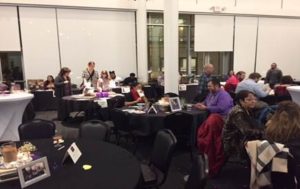
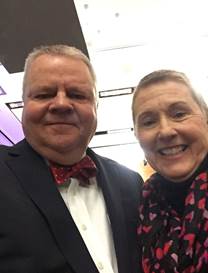
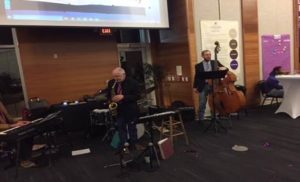
- After quite a bit of back and forth, we finally finished the MOU with Seokyeong University in South Korea. We hope to receive students from Seokyeong and perhaps engage in some faculty exchanges as well. Seokyeong University currently enrolls about 8000 undergraduate students and about 400 graduate students. Many thanks to Ms. Tina Clayton and Dr. Edward Martinez for their hard work to make this happen. A photo of Seokyeong University:

- On Monday, Ilfeld screened a new film, Making a Killing. The film was shot mostly in and around Las Vegas, N.M. and starred, among others, Christopher Lloyd of Back to the Future fame. We attracted quite a decent audience for a cold February Monday night. If you missed the film, you might want to look for it at some point—lots and lots of scenes of our beloved city and some of our colleagues were extras in the production. Much of the film was shot in a local Victorian home—a block or so from campus.
- Dean Virginia Padilla-Vigil has been invited by PED to join the Professional Practices and Standards Council (PPSC) and has additionally been asked to chair the PPSC. Her term will be for three years. The purpose of the PPSC is to ensure that high standards are maintained in the preparation and practice of professional licensed school personnel. The creation of the PPSC recognizes that persons licensed by the PED comprise a profession, with all of the rights, responsibilities and privileges accorded professions, having their first obligation to the public they serve. The primary responsibilities of this profession are to educate the children of this state and to improve the professional practices and ethical conduct of the members of the profession. Congratulations to Virginia and thanks to her for going the extra mile to engage in this important task. Well done!
- We continue to show some decent results using the RNL DemandBuilder product. For example, as of 2/5/18, we sent 25,784 emails to a select group of sophomores and juniors (we can no longer afford to only recruit high school seniors…we have to build a pipeline). We purchased these names from three different sources in four markets. Market #1 consists of the New Mexico counties we have historically done well in—mostly Northern New Mexico counties. Market #2 consists of all other New Mexico counties…places we’ve drawn from, but not as well as Market #1. The third market consists of our top draw counties in Arizona, California, Colorado, and Texas and Market #4 is the remainder of the United States, but even the emails in that overall U.S. market were screened for students in our demographic. No random emails hoping for some interest. Of the 25,784 emails we sent, 1431 prospective students at least opened the message; an overall “opened rate” of 5.55%. According to our consultants at RNL, this is about typical. We are also in the middle of our Senior Search Campaign. We sent 9,980 emails to high schools seniors (same markets as noted above) and 5.68% of them opened the message. Dr. Martinez is doing a good job managing these data and his team is working hard to improve our enrollment. They deserve our sincere thanks.
- On Tuesday, House Bill 2 passed the senate. At this point, we did pretty well, but of course, there are several steps to get all this done. Overall, UNM received a 2.3% increase, NMSU received a 1.3% increase, Western received 4.3%, Eastern New Mexico received 2.0%, Tech received 1.6%, and Northern received .7%. We received 2.3%, so only Western fared better. Please keep in mind that none of this is certain. On March 7th (20 days from Thursday), legislation not acted upon by the governor is pocket vetoed. Much our success this year must be credited to Max who tirelessly worked in Santa Fe to connect with the right decision makers and promote HU to all who would listen.
- Also on Tuesday, our Advancement Team hosted a Mardi Gras lunch…it was Fat Tuesday after all. Not sure who found the figurine in the cake. Laissez les bon temps roulez! Mardi gras ne va pas mieux qu’à Las Vegas, au Nouveau-Mexique!
- I had an Op Ed published on Monday in the New Mexican and kind of unbelievably to me, I’ve had more than 30 emails from people around the state and nation commenting on it…mostly (but not all) positive. So it goes. Here it is:
Three more bad ideas to reform higher education
By Sam Minner
New Mexico’s higher education is, once again, on the minds of many of our elected officials during this year’s legislative session, and lots of ideas to improve our state’s higher education have echoed around the statehouse. Some ideas had merit. Some did not. Here are three bad ideas I recently heard:
Merge Institutions
Some legislators and citizens seem to think that New Mexico has too many institutions of higher education and merging some of them would somehow result in savings and or improved performance. This has been tested across the nation, and the poster child for higher-ed mergers is the state of Georgia. A report assessing the cost reductions of mergers in that state yielded a system wide savings of about 1 percent. All the hard feelings in the communities where those institutions were located; all the controversies; all the time, effort and energy to make the necessary changes — for a 1 percent savings? Aside from savings, some believe that mergers will somehow result in improved outcomes like better retention and graduation rates. After mergers, some schools have seen improvements in those areas, but universities that work closely together in a coordinated manner have seen similar results without mergers. Coordinated efforts like common course numbering can improve outcomes, and Higher Education Department Secretary Barbara Damron is leading an effort to make that happen. Merge schools without very careful thought? A bad idea.
Bust Unions
Another idea I heard during the legislative session was to take actions to reduce the power of unions on college campuses or eliminate them altogether. Again, this is a very bad idea and one I oppose. Unions of various types have played a major role in building an American middle class, bringing all members of organizations together to talk and plan, which often leads to improved performance. In the education sector, an organization’s performance is largely predicted by the commitment, the passion and the efforts of those who matter most in the organization. In the case of higher education, those individuals are faculty and staff members. Unions are not the only way to bring people together to make things better, but they have been effective in achieving that goal in the past and do so today. Bust unions in higher education? That’s a bad idea.
Accelerate College
Finally, another very popular but troublesome idea is the overall acceleration of the college experience. The thinking goes something like this: Enroll students in as many dual-credit classes as possible. Then, once they are at university, get them to declare a major or a meta major (a group of similar disciplines like health or science) as quickly as possible. Next, reduce all majors to no more than 120 hours and provide incentives to convince students to enroll in 15 semester hours of classes or more per term. Taking these steps will undoubtedly get students to graduation faster, and that is desirable in many ways. But, what is lost in this approach? Try a little experiment. Watch a great film on fast forward. Get through it as quickly as possible. Did the film have any impact on you? Or, speed read a beautiful poem. Or, walk through an art gallery as quickly as possible. Or, perhaps more critically, allow yourself a minute or two — no more — to reflect on what it means to live a good life – to live a life of meaning and purpose. My point is simply this: Many important outcomes of a higher education simply cannot be achieved quickly. If you think it is important to appreciate the aesthetic dimensions of life, to reflect on one’s own existence, and develop the tools to think critically; that cannot be done quickly. It just isn’t possible.
Higher education is incredibly important in New Mexico and in our nation. Everyone wants to improve the performance of our colleges and universities, but not all changes and not all new ideas are necessarily good. Let’s be smart about the changes we make. Merging institutions in our state, attempting to diminish the ability of faculty and staff to speak through union representation, and speeding up the college process will not make our schools stronger.
They are bad ideas.
Sam Minner is president of New Mexico Highland University.
- HLC Update: On Tuesday, we held our first HLC prep meeting. Brandon, Max, Roxanne, and I met along with Sean to practice our time with the IAC. We devised the basic structure of our presentation and I think everyone felt good about it. Next Tuesday, we’ll engage the EMT in a mock session—ask them to shoot hard question to us—probe the areas we anticipate the IAC will focus on, etc. After that, we’ll have a general campus meeting to go over things, respond to questions, etc. I assure everyone that we’ll be ready.
Favorite thing I read this week:
“I have never understood the D grade. As I’ve written a few times over the years, the D grade is neither fish nor fowl. It’s passing, sort of, but its grade point value is below the minimum to graduate. D’s don’t transfer, except when they do. In some sequences, they don’t allow forward progression. They can count against satisfactory academic progress, since they fall below a 2.0. The ambiguity of the D, I think, is a function of the ambiguity of the C. Is the C supposed to be average, or the minimum acceptable level? If it were the former, the D could connote “below average.” If it’s the latter, then I don’t know what the D (or the C-minus, for that matter) connotes. Given that most colleges don’t accept anything below a C in transfer, I’d argue that we’d decided as a sector that a C is a minimum. To the extent that’s true, the D doesn’t make any sense. D’s raise equity issues, too. For a student who starts at a community college and transfers to, say, Flagship State U, a D may not transfer. But for a student who starts at Flagship State, an otherwise-solid GPA can carry a D or two. D’s get degrees, but only sometimes, and only if you started in the right place. Holding transfer students to a higher standard than native students isn’t a good look, especially when you compare the racial composition of the two groups, but that’s where we are. I know I’m likely to get a torrent of “but what about grade inflation?” comments, but I don’t see eliminating the D as encouraging grade inflation. I see it as bringing clarity to what counts and what doesn’t. Besides, in studies of grade inflation, community colleges have been relatively immune; the really rampant inflation occurs at the most selective institutions. I just don’t see the point of passing students along who are destined to hit a wall when they try to take the next step.” From I Knew It! By Matt Reed in the February 11 edition of INSIDE Higher Education. To read the whole thing, go to:https://www.insidehighered.com/blogs/confessions-community-college-dean/i-knew-it.
I also liked this one from the Careers Section of the February 9, 2018 edition of The Chronicle of Higher Education. That really great weekly series is written by David Perlmutter. He writes,
…in higher education, we “hire on CV and fire on fit.”
The Noble Piper says, “Totally in favor of infrastructure spending. As long as it includes dog parks.”

Sam Minner,
President
Greetings colleagues. A brief update for the week of February 5-9:
- Here’s an email we sent this week to prospective students using the RNL DemandBuilder product. This message was sent to thousands of students screened to predict their potential interest in HU. No more scattershot messages to just anyone’s email. That doesn’t work. The actual email we sent looks better than this one, but this will give you a good idea of the content:

New Mexico Highlands University is a small school that’s big on…
Quality.
Like hiring the best professors—the kind that are experts in their fields and who also care about you and your goals.
Affordability.
Highlands boasts the lowest tuition in the state and the third lowest in the southwest.
Diversity.
You’re not just a number here—you’re part of a welcoming family that celebrates each other’s differences.
Adventure!
Las Vegas, NM is within minutes of state parks and ski resorts. (And our students enjoy free outdoor recreation trips and other activities)
Complete your reply form to hear more about majors, financial aid, and your next steps.
ALREADY KNOW HIGHLANDS IS THE PLACE FOR YOU? APPLY TODAY
New Mexico Highlands University
Box 9000, Las Vegas, NM 87701
505-454-3394
- I heard from Dick Greene, our Jefferson Fellow working in D.C. this year. He is doing well, working hard on a variety of projects, and raising heck as everyone would expect. He sent me his latest co-authored manuscript and I’ve attached it (click here).
- We held our regular Executive Management Team meeting on Tuesday and started the meeting with a brief discussion of the possible (or real) hoops we ask poor students to jump through compared to wealthy or middle class students. We read this piece:https://www.insidehighered.com/blogs/just-visiting/free-college-catch. As you can see (if you read it), one idea in another state is to require drug testing for students who want access to financial support to attend university. Not middle class students. Not wealthy students. Just poor students. So, do folks at HU ask or even require poor students to go through things that other students do not? When a student misses class or is late on an assignment, do we think about what might be behind that? Maybe…they had to work a job a few extra hours to make ends meet or maybe their car broke down. If these kinds of things are happening and “explain” the problems, does it really make any difference? Some might and indeed do argue that all students—irrespective of their circumstances— simply must find a way to navigate their lives (including college) and it isn’t fair to be too “easy” on them. Is that a legitimate position? I think people around the table felt that most of their colleagues here at HU were pretty plugged in regarding the needs and special challenges of our students and that, in general, they did not require students to jump through more hoops than others. But, a few examples of behaving the other way were discussed. The bottom line, for me at least, is that the notion that poor people (or poor students for that matter) are poor and likely to remain poor because they do not try hard enough, do not put in enough effort, or do not behave as others facing fewer challenges is quite alive and well today. I see examples of it all the time. In most cases, I really don’t believe that. It was a good and thoughtful discussion and one I will reflect on, no doubt. The rest of the meeting was devoted to HLC matters, additional discussions about a commencement speaker, and an update from Santa Fe as the session comes to a close.
- Things continue to look good from the Roundhouse. Nothing is ever final until the ink is dry from the Governor’s signature, but…it appears that we will receive some new funds, some money for overall compensation increases, some restoration of the athletics budget (which has taken such a hit in recent years), some money for infrastructure, and perhaps some money for nursing, social work, and a few other items. I know I speak for everyone when I thank our elected officials for their hard work to devise a workable budget for our state. It is a tough job. Turning to Luna, the bill to merge the two institutions has been (at least) temporarily withdrawn. Again…our position—(1) we wish that institution (and all institutions) well as they face the real challenges in the 2018 environment, (2) we have not taken nor will we take any proaction to assume responsibility for that or any other institution, but (3) we do stand ready to assist in any way we can…but only if requested. However things work out at LCC, we should remember that the faculty there are our colleagues—doing essentially the same work we do each day—and the students there are hopefully—if we are lucky—our students someday. We wish everyone at LCC nothing but the best.
- The concert on Saturday was a great success. We sold about $55K worth of tickets and welcomed nearly 2,000 people to Wilson for the event. It was so great to see so many of our students, local community members, and folks from out of town enjoying the music, dancing, and having a good time. Well done to Dr. Kim Blea, Ms. Donna Martinez, our wonderful facilities crew, our PD, and everyone who made this happen. We have made no effort to determine the overall local economic impact of these events, but just as an estimate…if say 1000 of the 2000 people at the event had a meal and something to drink before the event (say, $50.00) and then purchased some fuel for the drive home (say, $25.00)…that would mean an single night economic impact of about 75K. Of course, if someone spent the evening in Las Vegas, that figure would increase considerably. I really don’t know if we’ll ever do some type of economic impact around these events—it takes time and money to do that—but I am confident this event and others we’ve done are good for our students and good for the community. A win-win.

I also heard many rave reviews about the opening act, Frank Ray. Frank did a late concert at the Serf and I heard it was standing room only (I can’t verify that—too late for me). A review of Mr. Ray’s work from Rolling Stone:
Sounds Like: Easygoing contemporary country with pop-soul hooks and a dash of Southwestern spice
For Fans of: Keith Urban, Chris Young, Eli Young Band
Why You Should Pay Attention: Frank Ray, a former police officer with the Las Cruces, New Mexico, force, left his full-time police job a few months ago and his country singing career has been accelerating rapidly since then. An experienced performer who had the chance to open shows for A Thousand Horses and Keith Urban with his previous band, Ray’s solo debut EP Different Kind of Country was released earlier in 2017. The EP’s forlorn lead single “Every Time You Run” is currently making its way toward the Top 20 of the Texas Regional Radio Report, a list highlighting the week’s most popular Red Dirt titles. In his song “Different Kind of Country,” Ray sings about the Hispanic immigrant experience in America, highlighting cultural differences but pointing out values – including family and hard work – shared with the country audience. “I wanted it to be a message to say, ‘Hey, we’re different but we’re very much the same,'” he says. “But also from a logistical standpoint, we can’t deport every single illegal immigrant – United States agriculture highly relies on that labor. We have to find a way to make it work.”
He Says: “My fiancé and I talked about it and she really knew this was important to me. It was funny the way she worded it – she said, ‘Everybody’s got confidence in you except for yourself.’ But it was just scary, especially after giving a decade of your life to the police department. It was scary to leave that comfort and stability.”
Our next performance will be from Black Violin. That duo will perform in Ilfeld. A nice video of one of their numbers:https://www.youtube.com/watch?v=J4n0BJhoMBU.
- I recently read an article in The Washington Post about things universities might do to rein in costs and save money. Not really new ideas, but still…worth thinking about. There were four of them: reduce administrative costs, operate the physical plant more efficiently, fund less what was referred to as mediocre research, and focus on delivering cheaper but better general education. I thought about these ideas relative to HU.
In regard to administrative costs, the recommendation was to “spend more on instruction than anything else.” We have some data on that. According to the most recent Performance Effectiveness Report (PEP), HU spends 59.8 percent of our resources on instruction, research, and public service and 14.1% on administrative costs. We look pretty good compared to our peers on this metric. Our peers spend 55% of their resources on instruction, research, and service and 15.7% on administrative costs. So, we are doing better than our peers on that.
Turning to the use of the physical plant, the recommendation was to distribute classes throughout the week and even Saturdays. The assertion was that college campuses sit idle too much of the time. I asked Buddy Rivera to provide me with an analysis of our usage by day. Here’s what he sent me:
Mon Tues Wed Thurs Friday Saturday Sunday
Courses (Plan) 408 364 351 346 131 36 2
Courses (Executed) 360 324 313 312 114 35 2
As you can see , we start strong on Monday, but fade throughout the week. On Friday, we offered only 114 classes and only 2 on Saturday and 2 on Sunday.
Funding less supposedly mediocre research? That’s would be hard to measure. For one thing, what’s “mediocre” from one person’s perspective is important from another’s point of view. Now, general education is another matter. Think what resources could be recouped…and reallocated…if we had a very lean general ed. program. Some schools do. Everyone takes two writing classes, one class in American literature, one class in poetry, and maybe one in some other area…and that’s it. I am not advocating this kind of approach, but man…it would really focus our efforts and allow us to reallocate quite a bit to other things. Now doing that would also reduce choices for students and that would have to be weighed against being so lean. But, maybe we should think about it.
- On Thursday evening, a large and upbeat crowd congregated at La Fonda in Santa Fe for the annual Las Vegas Night. We sponsored the event along with the City, San Miguel County, and Luna CC. It was a nice celebration of all things Las Vegas. A few photos of the event:
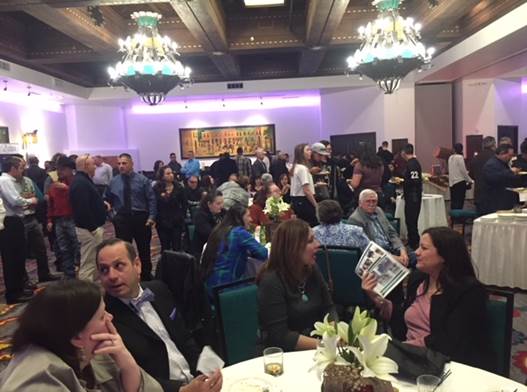
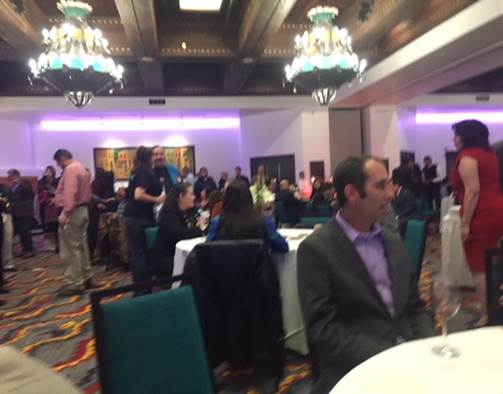
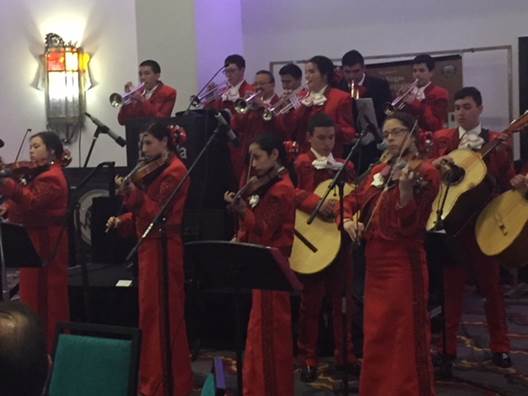
- HU Athletics continues to do some great things. Coach DeVries’ women’s team continues to do well against top notch competition. Our men’s basketball team is definitely in the hunt for post-season play (the game last Wednesday was really exciting…and a victory), our women’s basketball team continues to show tremendous grit, baseball and softball have started with some early victories, and football recruiting is well underway. We’ve got a new football field, some very nice renovations underway at Stu Clark, a relatively new gym floor in Wilson, and we’re in the early stages of engineering a campaign for additional athletic facilities. Here’s some of the new recruits who we’ll see in class this fall and on the football field. Note that we have some student athletes from Texas, New Jersey, Illinois, Georgia, California, South Carolina. Illinois, and here in New Mexico (and right here in Las Vegas). Also note that most all of these students are true freshmen—we’ll hopefully have them for four full years.
Darius Andrade OL 6-2 305 Weston, FL Cypress Bay HS
Corbin Anguiano OL 6-1 260 Pampa, TX Pampa HS
Elijah Boyd RB 6-0 240 Lubbock, TX Lubbock Cooper HS
Cameron Forziati DB 5-10 175 Sparta, NJ Paramus Catholic HS
Dondi Fuller LB 6-1 205 Fairview Heights, IL Belleville East HS
Devon Gonzales OL 6-4 270 Albuquerque, NM West Mesa HS
Joseph Gutierrez DL 6-4 235 Oxnard, CA Oxnard HS
Zach Hall DL 6-2 285 Cartersville, GA Cass HS
Trejen Lawrence DL 6-2 245 Amarillo, TX Amarillo Tascosa HS
Diego Lewis WR 5-9 165 El Paso, TX Andress HS
Emmanuel Lumanze Jr WR 6-1 182 Arlington, TX Bowie HS
Craig McRae LB 5-10 215 Rossele, NJ Abraham Clark HS
Jacobe Mills DL 6-1 280 Pampa, TX Pampa HS
Arjay Ortiz ATH 6-2 170 Las Vegas, NM Robertson
Matt Rodriguez QB 6-1 185 Ladera Ranch CA San Juan Hills
Netavion Thompson DB 5-11 170 Blacksburg, SC Blacksburg HS
Tyshun Turnipseed ATH 6-2 200 Chicago, IL Al Raby HS
In addition, Coach Doug Moses will soon be inducted into the RMAC Hall of Fame. Doug has had such a great career. He was a collegiate wrestler and an NAIA national champion. He coached at Adams State, CSU-Pueblo, and came to HU in 2001. He has coached more than 70 All Americans, 10 national champions, and helped shape the lives of hundreds of young men over the years. Congratulations to Doug—soon to be RMAC Hall of Fame inductee.
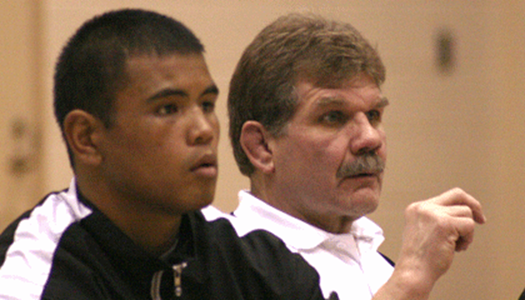
- HLC Update: The team attending the IAC meeting will practice their presentation next week. We’ll also schedule a more general meeting to get feedback from the university community. We intend to be fully and completely ready to go when we enter the meeting. Again, the IAC team consists of me, Brandon, Roxanne, and Max. We are limited to four people.
Favorite Quote Of The Week:
Follow-up research — led by a Skidmore professor who studies faculty work — revealed a dissatisfaction with workload and a sense that professors on campus don’t root for each other. That means we sort of have a mentality or philosophy that everybody’s got to run the gauntlet in the tenure process, said panelist Beau Breslin, dean of the faculty and vice president of academic affairs at Skidmore. That it has to be hard, rigorous work to justify the quality of the work that we do, and we don’t always root for each other as the process goes on.
From Less Is More by Coleen Flaherty in https://coache.gse.harvard.edu/news/less-more
The Noble Piper says, “I am starting a movement for a dog parade in Washington, D.C. I’ll lead it, of course. No military hardware. Also, no cats.”
Greetings colleagues. A brief update for the week January 29-February 2:
- Things are moving along with the Stu Clark renovation thanks to a generous donor. We’ll be installing a new bathroom, some new carpeting, some new video equipment, and other features. A rendering of some of the banners we’ll install:
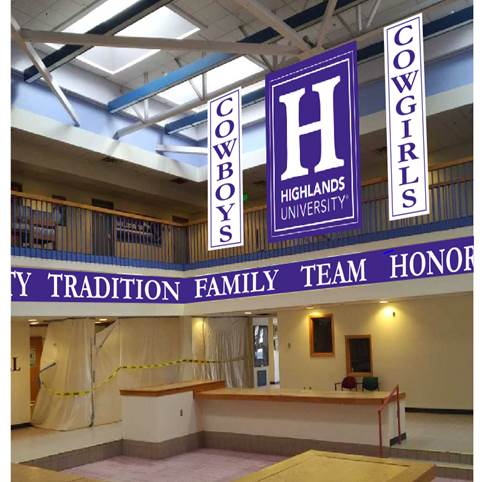
- Joan hosted the Monday Night Knitting Group this week. All students are progressing well. We shared a meal and a good time was had by all. Some of the students at work on their projects:
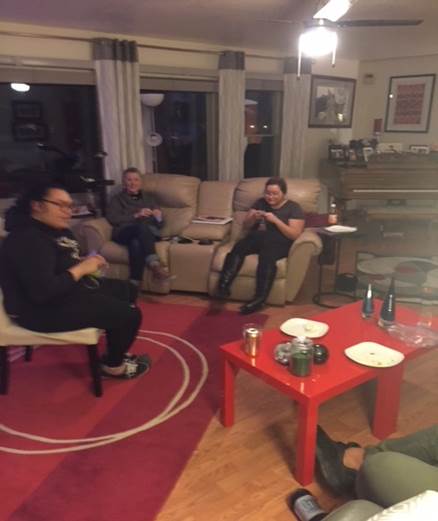
- On Tuesday we held the weekly Executive Management Team meeting. We welcomed Dr. Tom Ward to the meeting as the new leader of the Faculty Senate. We kicked off the meeting with a discussion of “Return On Investment” (ROI) in education and spent some time talking about what ROI meant to us and different students. There was widespread agreement that the “return” on a college education for one student was not always the same return for another. Different students thought about ROI in very different ways. For some, the “return” on a college investment was mostly or perhaps even totally about the job that would hopefully be waiting at the end of college. For others, the return was more about seeing the world in a different way than before college, figuring out how to navigate the world as an ethical being, learning about the great thought traditions of the world, gaining an appreciation of the aesthetic dimension of life, etc. I think we agreed that there was no right or wrong in all this….but I think we also agreed that thinking carefully about what ROI means or might mean to our students could help us tell our story, recruit more effectively, etc. Here’s two articles we read—one about the ROI in early childhood education and one about higher education: https://heckmanequation.org/assets/2017/01/F_Heckman_CBAOnePager_120516.pdf and http://blog.credit.com/2017/09/get-a-better-roi-on-your-education-in-these-7-states-178284/ . We finished the meeting talking about the most recent developments in Santa Fe, some possible commencement speakers, the IAC visit, and other housekeeping business.
- Later on Tuesday, we held the Fiscal Forum and I presented my budget priorities for the upcoming year. As a review, budget suggestions and recommendations were made at the discipline level and moved from there to the deans or other managers, and ultimately to the appropriate VP. We held numerous hearings where each VP made her or his case and answered questions form others. I then devised my list based upon what I heard from the VPs and my own judgments about what I believed to be in the best interests of the institution. In the last column, you can see how, in my mind at least, each budget item relates to our Strategic Goals. Reasonable people may disagree with my list, of course. After all, the total budget requests came up to more than $13mil so the chances of anyone’s priorities matching up exactly with mine are very unlikely. In the end, the goal is not for any two lists to be aligned. The goal is to have a clear, transparent, and well documented process for connecting budget items to priorities while making certain the process is clear and as transparent as possible. Copies of the budget priority list were disseminated at the meeting and I’ve attached the document to this message (above). More than 75 people attended in person or via Zoom. Thanks to all who attended.
- Congratulations to Jesus Rivas who was recently informed of winning a Fulbright award. The Fulbright will allow Dr. Rivas to continue his study of green anacondas; the largest known snakes in the world. He will be collaborating with scientists from Brazil and some of his students will accompany him. Well done to Dr. Rivas. A photo of Jesus and a not so little friend:
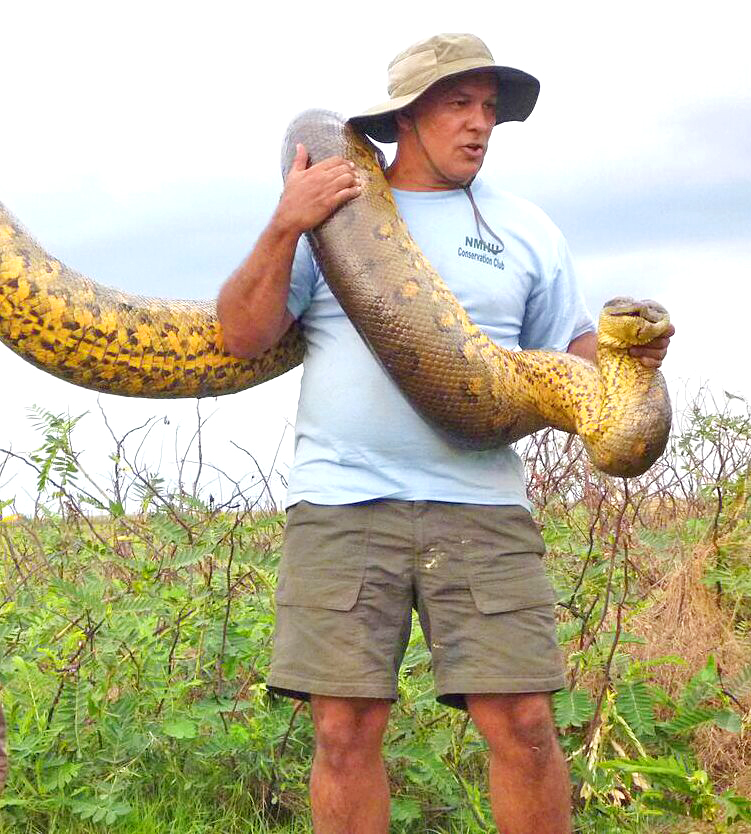
Courtesy photo
In the scholarly realm, I was also informed this week of a major accomplishment by Dr. Jessica Snow. Jessica’s paper, Actin Polymerization Contributes to Enhanced Pulmonary Vasoconstrictor Reactivity Following Chronic Hypoxia (whatever that means) has been accepted for publication in the American Journal of Physiology. That journal is one of the top publications in her field. Well done to Jesus and Jessica! We have some top-notch scholars here at HU and their work brings great distinction to them, to us, and to the disciplines they love.
- Our Advancement Team continues to perform at a high level. This week alone we brought in $2000 for two different endowment accounts, $3500 to our unrestricted fund, and $4000 for our football program. Well done to Terri Law and her dedicated team. Also, please consider donating an item to the HU Loves Alumni auction. That event will take place on February 10 in the SUB. See Juli if you’d like to donate something. Or, consider attending the event and bidding on some great items.
- The Josh Turner concert is this weekend. We’ve sold about $45,000 in tickets and will have 1500+ people in Wilson. I hope to see you there with dancing shoes (or boots) on and warmed up.
- Things continue to look generally favorable in Santa Fe. I remain optimistic that there will be at least some new money going to higher education, there will be something for compensation, and some other plusses for HU and the higher education sector generally. Max and I…mostly Max…have worked very hard to put HU’s interests before elected officials and we have many friends there. There has been much talk about Luna CC and the future of that institution. Our official position on that—Luna is critically important to Northern new Mexico. We’ll do everything we can to support that institution now and into the future. Whatever happens there, we stand ready to help Luna and all LCC students. We have taken no other position on anything related to Luna CC.
- A few weeks ago I did an Op Ed on three “bad ideas” to reform higher education. I recently wrote another piece and it might appear soon in a couple papers around the state. Be on the lookout for it. Once it is published, I’ll reprint it in a weekly message. It focuses on three more “bad Ideas”…from my perspective.
- HLC Update: The report to the Institutional Action Committee of the HLC was completed this week and mailed on time. Preparing this document was a significant undertaking involving many colleagues and lots of time and effort. The principal author of this document was Dr. Brandon Kempner who, once again, drafted much of the narrative, but also kept others on track. His high commitment to this and other HLC related work was and is remarkable. Virtually all colleagues I’ve known over the years assert that they are committed to students, the institution, their discipline, etc. But, when I’ve observed what they do—their deportment—I have not always agreed with those assertions. Others also assert that…or not…but their commitment is obvious. Just see how they behave. It reminds me of a Jean Paul Sartre quote, “Commitment is an act, not a word.” That is so true, no? Our presentation to the IAC is in early March. The team—me, Brandon, Max, and Roxanne—will prepare for the IAC presentation and invite feedback from the campus community. I am sure we will be ready to go.
One of my favorite things I read this week…from Inside Higher Ed:
“HR Director: What if we invest in professional development, and then our people leave?
CEO: What if we don’t, and they stay?”
The noble Piper says, “I could care less what’s going on down in Santa Fe. When’s lunch?”

Greetings colleagues. A brief update for the week of January 22-26:
- I returned to campus last weekend after nearly a full week at the NCAA meeting in Indianapolis. This meeting attracts thousands of participants. Hot topics included recent issues in basketball (almost exclusively in Division I), concerns related to wagering, and lots of discussions around various concussion lawsuits. I am very pleased to report that our conference…the RMAC…is doing well in all of the areas noted above and more. Our conference has a great record at handling issues as they come up (we were commended for being so responsive to all concerns), we are taking a proactive approach to wagering, and at this point, our conference is not part of any concussion lawsuit. That could change, of course. Some good NCAA news—student athlete success rates in Division II are higher than those in other NCAA Divisions and even higher than the general student population. This affirms that participation in college athletics, at least at the Division II level, is truly a “high impact practice” that predicts student success. Speaking of athletics, I was in Santa Fe all this week at the legislative session and there was so much talk about the recent New Mexico State Bowl Game victory. Like athletics or not, people who make important decisions about higher education’s future pay close attention to athletics. I should also note that I plan on throwing my hat into an election for a major NCAA governance committee assuming all continues to go well with our HLC issues. More on that later.
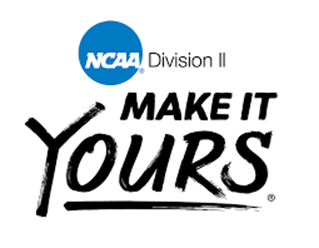
- I returned from Indianapolis and immediately went to Santa Fe for the legislative session. I spent most of the week there participating in various Council of University Presidents meetings, legislative hearings, one-on-one meetings with elected officials, meetings with Secretary Damron, and numerous social events with legislators, lobbyists, and others. This is a short session and things change very rapidly, but the overall situation looks much better than last year. A few details as of yesterday:
The Council of University Presidents (CUP) took a few positions and we did what we could to hammer them home this week. First, we support a 4% redistribution of funds using the current formula funding model in place in new Mexico, but we also support at least 2% new money for higher education. We support a 2% compensation increase for employees. Finally, we support a decoupling of lottery scholarship money. That is, students in each sector (the research schools, the comprehensives, etc.) would receive a flat amount of lottery scholarship support. It would not be tied to tuition at the school. We made these recommendations to the House and the Senate committees and in the case of the House, a higher education subcommittee, and I would say they were generally well received. There are competing recommendations about the percentage of money that should be redistributed (again, we are at 4%) and of course, we certainly received no guarantee that any new money would be added to higher ed funding overall. However, while I was in Santa Fe this week, the overall state revenue forecasts were improving by the day so that bodes well. In regard to compensation, I was asked several times about the modest compensation increase we had this year and if higher education was in such tough shape, why I did that. I believe only HU and one other university provided an across the board increase this year. I think I was able to explain my rationale and people seemed to at least understand it even if they did not agree with it. Although the CUP compensation recommendation is 2%, there are competing recommendations at 1% and 1.5%. Obviously, I hope it is 2%, but it is at least a little encouraging that people seem to be discussing what the increase should be—as compared to last year when it was all about how much will be cut. Decoupling the lottery scholarship money from tuition rates seems to have general support across the board.
Quite a bit of the discussion this week focused on the performance funding formula we now have in place in New Mexico. Compared to some other states, we really employ a kind of “performance funding lite” approach that only puts a relatively small percentage of university funds in play due to performance. One of the main drivers here in New Mexico is completion—that is, the number of certificates, two year degrees, undergraduate degrees, and graduate degrees—awarded by each school. In general, the more awards, the better the school does in the performance formula. But, as is always the case, the situation is really more complex than that. For example, deciding the base funding for each institution at the very beginning of the performance funding program can be tricky and it can have a continuing impact on performance funding over time. The bottom line, for me at least, is that performance funding can be a good thing—who is against paying more to people or institutions performing at a high level?—but the devil is in the details and if you don’t get those details right, you can cause harm to institutions and ultimately to students. Do we have those details right in new Mexico? That’s a good question. Of course, there are people on both sides of this issue and a good number in the middle. You can find plenty of evidence that is does and does not work—in some cases, some of the time. Those who take strong and resolute positions that it does or does not work are really not telling the whole story, in my view, or maybe they are simply unaware of the facts. Basically, the verdict is still out. Here’s what I think is a good summary:https://www.insidehighered.com/views/2016/10/06/evaluation-whether-performance-funding-higher-education-works-essay. But for now, we have performance funding in place in New Mexico. There may be changes in the future. Time will tell.
I also had numerous conversations about the possibility of making some changes in board of regent membership here in New Mexico. I recently had an op-ed in the local paper and in the New Mexican where I recommended adding members to boards including someone from the faculty and the staff. Here’s that piece and it generated quite a bit of discussion—pro and con—down in Santa Fe:
Yes, reform the university governance process
By Sam Minner
Jan 15, 2018
Proposed legislation to change how regents are selected for New Mexico’s universities will go a long way in strengthening our state’s institutions. Sen. Jeff Steinborn, D-Las Cruces, and Sen. Mark Moores, R-Albuquerque, have sponsored a constitutional amendment to create a bipartisan nomination committee to evaluate potential candidates for regent appointments. The committee would screen individuals interested in serving as regents and those names would eventually go to the governor who would make her recommendations. The Senate would then confirm or reject the governor’s choices as is done in the current system. These changes attempt to depoliticize regent selections and to make certain that regents possess the experience, knowledge and skills to fulfill their responsibilities. Other states have adopted such a system and, in many cases, the process has resulted in stronger board member selections and ultimately, stronger institutions of higher education. In the 2017 environment, simply having a personal or political relationship with someone does not make him or her a good choice to serve as a regent. That role is extremely complex these days and requires deep expertise in a variety of domains including, most notably, financial matters. I strongly endorse the proposal and hope that it makes it through the Legislature and gets on a ballot where the people of New Mexico can make the final decision. In addition to the proposed legislation, I believe it is time to take a broader look at university governance in our state. Here’s a few issues I think we should consider: First, at some schools, like New Mexico Highlands University, five individuals serve on the boards of regents. I am not one to make things more complex than necessary, but having only five regents makes it virtually impossible for any functional board committees to be established. In other states, boards are often larger, thus allowing for committees focusing on finance, academic affairs, student affairs and others to do a lot of the heavy lifting and make recommendations to the full board at regularly scheduled meetings. This approach can save a lot of time and not require small boards to have marathon meetings where they devote much time to every agenda item. This approach can make full board meetings less time-consuming and still provide a full vetting of all important issues. Second, I strongly recommend that boards include a faculty member and a staff member. The outcomes of any educational institution are largely predicted by the commitment, effectiveness and dedication of the people who work there. If those people are part of the decision-making process, outcomes tend to trend upward. Finally, particularly at our regional institutions like Highlands, it would be a very good idea for boards to include representation from the local community. Schools like Highlands are anchors for their communities, and the historical town-gown issues between municipalities and universities need to be addressed in new ways. Here in our town, as goes Highlands, so goes Las Vegas. And vice versa. Recently, a group of experts from around the state took a long look at the possibility of merging some boards governing our institutions of higher education. Not surprisingly, that notion did not get much support. Though state institutions of higher education “belong” to the state, many people interested in universities, especially regional schools, want some regional influence brought to bear on those schools. Highlands is fortunate to be governed by a strong group of regents who are true servant-leaders, but not every university president can honestly say the same. Let’s strengthen boards in New Mexico. Let’s make our institutions of higher education as strong as possible. Making changes in the selection of regents and board composition can do that.
Sam Minner is president of New Mexico Highlands University in Las Vegas, N.M
I should note that my recommendations, particularly the recommendation to add a faculty member to university boards, is not the unified or even the consensus position of CUP and some of the regents around the state. But, I do endorse that move. You either work to be more inclusive or not and you believe that a more inclusive board adds value or you don’t. I think it does. We’ll see where this lands. I should also note that one of the things I enjoy most about the CUP is that we discuss things thoroughly and if there is a unified position we can all get behind, we do so. However, it we are not on the same page and can’t get on the same page, we go our own way with no hard feelings—exactly how reasonable and educated women and men should behave. For that reason, among others, I enjoy the CUP very much and believe that it is a very important organization in the state. The CUP will be changing and soon. The CUP President, Chancellor Carruthers, will be retiring soon. In just a few weeks, there will also be a new president at UNM. Unbelievably to me, in a few short weeks I will be the second longest sitting president in New Mexico. And I’ve only been here 2 ½ years. This legislative session is probably the last I will share with Chancellor Carruthers and Secretary Barbara Damron. I have enjoyed working with them very much. I consider both of them to be people of very high integrity, selfless servant leaders, and models of task commitment to improve higher education in the state of New Mexico. I will miss working with them. A photo of the Chancellor passionately stating the CUP positions at a budget hearing: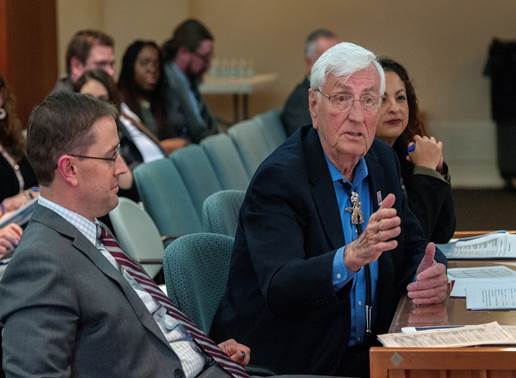
Several elected officials are apparently also familiar with my position on tenure in higher education. Over my entire career (as a faculty member and an administrator), I have strongly supported tenure and academic freedom. Many of my chancellor and president colleagues do not, particularly behind closed doors. I have written about my support of tenure in many publications and have given numerous talks about it as well. A summary of my recent Op Ed reprinted in an issue of EAB Daily Briefing:
Many colleges and universities are looking for innovative ways to meet business challenges and serve students better. Some proposals are more viable than others. In a recent article for the Albuquerque Journal, Sam Minner, president of New Mexico Highlands University, discusses three common, but flawed, suggestions.
Bad Idea No. 1: Kill tenure
Why it’s flawed: Minner points outs that this idea has been floating for some time, partly because employees in other fields have no equivalent of tenure. However, Minner argues that tenure is “incredibly important” for protecting academic freedom. “Tenured faculty members teach truth unfettered from shifting political winds,” he writes.
What the research says: According to Adrianna Kezar, co-director and lead investigator at the Pullias Center for Higher Education’s Delphi Project, studies have found correlations between fewer tenured professors and lower graduation rates, lower first-year retention, lower GPAs, and lower transfer rates from two- to four-year institutions.
Bad Idea No. 2: Put everything online
Why it’s bad: While online learning can be great for a motivated adult student, Minner argues that it may not be a good fit for a student fresh out of high school who has not yet had any upper-level courses, Minner writes. The latter might need extra support from people who can provide it on a college campus.
What the research says: Other experts agree that online learning might be best for students with good study skills or a high degree of motivation. For example, studies of community college students in California found that online courses had lower completion rates—but students who took part of their coursework online were more likely to earn a degree or transfer to four-year institutions. Online learning is more independent and autonomous. It requires a particular level of self-accountability and discipline, which is why retention is such a problem in online learning.
Bad Idea No. 3: Make all classes directly relate to jobs
Why it’s bad: Studying at a college or university is more than just about preparing oneself for a job, writes Minner. It’s about building timeless skills, such as communication and critical thinking, that apply to any field of study, he writes. Technology and the job market change so quickly that certain hard skills in high demand today, like programming, may not be as important in the near future. But, Minner argues, soft skills and the ability to learn quickly will always be important.
What the research says: A study of the outcomes for 1,000 college graduates who had studied at a liberal arts school found that, these students only make less than their STEM peers in STEM subjects for the first few years of their careers, but then they closed the gap (Minner, Albuquerque Journal).
I have to say, I don’t think I changed any of the minds of people who think that tenure is a bad idea, but at least I got my opinions out there. Everyone can count on me to continue to defend tenure as long as I am here. I should also note that Provost Gonzales, VPAA Ian Williamson, and I will make a presentation about tenure to the Regents at the next meeting. I think it is very important that the Regents also understand the significance of tenure in the academy.
- Tickets sales for the Josh Turner concert exceed 30k and we expect to sell even more. A number of businesses around town are planning pre or post-concert events. That’s good news…anything HU can do to spur economic growth is highly desirable. We are also starting to build some interest about our next performers, Black Violin.


Photo by Colin Brennan
- One of HU’s favorite sons was recently contacted by the American Association for the Advancement of Science (AAAS) to celebrate his 50th anniversary as a member of that esteemed organization. Dr. Joe McCaffrey is now a “lifetime member” of AAAS. Well done Joe!
- HU will once again be hosting the Amigos de las Americas group. They will be on our campus March 3-4. Many thanks to Kim Blea, Edward Martinez, Margaret Gonzales, and Eric Romero (and others) for making this happen. AMIGOS summer and gap year volunteer programs provide a rare opportunity to experience a new culture as a community member. This program changes the lives of the high school participants and it is a privilege to have them on our campus.
- I am very pleased to announce that Nick Leger has agreed to serve as our new Title IX Officer. Nick is a trained attorney. He will be teaching half-time this term and devoting half-time to various Title IX issues and concerns. Nick directly reports to me in this new capacity.
- So many HU faculty have recently achieved some significant professional accomplishment. Last week, I mentioned the piece Mike Petronis will soon have published. We’ll do a major story on that. Jesus Rivas recently returned from abroad after leading a successful and never-to-be forgotten jungle excursion. That kind of experience is truly the ultimate high impact educational practice. I continue to be so impressed…and sometimes even amazed…by the work of our faculty. Given the teaching loads here, we have numerous world class faculty who somehow and someway manage to do truly world class scholarly work. We are lucky to call them our colleagues.
- While I was away, Tom Ward was elected to the leadership position in our Faculty Senate. Tom has provided steady and high quality leadership to HU over the years and I look forward to working with him in this new capacity. In my 2 ½ years here, I have truly enjoyed my relationship with the Faculty Senate and the leadership there. Initially, I worked with Brandon Kempner and then later, Ian Williamson. I found both to be people of high integrity, super smart, and in my view, true servant leaders. It has been a pleasure to work with them and I am sure I will say the same about Tom. Also related to faculty senates, a fellow I worked with several years ago recently became a university president and we were talking about interacting with faculty senates. He said that thus far, he was “getting along” with the senate at his place and was pleased about it. I just had to put my mentoring hat on one more time and told him that I thought it was better to get along than not, but when it came to faculty senates, “getting along” was really not the goal. You try to maybe get along with your family (“Heh Uncle Jack, could we watch something other than LivePD?), or the people on your softball team (“You know Bill, that was my fly ball and you moving over from third base to right field was a little out of line. Plus, you missed it.”), or maybe your neighbors (“Hi Rose. Heh, could you maybe keep Duke out of my yard for his morning business?”, but the people representing the faculty? That’s not the goal, at least in my mind. The goal is to move the institution forward. To make things better. To improve outcomes. And that implies that there will be some whitewater some disagreements, and some tension from time to time. I told him, if everyone is getting along…that’s fine, if….things are getting better at the institution. If everyone is getting along, and nothing is happening…nothing is improving…well, you’re failing. Frankly, at this point in his career…he listened to what I had to say, but for now, I really think he’d prefer to just get along. So it goes.
- We had a Regent’s meeting scheduled for this Friday, but it was canceled due to some illnesses. We’ll reschedule it soon. Chairman Sanchez and I regret if this inconvenienced anyone.
- I previously mentioned that the Board of Regents recently recommended a two year extension of my presidential contract. I will accept that extension and sign the contract next week. I received numerous congratulatory notes from faculty members, staff members, and members of the community and I appreciated them very much. My initial contract was for five years and at present, I am halfway through that five year term. The two year extension of my contract means that my last day as HU president will be June 30, 2022—1616 days from today. The plan is to make certain that the 2021-20122 academic year is used as a transition to new presidential leadership, thus making certain a smooth and seamless transition. Once I’ve signed the contract, I will share the other details in it with everyone. Like all HU employees, I am an employee of the state and the details of my employment should be (and in truth, are) public. This extension will also make me ultimately responsible for the next HLC accreditation visit and that should be a plus as we explain the path forward to the HLC. I love working at HU, I consider it an honor to do so, and will continue to do my best to serve the institution as best I can.
- This Week in HLC Accreditation: Our latest HLC Forum was held on Monday January 22, to discuss the next steps in the HLC process and the site visit team’s report. The forum was recorded and is available for viewing on our Accreditation webpage, https://nmhu.zoom.us/recording/play/WTBStygCoGcfvYF5_2yL-G8UjW6esfUZ-z8mgRC1MuTNSwBRSSGsT2DiUF98h6TR. The Highlands’ Executive Management Team continues to prepare the Institutional Actions Committee (IAC) response, which is our formal response to the site visit team’s recommendation; this report is due on February 2, 2018, in anticipation of our March 5, 2018 trip to Chicago to speak with the IAC. The final decision regarding our probation status will be made by the HLC board in June. Please attend our Budget Forum on Tuesday January, 30th, 3-4 pm, in the SUB Ballroom.
My favorite quote of the week:
“An estimated half of all college students struggle with food insecurity…the new economics of college led us into this mess. The cost of higher education is at an all-time high, which is in sharp contrast to the declining income and wealth of most American families. And while a college degree is no guarantee of employment, it still greatly increases the odds of a middle-class life. It makes sense that students work hard to go to college to achieve stability, and it is tragic that many fail to complete degrees because they cannot escape poverty long enough to focus on their studies.” Sara Goldrick-Rab, ”It’s Hard to Study if You’re Hungry” in The New York Times, January 14, 2018.
The Noble Piper says, “Could you just bring me my food dish. I’m too comfortable to get up. “
Greetings colleagues. A brief update for the week of January 15-19:
- The weekend was busy with a variety of social and business functions. Notably, Joan and I joined the Provost, her husband, and the deans and their spouses/partners in Santa Fe for a New Year/New Semester kickoff celebration. It was a very nice event kindly hosted by Provost Gonzales. I have worked at many schools as a faculty member and in other capacities and the “culture” of each place varies as one would expect. People really work well together or they do not. They like each other or they do not. They get together away from work from time to time or they do not. There aren’t any rules to any of this, of course, but when people like and respect each other, face problems together as a team, and can laugh together….that’s really special and bodes well for the organization. In my view, it is absolutely not necessary that people behave that way to function well at work, but as I wrote, when it does occur…that’s really nice and can lead to great outcomes. I am very happy to say that the current group in Academic Affairs exemplifies this latter culture. A photo from the event…Roxanne directing the festivities:

- My latest Op Ed. It appeared in this weekend’s Optic and the New Mexican:
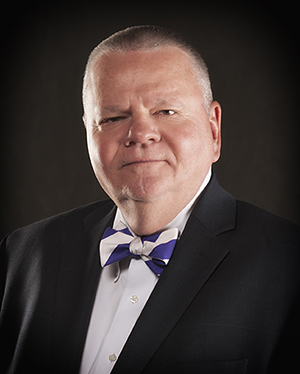
Let’s examine the university governance process
From the Highlands President
Sam Minner, Ph.D.
Proposed legislation to change how regents are selected for New Mexico’s universities will go a long way in strengthening our state’s institutions. Sen. Jeff Steinborn, D-Las Cruces, and Sen. Mark Moores, R-Albuquerque, have sponsored a constitutional amendment to create a bipartisan nomination committee to evaluate potential candidates for regent appointments. The committee would screen individuals interested in serving as regents and those names would eventually go to the governor who would make her recommendations. The Senate would then confirm or reject the governor’s choices as is done in the current system. These changes attempt to depoliticize regent selections and to make certain that regents possess the experience, knowledge, and skills to fulfill their responsibilities. Other states have adopted such a system and, in many cases, the process has resulted in stronger board member selections and ultimately, stronger institutions of higher education. In the 2017 environment, simply having a personal or political relationship with someone does not make him or her a good choice to serve as a regent. That role is extremely complex these days and requires deep expertise in a variety of domains including, most notably, financial matters. I strongly endorse the proposal and hope that it makes it through the legislature and gets on a ballot where the people of New Mexico can make the final decision. In addition to the proposed legislation, I believe it is time to take a broader look at university governance in our state. Here’s a few issues I think we should consider: First, at some schools, like New Mexico Highlands University, five individuals serve on the boards of regents. I am not one to make things more complex than necessary, but having only five regents makes it virtually impossible for any functional board committees to be established. In other states, boards are often larger, thus allowing for committees focusing on finance, academic affairs, student affairs, and others to do a lot of the heavy lifting and make recommendations to the full board at regularly scheduled meetings. This approach can save a lot of time and not require small boards to have marathon meetings where they devote much time to every single agenda item. This approach can make full board meetings less time consuming and still provide a full vetting of all important issues. Second, I strongly recommend that boards include a faculty member and a staff member. The outcomes of any educational institution are largely predicted by the commitment, effectiveness, and dedication of the people who work there. If those people are part of the decision-making process, outcomes tend to trend upward. Finally, particularly at our regional institutions like Highlands, it would be a very good idea for boards to include representation from the local community. Schools like Highlands are anchors for the communities where they are located and the historical town-gown issues between universities and municipalities need to be addressed in new ways. Here in our town, as goes Highlands, so goes Las Vegas. And vice versa. Recently, a group of experts from around the state took a long look at the possibility of merging some boards governing our institutions of higher education. Not surprisingly, that notion did not get much support. Though state institutions of higher education “belong” to the state, many people interested in universities, especially regional schools, want some regional influence brought to bear on those schools. Many issues would need to be worked out to implement my suggestions. Should new members from the faculty, staff, and community hold a vote on boards or simply serve in some ex officio and non-voting capacity? If members are added, would they be willing to complete the initial and ongoing professional development to effectively serve as regents? I have my opinions about all that, but let’s have the debate. Highlands is fortunate to be governed by a strong group of regents who are true servant-leaders, but not every university president can honestly say the same. Let’s strengthen boards in New Mexico. Let’s make our institutions of higher education as strong as possible. Making changes in the selection of regents and board composition can do that.
Dr. Sam Minner has been the president of Highlands University since June 2015. He can be reached at 505-454-3269.
- I am very pleased to announce that our Business program has been reaffirmed for accreditation by the Accreditation Council for Business Schools and Program (ACBSP). Our program remains fully accredited. Our ten-year reaffirmation of accreditation is good until 2027. Congratulations to s. Mary Romero, Dean Bill Taylor, and everyone who helped make this happen.
- Over the weekend I learned d about a new publication co-authored by Mike Petronis. It is an extremely impressive piece of work. I’d say it is an important piece. Well done to Mike and his collaborators. I read a “pre-publication” copy and as soon as I get the green light, I’ll pass it on in one of my weekly messages
- Monday evening was a rough one. One of our officers was injured, two of our students were also injured, and one of our students tragically lost his life. I will work with Dean Blea to provide counselors for anyone in need of that service.
- Most of this week was devoted to the NCAA meeting in Indianapolis. There are several important issues before the group and I’ll report on them when I get back. This week also marked the kickoff of the new legislative session. I assure the campus that HU is well represented at the Roundhouse and the CUP is closely tracking all bills in any way related to higher education.
- HLC Update: FROM BRANDON
This Week in HLC Accreditation: We have another HLC forum on Monday January 22, 3-4 PM, in the SUB Ballroom. We will be discussing the next steps in the HLC process, which is our written response to peer team’s visit we held Last November. This response goes to the Institutional Actions Committee (IAC), which hears Highlands case’ on March 5th-6th. We’ll send a team of four (President Minner, Provost/VPAA Gonzales, VPFA Baca, and Dr. Kempner) to Chicago to discuss the recommendations from the site team. The IAC then provides a recommendation to the HLC Board, which makes the final decision regarding our probation in June 2018. At our Monday HLC forum, we’ll discuss the peer team’s recommendation and look at a rough draft of our IAC response.
Favorite quote from the week—this one about career advice:
Question: What career and life advice do you give to new college grads? “Learn something every day. You don’t know everything. There’s a lot that kids know that we didn’t know when we were their age. But they have to be able to want to learn, too. I just would like them to slow down a minute and listen. Stop talking. I’m not kidding. It’s something that I think about all the time. People who talk aren’t learning anything.”
Greetings colleagues. A brief update for the week of January 8-12:
- The Drone Rodeo was held last Saturday at the Abe Montoya Recreation Center. About fifty kids participated and we also attracted a nice crowd of parents, family members, and spectators to cheer on the competitors. Provost Gonzales and Sandy stayed for the entire event and I thank them both for representing Highlands there. I should note that this event was absolutely free to local kids thanks to a generous gift from LANL. Mariano Ulibarri did a great job bringing this together. Many HU volunteers also helped including some staff, students, and student athletes. Well done to all who made this a success. I should also note that a significant number of girls participated in this event and I should also note…they did very very well. We must do all we can to build the STEM pipeline and anything we can do to particularly encourage more girls and women simply must be done. This event is but one example. A photo from the event:
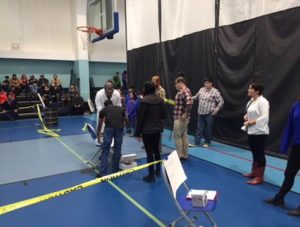
- In an additional effort to welcome members of the community to HU events, we charged no fee at the door for last weekend’s basketball games. Our women’s team valiantly challenged their opponent and demonstrated great effort , but came up a bit short. The men’s squad won two. We attracted nice crowds to the games:
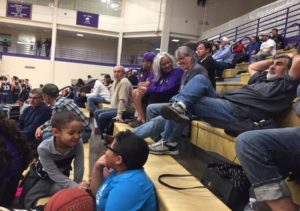
Speaking of the men’s team, the Cowboys are on a five win streak and playing some really exciting basketball. We’ve got a nice mix of local players, players from the region, a few from abroad, freshmen, seniors, and others. A number of our players this year have some HU connection—a parent or family member played here, etc. Come on out and support the team. They’re fun to watch.
- We held our typical Executive Team Meeting on Tuesday and began the meeting with a brief discussion of this piece from The Corner Office (appears each Sunday in the NYT): https://www.nytimes.com/2017/10/27/business/how-to-be-a-ceo.html?rref=collection%2Fcolumn%2Fcorner-office&action=click&contentCollection=business®ion=stream&module=stream_unit&version=latest&contentPlacement=1&pgtype=collection.
We focused on two excerpts from that article:
“By definition if there’s leadership, it means there are followers, and you’re only as good as the followers,” he said. “I believe the quality of the followers is in direct correlation to the respect you hold them in. It’s not how much they respect you that is most important. It’s actually how much you respect them. It’s everything.”
“Just last month, for instance, Daniel Schwartz, the chief executive of the parent company of Burger King, told me that he likes to ask candidates, “Are you smart or do you work hard?” (Yes, there is a right answer, he said: “You want hard workers. You’d be surprised how many people tell me, ‘I don’t need to work hard, I’m smart.’ Really? Humility is important.”)
People around the table talked about bosses/supervisors they knew and or had worked for in the past and how little or how much they respected them and how much or little respect they had for others in their work environments…and why. One individual asserted that he looked for consistency in leadership. If the person behaved in some reasonable and consistent manner, he generally respected the leader. If the leader did not, no R-E-S-P-E-C-T from him or probably from Ms. Franklin either. Several people commented on transparency as a key variable in garnering respect. If a leader tried to be as transparent as possible, they respected her or him…usually even if they did not agree with the ultimate decision. I chimed in and asserted that if I believed someone…my boss or whomever…decided something or did something she or he felt and really believed was the best thing overall…the best thing for the most people…the best thing for the organization as whole…then I respected them in most cases. Even if I disagreed with the decision or action. On the other hand, if someone decided something or did something that I believed—one can never be sure…it is a judgment—was self-promoting or showboating or somehow feeding their ego or purely designed to benefit them in some way (e.g., money, power, etc.)—then I tended to not have much respect for the person. Now, sometimes a decision can be good for the organization and also be good for the individual. I’ve seen many examples of that and that’s the ideal situation I guess. But, I’ve seen my share of show ponies, people (so-called leaders) who are blatantly self-promotional and for me, I just don’t respect them very much or at all. That’s just me. We didn’t talk much about the second quote (the one about being smart or working hard), but I don’t mind revealing that I’ve changed some around all that. Socialized as faculty member, I began my career thinking that disciplinary expertise, the strength of the CV, academic pedigree, etc. was pretty much everything and I relied on that for most hiring decisions—faculty jobs, administrative jobs, etc. I still think that’s pretty important when it comes to faculty work. But, I have made some errors over my career going with someone with a super strong CV who was a total loss as a colleague or member of the faculty. A few of them were memorable. Some were really lazy. I have a vivid memory of hiring a guy with an incredible CV (Ivy League doc, the best post docs, super well known in his discipline, etc.) who just wouldn’t work. He actually said at a faculty meeting that he refused to get “involved in the doing”; he wanted to limit his work to “the thinking” and believe me, that’s what (and all) he did all right. I should also note that his comment became the stuff of legend at the institution (“Good idea Rene…but of course, I won’t get involved in the doing”). Some had incredible depth of knowledge, but were terrible teachers and didn’t really want to teach at all which, in most cases, was what I primarily hired them to do. A few were really really bad colleagues and I avoided them as much as I could. A few were super negative people—given their background, they felt they were doing everyone a big “favor” by working there. That won them a lot of friends and supporters. But still…even after all that…I tend to be attracted to faculty applicants with strong pedigrees and strong CVs. I don’t deny it. However, when it comes to administrative hires, I am in a little different place than I was. Previously, I generalized my bias for academic pedigree and so on in the faculty realm to administrative jobs…and often, that did not work out all that well. I recall one dean I hired who was extremely well qualified as a faculty member and quite well known is his discipline, but was just a terrible dean. I could never really tell if he could not do his job or didn’t want to do it, but, he as a loss. Being strong in one domain (the faculty domain) does not necessarily mean someone will be strong in another (the administrative realm) or the other way around. But again, sometimes a person is strong in both areas. These days, when it comes to administrators, managers, and the like, I go for “working hard” over pretty much everything else—assuming the person is smart and has a legitimate educational background and has proven all that by virtue of graduating from a reputable institution. Of course, ideally….you try to get someone who is strong in both realms.
The remainder of the meeting focused on next HLC steps, a discussion of disenrollment, an update from HR on changes there, and a brief update on the upcoming legislative session. We are carefully tracking possible legislation during this short session including possible bills related to compensation, overall funding levels for higher ed, and other areas. We welcomed Dr. Ian Williamson to the meeting as the new AVPAA. I know he will do a great job in this role and everyone appreciates his willingness to serve HU in this new way.
- A few weeks ago, we finished the high school senior search campaign in collaboration with our partner, RNL. Messages were sent to 15,207 students in areas where we’ve historically drawn a significant number of students. Prospective students were sent a variety of messages—five emails, phone calls, and some direct (hard copy) mail. Between 5-6% of the prospective students we contacted clicked on a button and or spent some time on the site. That’s about 760 students or so, which according to our consultants, is about typical. We are now in the middle of our sophomore/junior student campaign. I should note that up to this year, we’ve basically done little or nothing to reach down to the junior or sophomore levels. At this point, about 27,000 sophomores and juniors have been contacted on this effort. I’ll provide more information as the data becomes available.
- The lineup for the Spring 2018 HU: Learning Happens Here has been announced. These are noon lunch talks available on a first come-first served basis to HU staff members. We launched this initiative last year and it continues to be very popular. Here’s the 2018 lineup (specific dates to be announced):
Chasing Nellie Snider: A Protestant Missionary Teacher in Territorial Las Vegas – Peter Linder, Ph.D.
Can we have Ethics in Business? Or are we just chasing our tail? – Keith Tucker, Economics and Finance Professor
Playing Video Games for Homework is Still Homework – Benjamin J. Villarreal
Medicinal Herbs of Northern New Mexico – Linda LaGrange, Ph.D.
Teaching and Learning at Rio Mora National Wildlife Refuge – Joseph P. Zebrowski, M.Sc.
Many thanks to the faculty who devote their time to this project…and many thanks to all who participate.
- Our HR Department recently completed a survey of student satisfaction regarding our performance in various offices. We’ll use this as a baseline to try to be more responsive to student concerns. The return rate was not great (N=68), but still…we have some baseline data now. As you can see (below) most respondents felt we were doing a good job (Question #1) and most people felt pretty good about the alignment with our core values (Question #2). Thanks to Dr. Montoya and the HR team for doing this.
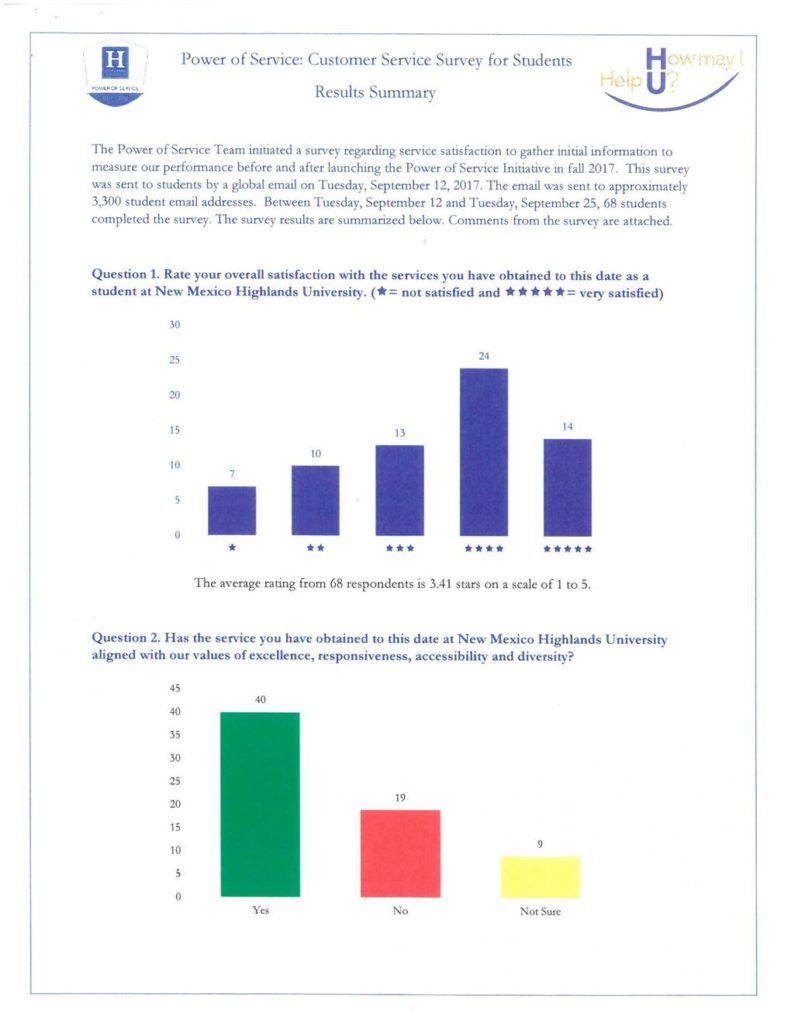
- On Thursday I met with the group planning activities for our 125th anniversary. Some really great ideas are on the table and this group will sort through them and make some final choices. If you have any thoughts about what we should include in the celebration, please let Juli know (jesalman@nmhu.edu).
- The next several weeks will require me to be off campus most of the time. Next week (January 15-19), I’ll attend the national NCAA meeting in Evansville. After that (January 22-26), I’ll be in Santa Fe for most of the week for the legislative session. Provost Gonzales will assume responsibility for the campus in my absence.
- Tickets are selling well for the upcoming Josh Turner concert. At this point, ticket sales have brought in about $16K and we anticipate many more tickets will be sold as we get closer to the concert date. Posters advertising the concert are going up this week. Free student tickets will be distributed beginning this Friday at 10:00 a.m. Faculty and staff can purchase tickets from Donna Martinez. A classic Merle Haggard tune interpreted by Mr. Turner—Silver Wings (https://www.youtube.com/watch?v=uY85-bZbWAg&index=13&list=PLCB0D0FBDC838BE9A). The opening act for Mr. Turner will be emerging country artist, Frank Ray. Mr. Ray is a former police officer in Las Cruces. Rolling Stone listed Ray as one of its 10 New Country Artists You Need to Know in December, noting “Ray sings about the Hispanic immigrant experience in America, highlighting the cultural differences, but pointing out values – including family and hard work – shared with the country audience.” Here’s one of his songs:https://www.youtube.com/watch?v=7NhMY91IjV4&list=PLP3JF0SJqEeRbyvVQl9EvQseDcRjzjpcg. We are also starting the advertising for our next performers—Black Violin. They will perform on our campus on March 2 at 7:00 p.m. A video featuring those performers and their back story: https://www.youtube.com/user/BlackViolinTV.
- After all the disenrollments and other enrollment changes over the last several weeks, it looks like our 2018 enrollment will be at 2,730. This is exactly the same number we enrolled last spring (2017). I have heard a few colleagues suggest that “holding our own” given the decrease in regional population, minimal or no population growth statewide, accreditation challenges, funding decreases, etc. is “good” or a least acceptable. It is not good or acceptable from my perspective. I know lots of people are trying, but we simply must attract more students to HU. We have a good story to tell, a strong faculty, we are extremely affordable, and we have the capacity to handle more students. Drilling down on our numbers a bit, it seems clear to me what is going on. We continue to increase graduate enrollment—up in Albuquerque, up in Farmington, up on the home campus, up in Roswell, and up in Santa Fe. Undergraduate enrollment is down in Farmington, on the home campus, and in Santa Fe. Online students are significantly up. The biggest problem is attracting undergraduate students to the home campus here in Las Vegas. We are simply not doing that. We will have additional discussions about all this during the spring term, but the time for mere discussion is up. If we really want to maintain a healthy undergraduate population here in Las Vegas and improve enrollment overall, we must make some changes. We are now using modern tools and processes to recruit students. We remain one of the most affordable le options in the region. We are now providing our students with a variety of healthy and interesting recreational offerings. I think we have strong supports for students needing assistance of various types. We have made real progress in the area of customer service. What we have not done, up to now, is to make any meaningful changes in our program portfolio—our offerings. Are we offering programs that students are interested in?
- We are making excellent progress with the renovation of Stu Clark. We are able to do this renovation thanks to a generous donation and the assistance of the H Club. At this point:
- Smart TVs are on order. They should arrive shortly. We’ll use this equipment to digitize the various photos, news clippings, and other artifacts accumulated over the years and bring greater structure and organization to the collection,
- new trophy cases are on order, and should arrive within two weeks,
- a restroom expansion is half way finished, and should be completed by January 22,
- some new floor tile is on order and should arrive in three weeks,
- final painting is scheduled to be done by the end of January,
- we are purchasing some new banners, which shouldn’t take long to get in.
- LED bulbs for both the atrium and lobby will be ordered this week. They should arrive in two weeks and will be installed then,
- we are creating a video loop and narratives for the photos of our honored athletes. Those will be played on the Smart TVs. This should be major improvement over years past. When that is completed, people will be able to see images of our honored athletes and hear something about their exploits. And finally,
- we’ll be ordering and installing a new purple carpet with a gray H for the sunken area of the atrium.
Hopefully, we’ll get all of this done by mid-February. Many thanks to Sylvia Baca, Craig Snow, and everyone who helped make this happen .
- Our Advancement Team continues to perform well. Counting up the end of year campaign plus the holiday art auction plus other assorted December gifts, we brought in about $100K. Well done to all who helped make this happen. With the approval of donors and the Foundation Board, we continue to sell some art—mostly duplicate pieces. A close up of an incredible mural we hope to sell at auction:

- HLC Update: The leadership team met on Tuesday and the various roles and responsibilities associated with our response to the IAC were clarified. We’ll start our written response with a three-page letter from me outlining our ongoing commitment to exceeding all HLC standards and particularly addressing their concerns about the institution’s historical tendency to not behave in a consistent manner in regard to accreditation matters (the so called history of “starting and stopping” as noted in their various communications to us). As was the case in our Assurance Argument, we’ll complete the IAC response in plenty of time for a complete review, close editing, and final polishing. Our team (me, Brandon, Roxanne, and Max) will appear before the IAC on March 5th or 6th—specific time and date to be determined. At this point, we are in good shape and I thank everyone who continues to devote time and energy to this effort.
The Noble Piper says…I am not leaving this spot until it warms up around here….
Greetings colleagues. A brief update for the week of January 1-5, 2018:
- Many thanks to Mariano Ulibarri for organizing the “drone rodeo” events this week. These events are supported by a generous contribution from LANL and are totally free to local students. Here’s the most recent update on the various events from Mariano:
The Drone Rodeo is in full swing. We have a crew of nearly 20 students, faculty, and community members working and /or volunteering to make the event a success. This was a very ambitious endeavor. With less than one month to prep, and the university being closed for most of that, we have faced many challenges in preparing for the event. Thankfully, our dedicated crew has moved forward, and it’s looking like we will have a memorable event. On Thursday we began after school workshops to prepare our young people to compete in the Rodeo. Workshops continued tomorrow after school on Friday and in the morning on Saturday. Attached is some of the wonderful artwork created for the event by NMHU Media Arts alum Mario Griego.
- Someone sent me a recent article from the Oregon County Register about John Fassel, new head coach of the Los Angeles Rams and former head coach of the NMHU Cowboys. I was struck by the parallels between John’s experience here (and in life) and the experience of so many of our dedicated faculty and staff. Students too for that matter. Here’s an excerpt from the newspaper article (I added the yellow highlighting):
Thirteen years before he was handed the reins of an NFL franchise in the final weeks of a failed season, John Fassel was given his first and only other chance as a head coach. It was decidedly less glamorous. New Mexico Highlands University sits in the dusty foothills of the Rockies, in the small, ironically named town of Las Vegas, New Mexico. The campus is “basically out in the boondocks,” Fassel recalls, the polar opposite of its glitzy Nevada counterpart. But when Fassel was hired as head coach in 2003, he didn’t mind. He was wide-eyed, 30-year-old, just beginning his ascent up the coaching ladder. Right away, the climb proved steep. The football team had lost 24 straight games, the nation’s longest losing streak. With no other choice, the Cowboys practiced in the outfield of the campus softball diamond. Coaches drove the team buses to road games and slept four to a room at whatever Motel 6 was closest. Fassel arranged travel and team meals and even did the laundry. Every week, they cleaned the entire team’s uniforms in a single washer and dryer, filing large trash cans with detergent to let the stained pants soak overnight. Sleep was a luxury. When his football responsibilities were fulfilled, Fassel taught three classes, including two master’s level kinesiology courses. For nine months, when duty called, he served as interim athletic director. That same year, he was named grand marshal of the town’s Electric Light parade. Perhaps that sounds like too much for one man to handle. But for John Fassel, the boundlessly energetic and beloved special teams coordinator of the playoff-bound Rams, “it was the best thing that could’ve happened to me.” “I was required to do a lot that I wasn’t honestly prepared for,” Fassel says. “But I had to find a way to get it done. People were counting on me. I didn’t know how to wash stains out of game pants. But I had to figure it out anyway. ”Truth is John Fassel has always found comfort in the chaos. His rise from Las Vegas, New Mexico to Los Angeles, California has been a product of this endless state of flux. It’s a constant, ever-present part of him, from his training for more than 40 triathlons to his reputation for pulling pranks on his own players. Fassel is always in motion. It’s why a one-time quarterback and receiver gravitated to coaching special teams, where nothing is constant but chaos itself. When Jeff Fisher was fired last December and Fassel was named interim coach, his steadying hand kept the Rams afloat. The team lost its last three, but it hardly mattered. A month later, Sean McVay was hired, and while putting together his new staff, he was struck by what he heard of Fassel from those three weeks. Even as the Rams fell apart, he held the locker room together. “You really find out about people when they go through adversity,” McVay says. “Watching the way he consistently led, consistently brought it every single day in spite of things not going the way that you’d liked, watching the way that the guys responded to him. … He was a really special coach.”
I got to thinking how similar John’s NMHU experience was and is to what happens here in the academic realm (and others). Do we have the resources to simply devote more money to some problem and solve it that way? No. Not at HU. Do people here have to, in many cases, somehow “figure out” how to get things done on their own? Yes, in many cases they do. I don’t deny it. Do people, in some cases, have to step up and do things that need to be done, but are not technically part of the job they were hired to do? I see that quite often. In truth, NMHU is a place where people have to be really creative, really tough, and really committed to get things done in order to make positive things happen. That’s hard to do, but…somehow we do it all the time. And just like John’s experience, lots of students, faculty, and staff start here…even with all of the challenges and lack of resources and obstacles…and fly high and far to some pretty incredible achievements. Achievements like serving as a head football coach in the NFL. Or becoming a top scientist. Or a successful businesswoman. Or a great teacher, nurse, or social worker. I could go on and on. Some of you reading this message started out at NMHU and faced some pretty daunting personal challenges early in life. And yet, some of you…many of you, really…have had and continue to have incredibly successful careers and lives. So…I like John’s NMHU story. NMHU—start here—go anywhere. The NMHU experience can truly be the best thing to ever happen to someone. People…mostly our students…count on us to get things done and help them. And, we do. A photo of Mr. Fassel in one of the many marathons he runs:
- I and the other New Mexico presidents were invited to respond to a recent HED report summarizing the performance of our system of higher education (to the degree it is a system at all) and how individual schools, including HU, were doing. The report was well done, I think, and accurate, but I did provide some feedback about the measures used in the report to assess performance. They say you “treasure what you measure” and I think that’s correct, but it is also possible to select measures consciously or otherwise that distinctly disadvantage some individuals, groups, and organizations and occlude the very hard, but very good work some people do to make the world a better place. An excerpt from my response:
Thanks for allowing me and the other university presidents the opportunity to provide some feedback on this report. As is usually the case when HED prepares some document or report of this type, this one is very well done and I think accurate. So, well done. The issue I have—a concern really—is that at some point I think the metrics should perhaps be examined for some possible additions. The typical metrics—retention rates, awards per year, graduation rates, etc.—are just as relevant today as they were decades ago. Everyone I know wants to get students into college, out in four years (or less, if possible), with the lowest possible debt and on to the next thing…graduate school or a good job. I am in no way suggesting that those measures are not important. But, today in the 2017 New Mexico environment, other things should perhaps be considered. The truth is that those traditional metrics (retention, etc.) have pretty much always been pretty good for certain types of New Mexico students and indeed, good for similar students across the nation. I am referring mostly to students from middle class or wealthy families who are also mostly White. I and frankly all university presidents know how to improve retention and graduation rates and quickly too—admit only good students and by good, I mean students with good ACT or SAT scores who by the way, are also disproportionately from middle class or wealthy families and also undoubtedly had better access than poor students to top teachers, modern curricula, and advanced classes such as AP. In other words, “good” in this case means students who are already good—not necessarily students who if given a chance could become successful. As you may know, the very top universities in our nation (e.g., Yale, Princeton) enroll more students from the top 1% of the income distribution than students from families in the entire bottom 60%. New Mexico does not have any top Ivy Leagues schools, but the idea still applies—who gets in, who graduates on time, and who goes on top the best graduate schools and jobs? Mostly students from wealth and high opportunity. As you well know, I am sure, the situation in New Mexico is rather bleak. We are one of the poorest states in the nation with, despite the heroic efforts of so many teachers who try so hard against all odds, one of the weakest K-12 systems in the nation. Our health outcomes are bad. Our overall child welfare outcomes are bad. I could go on. Given all that, we still want to get students into college and out (those typical metrics again), but….should we also think about some other measures that might be particularly important given our situation? Here’s a possibility—should we try to count or somehow assess how well universities do at lifting people out of poverty? Surely that matters. And I think most people would say that getting that job done is a lot harder than graduating a student from wealth—a good high school—a familial history of going to college—etc., etc. But here’s the thing—if a school that is open admission and works hard to lift people out of poverty has a lower retention rate that others, that school looks like it is underperforming. That doesn’t seem fair to me and not only unfair, it can be discouraging to the people who try so hard to get those students through. Let’s turn to another measure—four or six year graduation rates. If someone had to guess which student will graduate in four or six years—a student from a nice middle class family or a first generation student who grew up in a culture of generational poverty who is working—maybe two jobs—and powerfully feels the pull of family while she or he is away at university (e.g., we need you here at home to help with something)—how would that guess go? Of course, the former student is more likely to graduate in four or six or really, ever graduate at all. Surely there must be some way to capture the efforts of schools enrolling the latter type of student in some way that will not punish the school and or discourage the people who work there. The bottom line, for me at least, is that America has always done a good job educating certain students, but a pretty poor job educating others. In New Mexico, we have a state full of those “others” and to not recognize that is not a good thing. The situation in New Mexico will probably never improve all that much until we find a way to support all of our students. I would say the same is true for the nation as a whole. My point is simply this—-the “old” metrics like retention rates, graduation rates, etc. still matter, but the 2017 world—particularly the New Mexico 2017 world—is changing rapidly. Given that, we need to think about our metrics very carefully and maybe…we need to add some. If a first generation New Mexico student enrolls in a university and completes a year or two of school—maybe even a few hours—but never graduates, is that a “failure” and should the school be considered an underperformer? Frankly, I don’t think so.
My two cents on this cold New Year’s Day. Again, thanks for doing a great job on the report and thanks again for allowing me to respond.
All the best,
Sam Minner, Ph.D.
President, NMHU
I was struck by a similar piece in a recent Inside Higher Education. This one from Matt Reed titled “Weapons of Math Destruction” and also focusing on how the measures people select to assess how “good” something is can shape policy, public perceptions, funding, and much more. For example, strongly focus on graduation rates and some institutions of higher education look pretty good and others not so good. Now, no one I know thinks it is desirable to have a low graduation rate, but…I think that focusing (too much) on that variable to the exclusion of others essentially guarantees that some students (middle class and wealthy) and some institutions (those serving them) will come out looking pretty good. In a sense, selecting that measure is an example of hegemony—making a decision about, in this case, what is measured, that is bound to continue to advantage people and organizations that are well resourced, thus promoting social reproduction (e.g., the rich get richer). How would things work if, for example, we identified and employed a statistic or measure that comes “closest to reflecting the point of higher education” (see below in red)? To be sure, we’d have to be clear on what that point is and I think it would be up to us to do that. Enrolling and then graduating on time? Getting a good job? Becoming a good citizen? Shaping a life of meaning and purpose? Helping one figure out how she or he fits into the world? Helping to become an ethical person? Cultivating an appreciation for the aesthetic dimensions of life? Something else? All that and more? I also like what Reed says about a “clear winner” (see below). In a baseball game , there is a clear winner. That’s why we keep score. Who “wins” and “loses” in higher ed? Is a wealthy kid with great access to dual credit classes, access to the best K-12 schools and teachers, the resources to take the ACT 1, 2, 3…or more times (after expensive preparation), enough money to not have to work while at university, the resources to purchase the best technology, a reliable car to get from A to B (heck, let’s make it a BMW), etc. etc. a winner? Is a poor student who takes ten years to graduate because she or he is working 30 hours a week a loser? At any rate, I was struck by the similarities of my response and the piece in Inside Higher Ed. Here’s some from that article—again the highlighting in yellow is mine:
Part of the joy of the winter break is that it’s a chance to read something longer than twenty pages. I spent part of it reading Cathy O’Neil’s “Weapons of Math Destruction,” which is well worth reading if you haven’t already.
O’Neil was a quantitative analyst in the banking world for a while, until she grew disenchanted at the social uses to which her expertise was being put. She saw sophisticated math being used to make the rich richer at the expense of everyone else. This book is a form of penance, showing the rest of us cases in which Big Data gets used as a form of power. Readers of a certain age will hear echoes of Foucault in there, but don’t worry. O’Neil’s writing style is far more lucid.) The book is a series of chapter-length examples, but if you stick with it, you start to pick up the pattern. O’Neil distinguishes directly-valid data from proxy data, warning us against the latter.
Baseball offers easy examples of directly-valid data. A runner reaches base, or does not. A given swing results in a home run, or it does not. Somebody wins each game. That sort of data can lead to valuable insights, because it’s about what it says it’s about. Sabermetrics, the sort of statistical analysis pioneered by Bill James and immortalized in Michael Lewis’ Moneyball, tends to work because it’s (mostly) based on solid data. It’s far from perfect, but it can help. For example, if a team knows that a particular hitter on another team always hits the ball to the right side of the field, it can shift its fielders to the right when he’s up. Baseball also offers an example of self-correcting experiments. If a given team misreads the numbers, or takes a flyer on something wacky and fails badly, the numbers adjust accordingly. For instance, Moneyball could be read two ways. A literal reading would tell you that on-base percentage is the key stat for batters. A fuller reading would tell you that at any given moment, some traits are overvalued in the market and some undervalued, and the first one to find an undervalued one is in a position to win. OBP was simply an example. When OBP became the new orthodoxy, it lost much of its competitive usefulness. Proxy data is where things get squishy. Proxy data, as she uses the term, refers to data that correlates with the desired trait, but isn’t the trait itself. She gives the example of insurance companies basing rates on the zip codes where different customers live, on the theory that birds of a feather flock together. And it’s true that you can find geographic patterns in the data. But the patterns don’t tell you about any particular person’s risk, and they’re often reflections of other factors — race and income, notably — that have the effect of placing extra burdens on the people with the fewest resources. If living in a low-income neighborhood raises your insurance rates, well, who tends to live in low-income neighborhoods? O’Neil points out the irony that relatively strict regulation of the factors that can go into calculating credit scores has had the effect of encouraging the wanton generation of unregulated, rogue scores that are often far more pernicious.What the market wants, the market finds a way to get. At times, she falls into the trap of calling for transparency as a solution. I get the temptation, but it falls short of a solution in a couple of ways (both of which she actually identifies, in passing). The first is familiar to any customer of a credit card: if you bury something in twenty pages of two-point font legalese, you may have “disclosed” it for compliance purposes, but it’s effectively still hidden for all practical purposes. That has the effect of neutering much regulation. The second is familiar to folks who’ve navigated the admissions game to competitive universities. If you disclose the proxies, people can beef up the proxy scores at the expense of what the proxy is supposed to represent. This is the kid who joins six clubs and two teams without really getting beneath the surface of any of them. Alternately, in the context of performance-based funding for colleges, this is the college that tweaks its policies so that any students who place into remedial classes don’t count in their graduation rate. Ultimately, there’s no neutral technical fix, because it’s basically a political problem. If Big Data is about power, and the incentives are there to abuse it, then we can expect the powerful to abuse it for their own gain. It would be surprising if they didn’t. And appeals to conscience only work among people who have consciences. We’ve seen that some very powerful people don’t. Higher education certainly isn’t immune to what she calls WMD’s. Performance-based funding is an easy example: the states that have adopted it haven’t seen meaningful gains. Instead, they’ve seen a fair amount of system-gaming as institutions do what they have to do to survive. The ideal solution would be to find the stat that comes closest to reflecting the point of higher education, in much the same way that on-base percentage did in baseball. But to do that, we’d have to define the point of higher education. A baseball game has a clear winner, but a higher education system may not. That’s where politics come roaring back.
- In an effort to promote the leadership knowledge and skills of interested HU faculty, I am once again issuing a call for the President’s Leadership Development Program (PLDP). I instituted this program in my first year here and the first Leadership Fellow was Dr. Jennifer Lindline. This year’s PLDP Fellow is Dr. Beth Massaro. The goals of this year-long program are to identify individuals at HU interested in higher education leadership and to provide them with the knowledge and experience to assume new leadership roles. There is no formal expectation that Fellows will take on administrative roles (here or elsewhere), but I have operated these programs for many years now and most do. Over the holiday break, one of my former Fellows called me to tell me his is assuming a presidency at a small and very good private college. Great leadership has always been important, but the challenges we face in public higher education make it even more critical today. This is a small effort to help nascent leaders grow in experience, wisdom, and confidence.
Eligibility
Tenured and tenure-track faculty are eligible to apply for this program. Faculty from any discipline are eligible. Others (those in non-faculty positions) may also apply, but faculty members will be given preference.
Overview of the Program
Participants selected in this program will be released from one class during the fall (2018) and spring term (2019). Participants will be provided with an office in close proximity to the President. Participants will meet with the President on a frequent and routine basis and will be included in meetings and conferences at the President’s discretion. Some of these meetings and conferences will be confidential. Any breach of confidentiality will result in immediate removal from the program. The individual will negotiate a modest leadership project with the President. Budget permitting, the individual will attend an external leadership development program over the summer term (at university expense). The specific program (e.g., HERS Institute, Summer Harvard Leadership, etc.) will be negotiated between the individual and the President. The President will meet with each participant after the summer program to debrief and discuss next steps in the individual’s plans for leadership.
Selection Process
Individuals interested in this program should first consult with their Department Chair. Those selected will be released from one class during the fall term and one during the spring term. The President’s office will provide the resources to the home department to remunerate the contingent faculty. After securing the approval of the Department Chair, applicants must secure decanal approval as well as approval from the Provost. For applicants not holding faculty rank, their supervisor will be required to approve the person’s application.
After obtaining these approvals, each applicant will submit no more than a three page application including the following:
- Why are you interested in this program?
- What do you think is the most challenging problem in public higher education and what are your preliminary thoughts about how to address the problem?
Individuals should also attach memos from the relevant Department Chair, Dean, and Provost supporting the application and approving the one course release per semester. Applications are due by 5:00 p.m. March 15, 2018 in anticipation of the individual completing the leadership experience during the Fall, 2018 and the Spring, 2019 semesters. Send applications to the Office of the President, NMHU, ATTN: President’s Leadership Development Program or email them to President_Office@nmhu.edu. Electronic submissions are preferred. Applications will be reviewed by the President of the Faculty Senate, the Provost, and the President. The President will make the final selection with an announcement made no later than April 15, 2017. Consistent with the recommendations of the Faculty Senate, the President will provide the Senate with a summary of the selection process including the total number of applicants.
- Our Outdoor Recreation Office sponsored one ski trip before the holiday break and five more are planned for January and February. These excursions continue to be very popular with our students are almost always oversubscribed. We are also close to securing the software to allow students to reserve equipment and or spots for our excursions totally online.

- Our Advancement Team continued to do well over the holiday break. We had a successful art auction selling duplicate pieces and other pieces that donors permitted us to sell. Our end-of-year appeal did well and exceeded last year’s total by a considerable amount. This week we received many generous donations from friends and supporters of HU. I will soon be attending the NCAA meeting in Indianapolis and employing our new Raiser’s Edge tool, we’ve identified contacts in that area and I’ll be reaching out to those alums and friends, filling them in on HU happenings, and gauging their interest in new or continued support of our institution. Well done to the Advancement Team!
- There’s always a lot of movement in enrollment numbers this time of year with students adding classes, disenrollments, etc., but it looks like our Spring, 2018 credit hour production (a seneistive measure of revenue) will be up from last year.
- State revenues continue to look up a bit and there is some very real talk of compensation increases for university personnel. Here’s a story about that:https://www.abqjournal.com/1115072/governor-proposes-4-rise-in-spending-ambitious-agenda.html. I assure you the Council of University Presidents is working hard to promote compensation increases and doing so in such a way to benefit our employees to the maximum degree. Let us hope.
- You might want to look for my latest Op-Ed piece. It might appear in the Optic and the New Mexican this weekend.
- No admission to see Cowgirl and Cowboy basketball this weekend. Hope to see you there.
- HLC Update: The HLC has contacted us and we are scheduled to appear before the IAC on March 5th or 6th. This is the “early institutional actions council hearing”—the primary hearing runs from April 23-24 and I am pleased to be on the docket at the earlier meeting. We’ll send a team to Chicago for the IAC meeting. The team will consist of me, Dr. Kempner, Mr. Baca, and Vice President Gonzales. Prior to our IAC meeting we will submit an update of our activities since the team visited our campus and we have much to say. For example, we’ve filled several interim position with permanent appointments, closed the loop on numerous assessments, solidified executive leadership into the future (at the very least through the next full HLC visit), and other activities. I think everyone knows that we’ve received the Team Report and their recommendations to the IAC. We continue to work with our consultant to receive some guidance on what can be shared in that report and with whom, but I continue to feel very positive about all this. I thank the many colleagues who continue to work on this and improve our outcomes.
